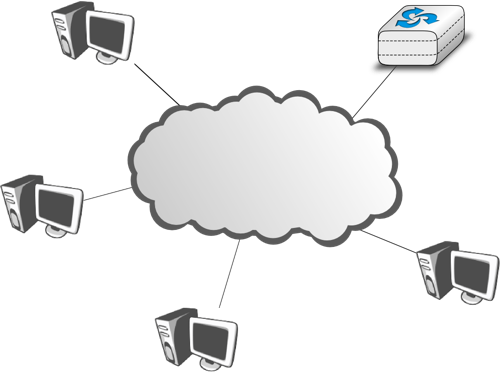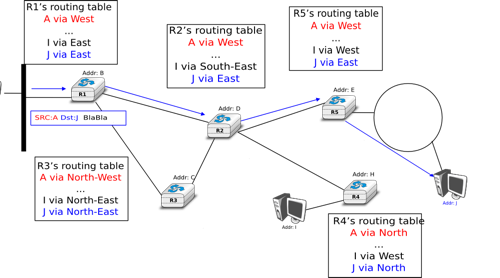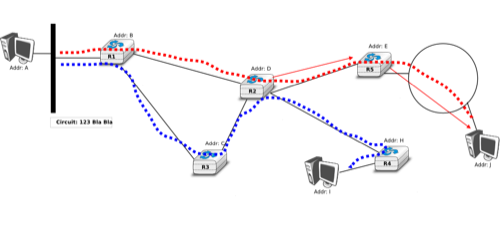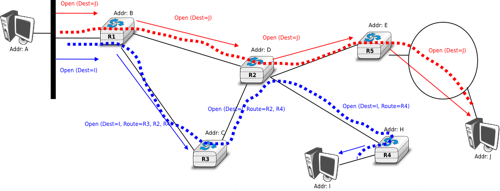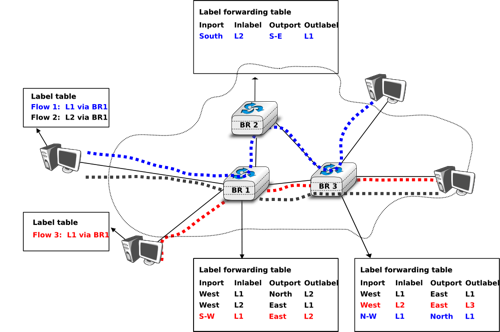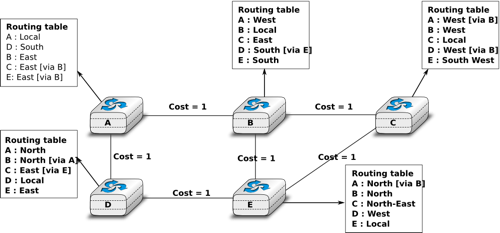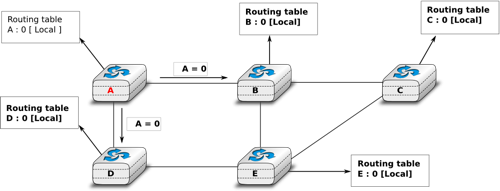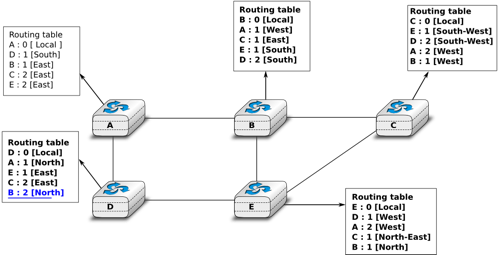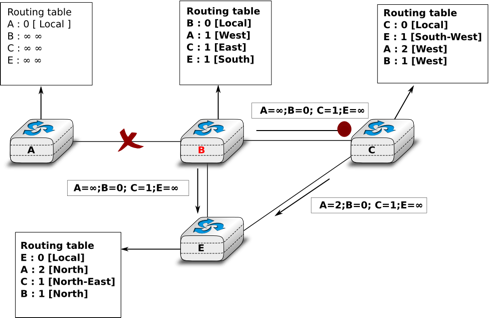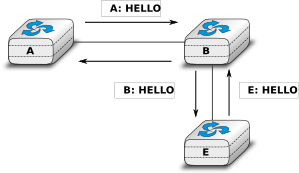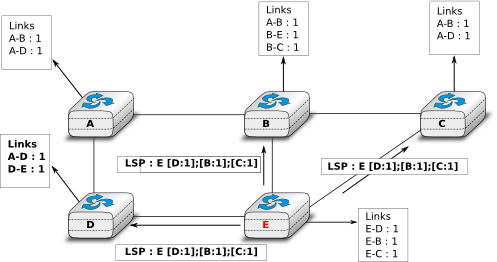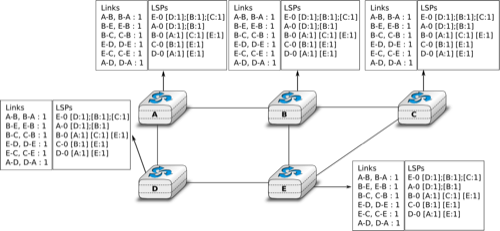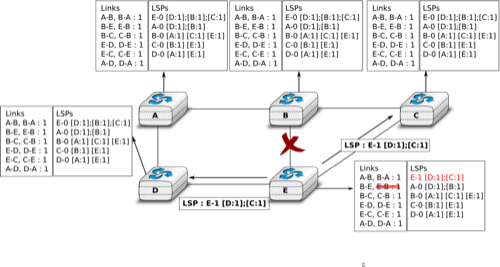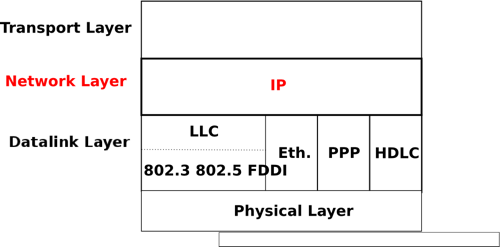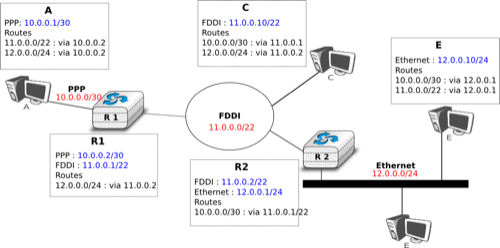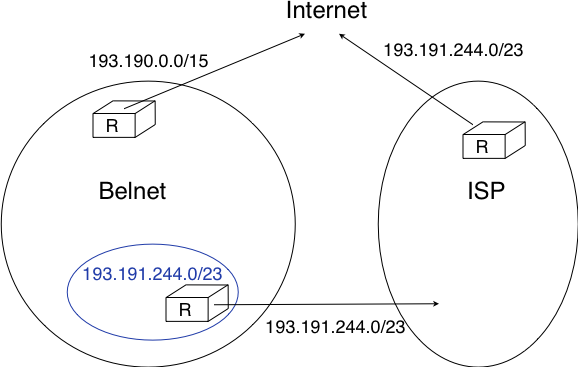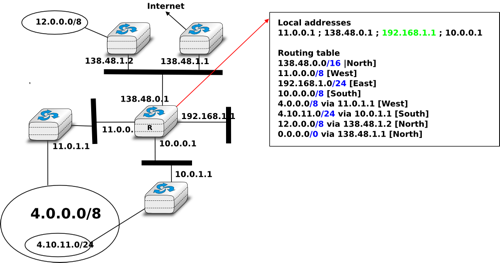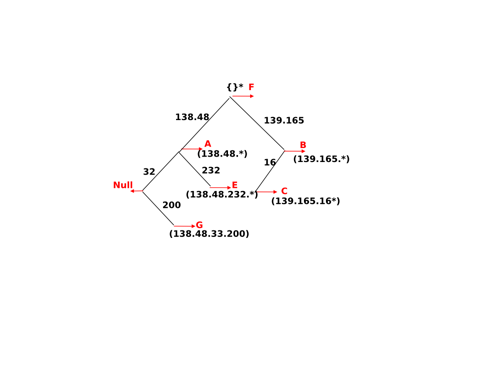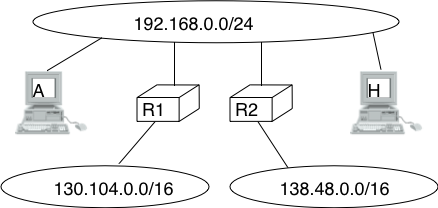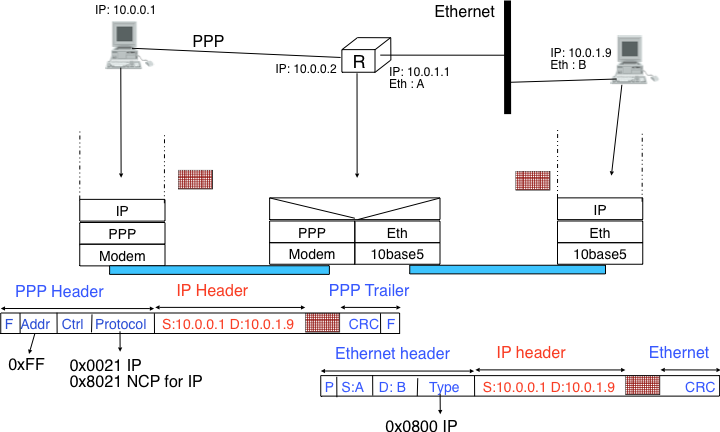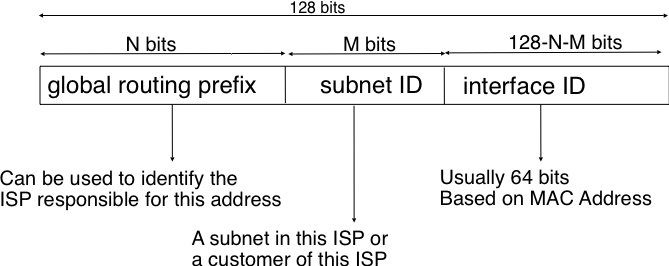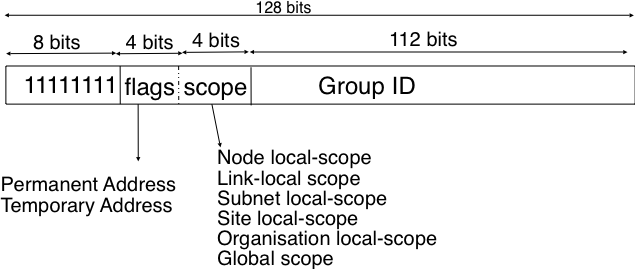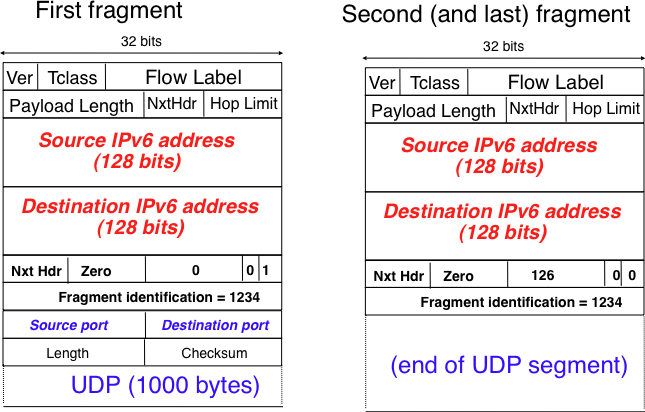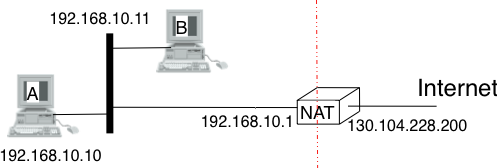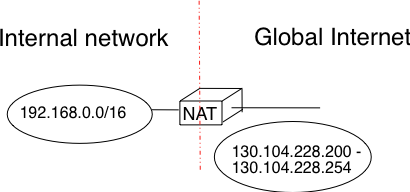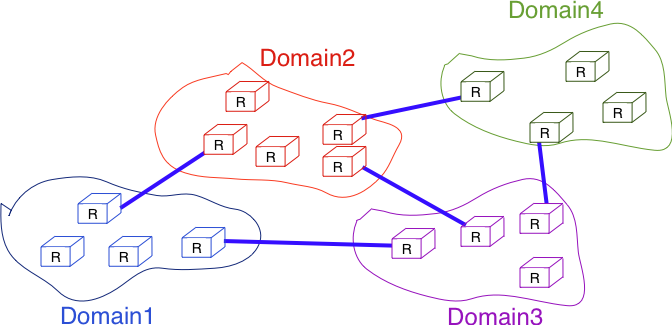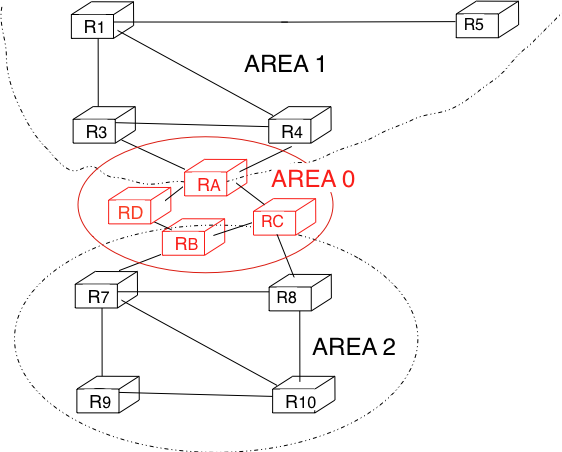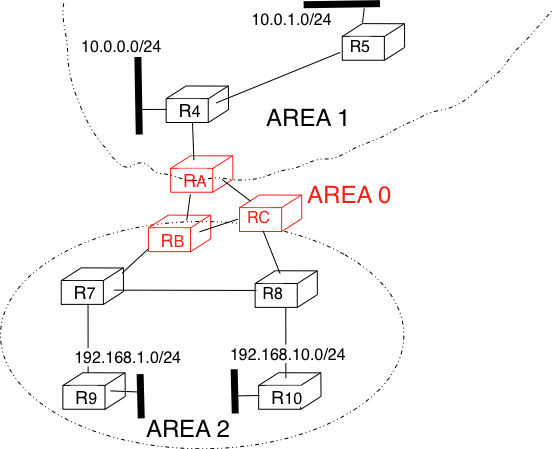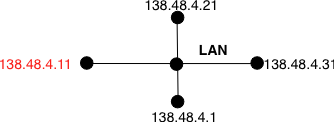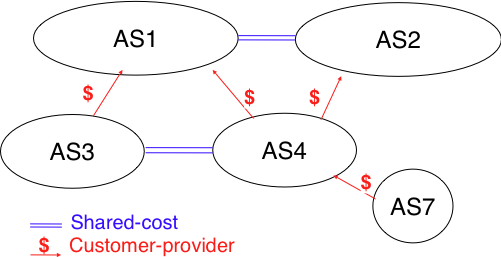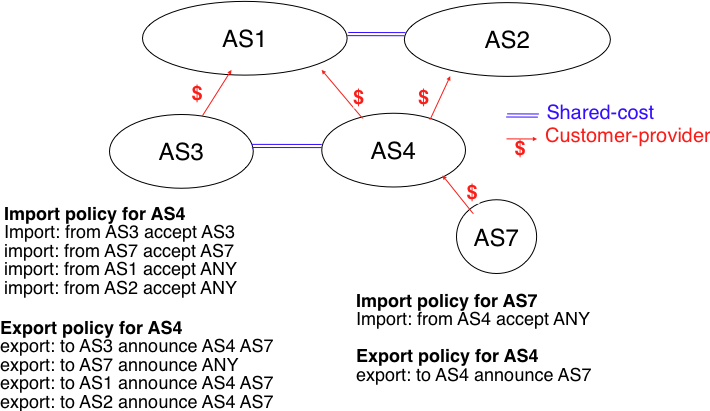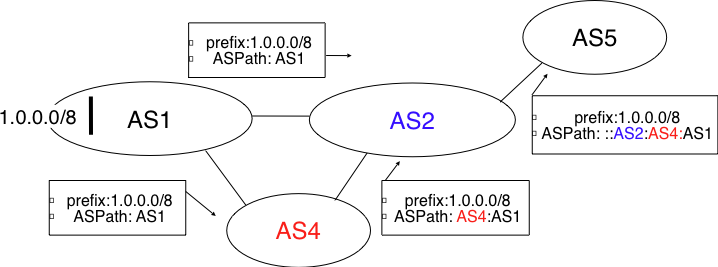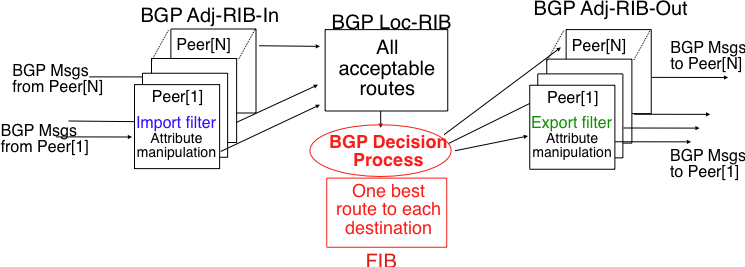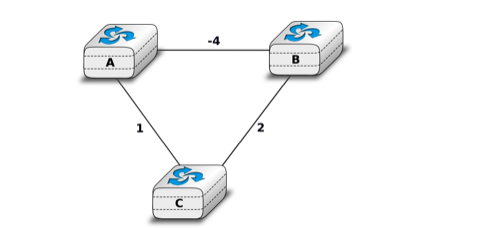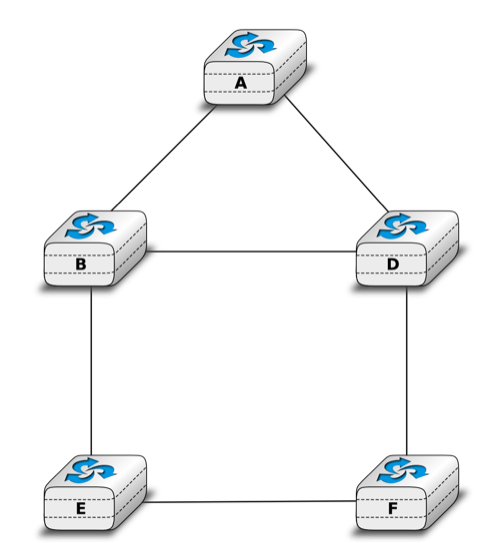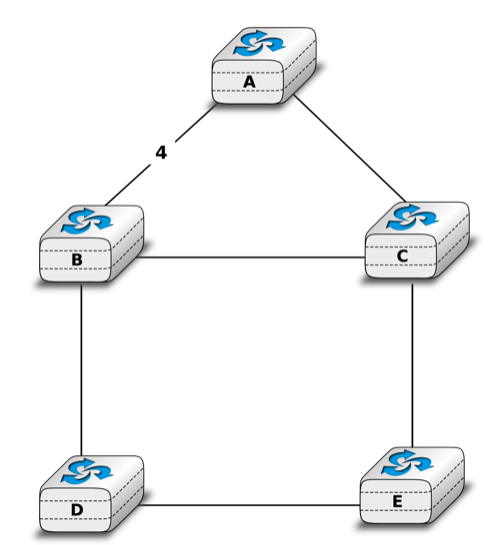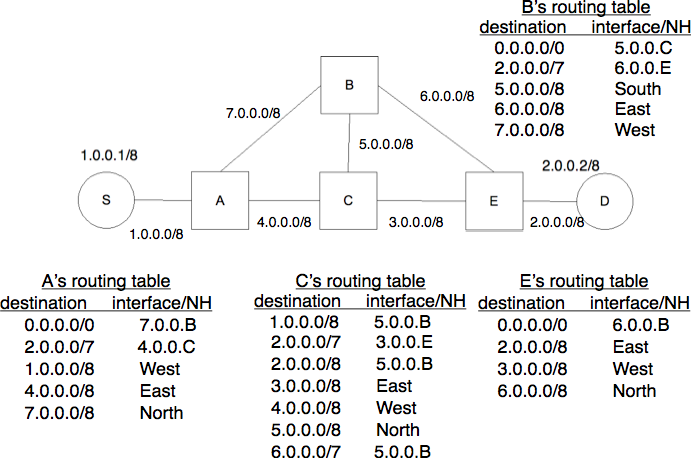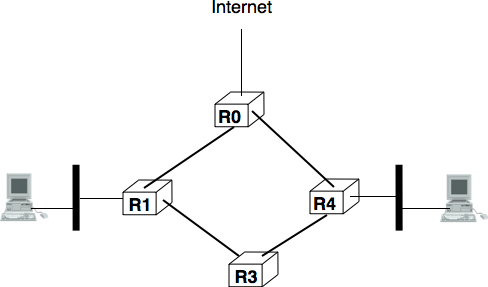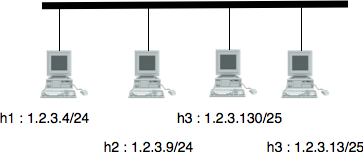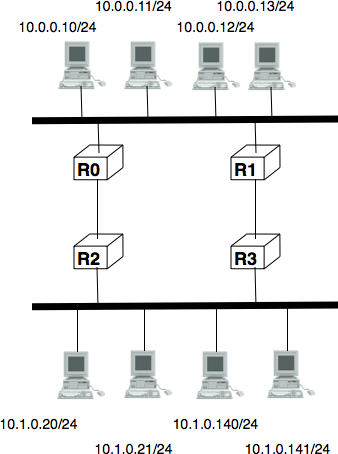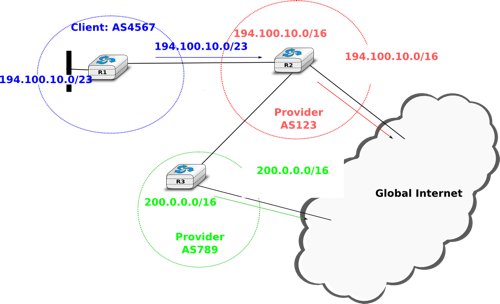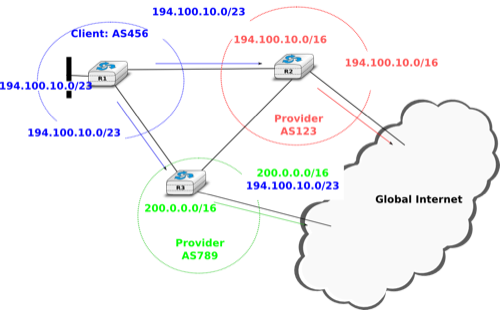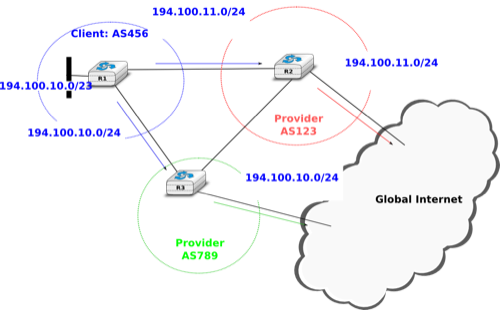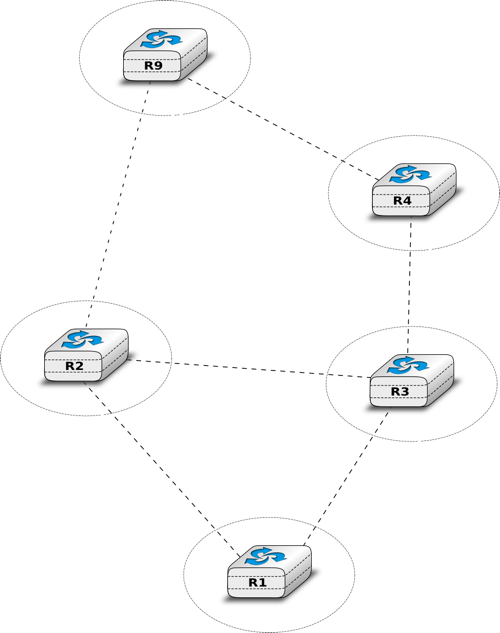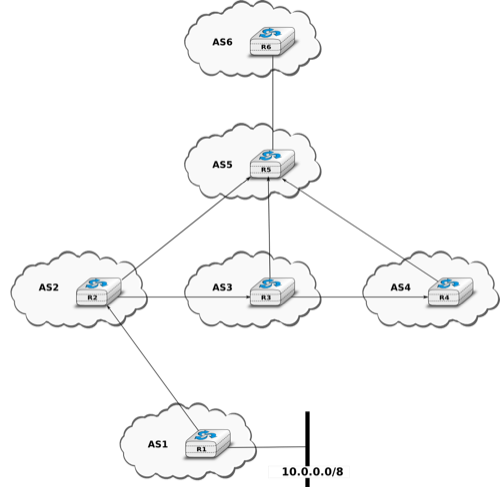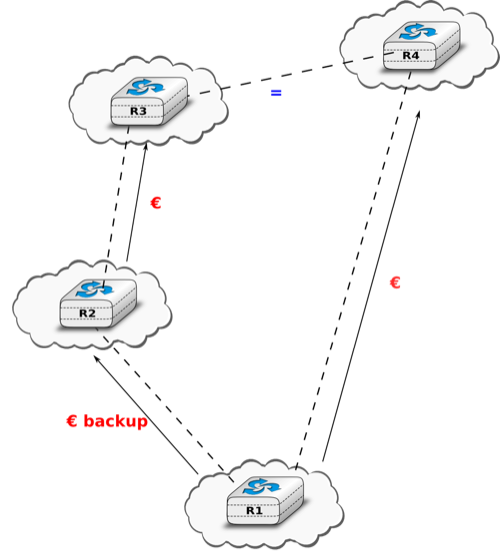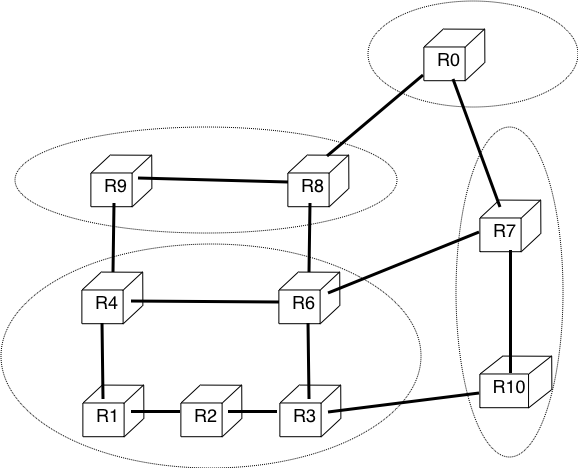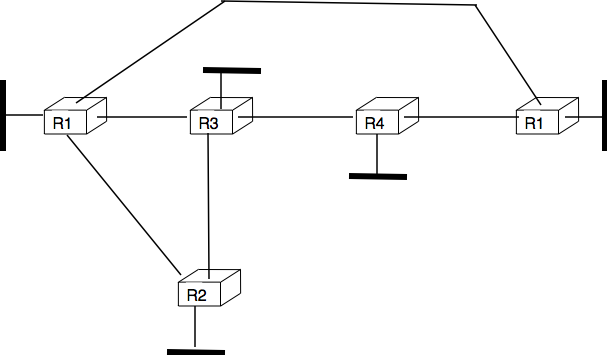The network layer¶
The transport layer enables the applications to efficiently and reliably exchange data. Transport layer entities expect to be able to send segment to any destination without having to understand anything about the underlying subnetwork technologies. Many subnetwork technologies exist. Most of them differ in subtle details (frame size, addressing, ...). The network layer is the glue between these subnetworks and the transport layer. It hides to the transport layer all the complexity of the underlying subnetworks and ensures that information can be exchanged between hosts connected to different types of subnetworks.
In this chapter, we first explain the principles of the network layer. These principles include the datagram and virtual circuit modes, the separation between the data plane and the control plane and the algorithms used by routing protocols. Then, we explain, in more detail, the network layer in the Internet, starting with IPv4 and IPv6 and then moving to the routing protocols (RIP, OSPF and BGP).
Principles¶
The main objective of the network layer is to allow endsystems, connected to different networks, to exchange information through intermediate systems called router. The unit of information in the network layer is called a packet.
Before explaining the network layer in detail, it is useful to begin by analysing the service provided by the datalink layer. There are many variants of the datalink layer. Some provide a connection-oriented service while others provide a connectionless service. In this section, we focus on connectionless datalink layer services as they are the most widely used. Using a connection-oriented datalink layer causes some problems that are beyond the scope of this chapter. See RFC 3819 for a discussion on this topic.
There are three main types of datalink layers. The simplest datalink layer is when there are only two communicating systems that are directly connected through the physical layer. Such a datalink layer is used when there is a point-to-point link between the two communicating systems. The two systems can be endsystems or routers. PPP, defined in RFC 1661, is an example of such a point-to-point datalink layer. Datalink layers exchange frames and a datalink frame sent by a datalink layer entity on the left is transmitted through the physical layer, so that it can reach the datalink layer entity on the right. Point-to-point datalink layers can either provide an unreliable service (frames can be corrupted or lost) or a reliable service (in this case, the datalink layer includes retransmission mechanisms similar to the ones used in the transport layer). The unreliable service is frequently used above physical layers (e.g. optical fiber, twisted pairs) having a low bit error ratio while reliability mechanisms are often used in wireless networks to recover locally from transmission errors.
The second type of datalink layer is the one used in Local Area Networks (LAN). Conceptually, a LAN is a set of communicating devices such that any two devices can directly exchange frames through the datalink layer. Both endsystems and routers can be connected to a LAN. Some LANs only connect a few devices, but there are LANs that can connect hundreds or even thousands of devices.
In the next chapter, we describe the organisation and the operation of Local Area Networks. An important difference between the point-to-point datalink layers and the datalink layers used in LANs is that in a LAN, each communicating device is identified by a unique datalink layer address. This address is usually embedded in the hardware of the device and different types of LANs use different types of datalink layer addresses. A communicating device attached to a LAN can send a datalink frame to any other communicating device that is attached to the same LAN. Most LANs also support special broadcast and multicast datalink layer addresses. A frame sent to the broadcast address of the LAN is delivered to all communicating devices that are attached to the LAN. The multicast addresses are used to identify groups of communicating devices. When a frame is sent towards a multicast datalink layer address, it is delivered by the LAN to all communicating devices that belong to the corresponding group.
The third type of datalink layers are used in Non-Broadcast Multi-Access (NBMA) networks. These networks are used to interconnect devices like a LAN. All devices attached to an NBMA network are identified by a unique datalink layer address. However, and this is the main difference between an NBMA network and a traditional LAN, the NBMA service only supports unicast. The datalink layer service provided by an NBMA network supports neither broadcast nor multicast.
Unfortunately no datalink layer is able to send frames of unlimited side. Each datalink layer is characterised by a maximum frame size. There are more than a dozen different datalink layers and unfortunately most of them use a different maximum frame size. The network layer must cope with the heterogeneity of the datalink layer.
The network layer itself relies on the following principles :
- Each network layer entity is identified by a network layer address. This address is independent of the datalink layer addresses that it may use.
- The service provided by the network layer does not depend on the service or the internal organisation of the underlying datalink layers.
- The network layer is conceptually divided into two planes : the data plane and the control plane. The data plane contains the protocols and mechanisms that allow hosts and routers to exchange packets carrying user data. The control plane contains the protocols and mechanisms that enable routers to efficiently learn how to forward packets towards their final destination.
The independence of the network layer from the underlying datalink layer is a key principle of the network layer. It ensures that the network layer can be used to allow hosts attached to different types of datalink layers to exchange packets through intermediate routers. Furthermore, this allows the datalink layers and the network layer to evolve independently from each other. This enables the network layer to be easily adapted to a new datalink layer every time a new datalink layer is invented.
There are two types of service that can be provided by the network layer :
- an unreliable connectionless service
- a connection-oriented, reliable or unreliable, service
Connection-oriented services have been popular with technologies such as X.25 and ATM or frame-relay, but nowadays most networks use an unreliable connectionless service. This is our main focus in this chapter.
Organisation of the network layer¶
There are two possible internal organisations of the network layer :
- datagram
- virtual circuits
The internal organisation of the network is orthogonal to the service that it provides, but most of the time a datagram organisation is used to provide a connectionless service while a virtual circuit organisation is used in networks that provide a connection-oriented service.
Datagram organisation¶
The first and most popular organisation of the network layer is the datagram organisation. This organisation is inspired by the organisation of the postal service. Each host is identified by a network layer address. To send information to a remote host, a host creates a packet that contains :
- the network layer address of the destination host
- its own network layer address
- the information to be sent
The network layer limits the maximum packet size. Thus, the information must have been divided in packets by the transport layer before being passed to the network layer.
To understand the datagram organisation, let us consider the figure below. A network layer address, represented by a letter, has been assigned to each host and router. To send some information to host J, host A creates a packet containing its own address, the destination address and the information to be exchanged.
With the datagram organisation, routers use hop-by-hop forwarding. This means that when a router receives a packet that is not destined to itself, it looks up the destination address of the packet in its routing table. A routing table is a data structure that maps each destination address (or set of destination addresses) to the outgoing interface over which a packet destined to this address must be forwarded to reach its final destination.
The main constraint imposed on the routing tables is that they must allow any host in the network to reach any other host. This implies that each router must know a route towards each destination, but also that the paths composed from the information stored in the routing tables must not contain loops. Otherwise, some destinations would be unreachable.
In the example above, host A sends its packet to router R1. R1 consults its routing table and forwards the packet towards R2. Based on its own routing table, R2 decides to forward the packet to R5 that can deliver it to its destination.
To allow hosts to exchange packets, a network relies on two different types of protocols and mechanisms. First, there must be a precise definition of the format of the packets that are sent by hosts and processed by routers. Second, the algorithm used by the routers to forward these packets must be defined. This protocol and this algorithm are part of the data plane of the network layer. The data plane contains all the protocols and algorithms that are used by hosts and routers to create and process the packets that contain user data.
The data plane, and in particular the forwarding algorithm used by the routers, depends on the routing tables that are maintained on reach router. These routing tables can be maintained by using various techniques (manual configuration, distributed protocols, centralised computation, etc). These techniques are part of the control plane of the network layer. The control plane contains all the protocols and mechanisms that are used to compute and install routing tables on the routers.
The datagram organisation has been very popular in computer networks. Datagram based network layers include IPv4 and IPv6 in the global Internet, CLNP defined by the ISO, IPX defined by Novell or XNS defined by Xerox [Perlman2000].
Virtual circuit organisation¶
The main advantage of the datagram organisation is its simplicity. The principles of this organisation can easily be understood. Furthermore, it allows a host to easily send a packet towards any destination at any time. However, as each packet is forwarded independently by intermediate routers, packets sent by a host may not follow the same path to reach a given destination. This may cause packet reordering, which may be annoying for transport protocols. Furthermore, as a router using hop-by-hop forwarding always forwards packets sent towards the same destination over the same outgoing interface, this may cause congestion over some links.
The second organisation of the network layer, called virtual circuits, has been inspired by the organisation of telephone networks. Telephone networks have been designed to carry phone calls that usually last a few minutes. Each phone is identified by a telephone number and is attached to a telephone switch. To initiate a phone call, a telephone first needs to send the destination’s phone number to its local switch. The switch cooperates with the other switches in the network to create a bi-directional channel between the two telephones through the network. This channel will be used by the two telephones during the lifetime of the call and will be released at the end of the call. Until the 1960s, most of these channels were created manually, by telephone operators, upon request of the caller. Today’s telephone networks use automated switches and allow several channels to be carried over the same physical link, but the principles remain roughly the same.
In a network using virtual circuits, all hosts are identified with a network layer address. However, a host must explicitly request the establishment of a virtual circuit before being able to send packets to a destination host. The request to establish a virtual circuit is processed by the control plane, which installs state to create the virtual circuit between the source and the destination through intermediate routers. All the packets that are sent on the virtual circuit contain a virtual circuit identifier that allows the routers to determine to which virtual circuit each packet belongs. This is illustrated in the figure below with one virtual circuit between host A and host I and another one between host A and host J.
The establishment of a virtual circuit is performed using a signalling protocol in the control plane. Usually, the source host sends a signalling message to indicate to its router the address of the destination and possibly some performance characteristics of the virtual circuit to be established. The first router can process the signalling message in two different ways.
A first solution is for the router to consult its routing table, remember the characteristics of the requested virtual circuit and forward it over its outgoing interface towards the destination. The signalling message is thus forwarded hop-by-hop until it reaches the destination and the virtual circuit is opened along the path followed by the signalling message. This is illustrated with the red virtual circuit in the figure below.
A second solution can be used if the routers know the entire topology of the network. In this case, the first router can use a technique called source routing. Upon reception of the signalling message, the first router chooses the path of the virtual circuit in the network. This path is encoded as the list of the addresses of all intermediate routers to reach the destination. It is included in the signalling message and intermediate routers can remove their address from the signalling message before forwarding it. This technique enables routers to spread the virtual circuits throughout the network better. If the routers know the load of remote links, they can also select the least loaded path when establishing a virtual circuit. This solution is illustrated with the blue circuit in the figure above.
The last point to be discussed about the virtual circuit organisation is its data plane. The data plane mainly defines the format of the data packets and the algorithm used by routers to forward packets. The data packets contain a virtual circuit identifier, encoded as a fixed number of bits. These virtual circuit identifiers are usually called labels.
Each host maintains a flow table that associates a label with each virtual circuit that is has established. When a router receives a packet containing a label, it extracts the label and consults its label forwarding table. This table is a data structure that maps each couple (incoming interface, label) to the outgoing interface to be used to forward the packet as well as the label that must be placed in the outgoing packets. In practice, the label forwarding table can be implemented as a vector and the couple (incoming interface, label) is the index of the entry in the vector that contains the outgoing interface and the outgoing label. Thus a single memory access is sufficient to consult the label forwarding table. The utilisation of the label forwarding table is illustrated in the figure below.
The virtual circuit organisation has been mainly used in public networks, starting from X.25 and then Frame Relay and Asynchronous Transfer Mode (ATM) network.
Both the datagram and virtual circuit organisations have advantages and drawbacks. The main advantage of the datagram organisation is that hosts can easily send packets to any number of destinations while the virtual circuit organisation requires the establishment of a virtual circuit before the transmission of a data packet. This solution can be costly for hosts that exchange small amounts of data. On the other hand, the main advantage of the virtual circuit organisation is that the forwarding algorithm used by routers is simpler than when using the datagram organisation. Furthermore, the utilisation of virtual circuits may allow the load to be better spread through the network thanks to the utilisation of multiple virtual circuits. The MultiProtocol Label Switching (MPLS) technique that we will discuss in another revision of this book can be considered as a good compromise between datagram and virtual circuits. MPLS uses virtual circuits between routers, but does not extend them to the endhosts. Additional information about MPLS may be found in [ML2011].
The control plane¶
One of the objectives of the control plane in the network layer is to maintain the routing tables that are used on all routers. As indicated earlier, a routing table is a data structure that contains, for each destination address (or block of addresses) known by the router, the outgoing interface over which the router must forward a packet destined to this address. The routing table may also contain additional information such as the address of the next router on the path towards the destination or an estimation of the cost of this path.
In this section, we discuss the three main techniques that can be used to maintain the routing tables in a network.
Static routing¶
The simplest solution is to pre-compute all the routing tables of all routers and to install them on each router. Several algorithms can be used to compute these tables.
A simple solution is to use shortest path routing and to minimise the number of intermediate routers to reach each destination. More complex algorithms can take into account the expected load on the links to ensure that congestion does not occur for a given traffic demand. These algorithms must all ensure that :
- all routers are configured with a route to reach each destination
- none of the paths composed with the entries found in the routing tables contain a cycle. Such a cycle would lead to a forwarding loop.
The figure below shows sample routing tables in a five routers network.
The main drawback of static routing is that it does not adapt to the evolution of the network. When a new router or link is added, all routing tables must be recomputed. Furthermore, when a link or router fails, the routing tables must be updated as well.
Distance vector routing¶
Distance vector routing is a simple distributed routing protocol. Distance vector routing allows routers to automatically discover the destinations reachable inside the network as well as the shortest path to reach each of these destinations. The shortest path is computed based on metrics or costs that are associated to each link. We use l.cost to represent the metric that has been configured for link l on a router.
Each router maintains a routing table. The routing table R can be modelled as a data structure that stores, for each known destination address d, the following attributes :
- R[d].link is the outgoing link that the router uses to forward packets towards destination d
- R[d].cost is the sum of the metrics of the links that compose the shortest path to reach destination d
- R[d].time is the timestamp of the last distance vector containing destination d
A router that uses distance vector routing regularly sends its distance vector over all its interfaces. The distance vector is a summary of the router’s routing table that indicates the distance towards each known destination. This distance vector can be computed from the routing table by using the pseudo-code below.
Every N seconds:
v=Vector()
for d in R[]:
# add destination d to vector
v.add(Pair(d,R[d].cost))
for i in interfaces
# send vector v on this interface
send(v,interface)
When a router boots, it does not know any destination in the network and its routing table only contains itself. It thus sends to all its neighbours a distance vector that contains only its address at a distance of 0. When a router receives a distance vector on link l, it processes it as follows.
# V : received Vector
# l : link over which vector is received
def received(V,l):
# received vector from link l
for d in V[]
if not (d in R[]) :
# new route
R[d].cost=V[d].cost+l.cost
R[d].link=l
R[d].time=now
else :
# existing route, is the new better ?
if ( ((V[d].cost+l.cost) < R[d].cost) or ( R[d].link == l) ) :
# Better route or change to current route
R[d].cost=V[d].cost+l.cost
R[d].link=l
R[d].time=now
The router iterates over all addresses included in the distance vector. If the distance vector contains an address that the router does not know, it inserts the destination inside its routing table via link l and at a distance which is the sum between the distance indicated in the distance vector and the cost associated to link l. If the destination was already known by the router, it only updates the corresponding entry in its routing table if either :
- the cost of the new route is smaller than the cost of the already known route ( (V[d].cost+l.cost) < R[d].cost)
- the new route was learned over the same link as the current best route towards this destination ( R[d].link == l)
The first condition ensures that the router discovers the shortest path towards each destination. The second condition is used to take into account the changes of routes that may occur after a link failure or a change of the metric associated to a link.
To understand the operation of a distance vector protocol, let us consider the network of five routers shown below.
Assume that A is the first to send its distance vector [A=0].
- B and D process the received distance vector and update their routing table with a route towards A.
- D sends its distance vector [D=0,A=1] to A and E. E can now reach A and D.
- C sends its distance vector [C=0] to B and E
- E sends its distance vector [E=0,D=1,A=2,C=2] to D, B and C. B can now reach A, C, D and E
- B sends its distance vector [B=0,A=1,C=1,D=2,E=1] to A, C and E. A, B, C and E can now reach all destinations.
- A sends its distance vector [A=0,B=1,C=2,D=1,E=2] to B and D.
At this point, all routers can reach all other routers in the network thanks to the routing tables shown in the figure below.
To deal with link and router failures, routers use the timestamp stored in their routing table. As all routers send their distance vector every N seconds, the timestamp of each route should be regularly refreshed. Thus no route should have a timestamp older than N seconds, unless the route is not reachable anymore. In practice, to cope with the possible loss of a distance vector due to transmission errors, routers check the timestamp of the routes stored in their routing table every N seconds and remove the routes that are older than  seconds. When a router notices that a route towards a destination has expired, it must first associate an
seconds. When a router notices that a route towards a destination has expired, it must first associate an  cost to this route and send its distance vector to its neighbours to inform them. The route can then be removed from the routing table after some time (e.g.
cost to this route and send its distance vector to its neighbours to inform them. The route can then be removed from the routing table after some time (e.g.  seconds), to ensure that the neighbouring routers have received the bad news, even if some distance vectors do not reach them due to transmission errors.
seconds), to ensure that the neighbouring routers have received the bad news, even if some distance vectors do not reach them due to transmission errors.
Consider the example above and assume that the link between routers A and B fails. Before the failure, A used B to reach destinations B, C and E while B only used the A-B link to reach A. The affected entries timeout on routers A and B and they both send their distance vector.
- A sends its distance vector
. D knows that it cannot reach B anymore via A
- D sends its distance vector
to A and E. A recovers routes towards C and E via D.
- B sends its distance vector
to E and C. D learns that there is no route anymore to reach A via B.
- E sends its distance vector
to D, B and C. D learns a route towards B. C and B learn a route towards A.
At this point, all routers have a routing table allowing them to reach all another routers, except router A, which cannot yet reach router B. A recovers the route towards B once router D sends its updated distance vector ![[A=1,B=2,C=2,D=1,E=1]](../_images/math/331db65f2d29c53c3ab7f8aed030f3258df7d478.png) . This last step is illustrated in figure Routing tables computed by distance vector after a failure, which shows the routing tables on all routers.
. This last step is illustrated in figure Routing tables computed by distance vector after a failure, which shows the routing tables on all routers.
Consider now that the link between D and E fails. The network is now partitioned into two disjoint parts : (A , D) and (B, E, C). The routes towards B, C and E expire first on router D. At this time, router D updates its routing table.
If D sends ![[D=0, A=1, B=\infty, C=\infty, E=\infty]](../_images/math/d3155926af4b38cbf2344fbe775d461aa3f09ce6.png) , A learns that B, C and E are unreachable and updates its routing table.
, A learns that B, C and E are unreachable and updates its routing table.
Unfortunately, if the distance vector sent to A is lost or if A sends its own distance vector ( ![[A=0,D=1,B=3,C=3,E=2]](../_images/math/1d488629b85327dc46f3644fcc506dd3ea08a115.png) ) at the same time as D sends its distance vector, D updates its routing table to use the shorter routes advertised by A towards B, C and E. After some time D sends a new distance vector :
) at the same time as D sends its distance vector, D updates its routing table to use the shorter routes advertised by A towards B, C and E. After some time D sends a new distance vector : ![[D=0,A=1,E=3,C=4,B=4]](../_images/math/380a400dac2b10048a19feb9e296ac9f850e605e.png) . A updates its routing table and after some time sends its own distance vector
. A updates its routing table and after some time sends its own distance vector ![[A=0,D=1,B=5,C=5,E=4]](../_images/math/1243335620b6c0b56cc8ed816ee2afec556e07ba.png) , etc. This problem is known as the count to infinity problem in networking literature. Routers A and D exchange distance vectors with increasing costs until these costs reach
, etc. This problem is known as the count to infinity problem in networking literature. Routers A and D exchange distance vectors with increasing costs until these costs reach  . This problem may occur in other scenarios than the one depicted in the above figure. In fact, distance vector routing may suffer from count to infinity problems as soon as there is a cycle in the network. Cycles are necessary to have enough redundancy to deal with link and router failures. To mitigate the impact of counting to infinity, some distance vector protocols consider that
. This problem may occur in other scenarios than the one depicted in the above figure. In fact, distance vector routing may suffer from count to infinity problems as soon as there is a cycle in the network. Cycles are necessary to have enough redundancy to deal with link and router failures. To mitigate the impact of counting to infinity, some distance vector protocols consider that  . Unfortunately, this limits the metrics that network operators can use and the diameter of the networks using distance vectors.
. Unfortunately, this limits the metrics that network operators can use and the diameter of the networks using distance vectors.
This count to infinity problem occurs because router A advertises to router D a route that it has learned via router D. A possible solution to avoid this problem could be to change how a router creates its distance vector. Instead of computing one distance vector and sending it to all its neighbors, a router could create a distance vector that is specific to each neighbour and only contains the routes that have not been learned via this neighbour. This could be implemented by the following pseudocode.
Every N seconds:
# one vector for each interface
for l in interfaces:
v=Vector()
for d in R[]:
if (R[d].link != i) :
v=v+Pair(d,R[d.cost])
send(v)
# end for d in R[]
#end for l in interfaces
This technique is called split-horizon. With this technique, the count to infinity problem would not have happened in the above scenario, as router A would have advertised ![[A=0]](../_images/math/bdece69f4c49068789fc9479732c5fdf8d26bb02.png) , since it learned all its other routes via router D. Another variant called split-horizon with poison reverse is also possible. Routers using this variant advertise a cost of
, since it learned all its other routes via router D. Another variant called split-horizon with poison reverse is also possible. Routers using this variant advertise a cost of  for the destinations that they reach via the router to which they send the distance vector. This can be implemented by using the pseudo-code below.
for the destinations that they reach via the router to which they send the distance vector. This can be implemented by using the pseudo-code below.
Every N seconds:
for l in interfaces:
# one vector for each interface
v=Vector()
for d in R[]:
if (R[d].link != i) :
v=v+Pair(d,R[d.cost])
else:
v=v+Pair(d,infinity);
send(v)
# end for d in R[]
#end for l in interfaces
Unfortunately, split-horizon, is not sufficient to avoid all count to infinity problems with distance vector routing. Consider the failure of link A-B in the network of four routers below.
After having detected the failure, router A sends its distance vectors :
to router C
to router E
If, unfortunately, the distance vector sent to router C is lost due to a transmission error or because router C is overloaded, a new count to infinity problem can occur. If router C sends its distance vector ![[A=2,B=1,C=0,E=\infty]](../_images/math/41650051395424177c208956628bec04b8b031e8.png) to router E, this router installs a route of distance 3 to reach A via C. Router E sends its distance vectors
to router E, this router installs a route of distance 3 to reach A via C. Router E sends its distance vectors ![[A=3,B=\infty,C=1,E=1]](../_images/math/bdd7a6b9b2beb9525395ec6630cc71871b136e6a.png) to router B and
to router B and ![[A=\infty,B=1,C=\infty,E=0]](../_images/math/f6266c56fe76ee7c020d4ac1b276d9202b4ffa55.png) to router C. This distance vector allows B to recover a route of distance 4 to reach A.
to router C. This distance vector allows B to recover a route of distance 4 to reach A.
Link state routing¶
Link state routing is the second family of routing protocols. While distance vector routers use a distributed algorithm to compute their routing tables, link-state routers exchange messages to allow each router to learn the entire network topology. Based on this learned topology, each router is then able to compute its routing table by using a shortest path computation [Dijkstra1959].
For link-state routing, a network is modelled as a directed weighted graph. Each router is a node, and the links between routers are the edges in the graph. A positive weight is associated to each directed edge and routers use the shortest path to reach each destination. In practice, different types of weight can be associated to each directed edge :
- unit weight. If all links have a unit weight, shortest path routing prefers the paths with the least number of intermediate routers.
- weight proportional to the propagation delay on the link. If all link weights are configured this way, shortest path routing uses the paths with the smallest propagation delay.
where C is a constant larger than the highest link bandwidth in the network. If all link weights are configured this way, shortest path routing prefers higher bandwidth paths over lower bandwidth paths
Usually, the same weight is associated to the two directed edges that correspond to a physical link (i.e.  and
and  ). However, nothing in the link state protocols requires this. For example, if the weight is set in function of the link bandwidth, then an asymmetric ADSL link could have a different weight for the upstream and downstream directions.
Other variants are possible. Some networks use optimisation algorithms to find the best set of weights to minimize congestion inside the network for a given traffic demand [FRT2002].
). However, nothing in the link state protocols requires this. For example, if the weight is set in function of the link bandwidth, then an asymmetric ADSL link could have a different weight for the upstream and downstream directions.
Other variants are possible. Some networks use optimisation algorithms to find the best set of weights to minimize congestion inside the network for a given traffic demand [FRT2002].
When a link-state router boots, it first needs to discover to which routers it is directly connected. For this, each router sends a HELLO message every N seconds on all of its interfaces. This message contains the router’s address. Each router has a unique address. As its neighbouring routers also send HELLO messages, the router automatically discovers to which neighbours it is connected. These HELLO messages are only sent to neighbours who are directly connected to a router, and a router never forwards the HELLO messages that they receive. HELLO messages are also used to detect link and router failures. A link is considered to have failed if no HELLO message has been received from the neighbouring router for a period of  seconds.
seconds.
Once a router has discovered its neighbours, it must reliably distribute its local links to all routers in the network to allow them to compute their local view of the network topology. For this, each router builds a link-state packet (LSP) containing the following information :
- LSP.Router : identification (address) of the sender of the LSP
- LSP.age : age or remaining lifetime of the LSP
- LSP.seq : sequence number of the LSP
- LSP.Links[] : links advertised in the LSP. Each directed link is represented with the following information : - LSP.Links[i].Id : identification of the neighbour - LSP.Links[i].cost : cost of the link
These LSPs must be reliably distributed inside the network without using the router’s routing table since these tables can only be computed once the LSPs have been received. The Flooding algorithm is used to efficiently distribute the LSPs of all routers. Each router that implements flooding maintains a link state database (LSDB) containing the most recent LSP sent by each router. When a router receives an LSP, it first verifies whether this LSP is already stored inside its LSDB. If so, the router has already distributed the LSP earlier and it does not need to forward it. Otherwise, the router forwards the LSP on all links except the link over which the LSP was received. Reliable flooding can be implemented by using the following pseudo-code.
# links is the set of all links on the router
# Router R's LSP arrival on link l
if newer(LSP, LSDB(LSP.Router)) :
LSDB.add(LSP)
for i in links :
if i!=l :
send(LSP,i)
else:
# LSP has already been flooded
In this pseudo-code, LSDB(r) returns the most recent LSP originating from router r that is stored in the LSDB. newer(lsp1,lsp2) returns true if lsp1 is more recent than lsp2. See the note below for a discussion on how newer can be implemented.
Note
Which is the most recent LSP ?
A router that implements flooding must be able to detect whether a received LSP is newer than the stored LSP. This requires a comparison between the sequence number of the received LSP and the sequence number of the LSP stored in the link state database. The ARPANET routing protocol [MRR1979] used a 6 bits sequence number and implemented the comparison as follows RFC 789
def newer( lsp1, lsp2 ):
return ( ( ( lsp1.seq > lsp2.seq) and ( (lsp1.seq-lsp2.seq)<=32) ) or
( ( lsp1.seq < lsp2.seq) and ( (lsp2.seq-lsp1.seq)> 32) ) )
This comparison takes into account the modulo  arithmetic used to increment the sequence numbers. Intuitively, the comparison divides the circle of all sequence numbers into two halves. Usually, the sequence number of the received LSP is equal to the sequence number of the stored LSP incremented by one, but sometimes the sequence numbers of two successive LSPs may differ, e.g. if one router has been disconnected from the network for some time. The comparison above worked well until October 27, 1980. On this day, the ARPANET crashed completely. The crash was complex and involved several routers. At one point, LSP 40 and LSP 44 from one of the routers were stored in the LSDB of some routers in the ARPANET. As LSP 44 was the newest, it should have replaced by LSP 40 on all routers. Unfortunately, one of the ARPANET routers suffered from a memory problem and sequence number 40 (101000 in binary) was replaced by 8 (001000 in binary) in the buggy router and flooded. Three LSPs were present in the network and 44 was newer than 40 which is newer than 8, but unfortunately 8 was considered to be newer than 44... All routers started to exchange these three link state packets for ever and the only solution to recover from this problem was to shutdown the entire network RFC 789.
arithmetic used to increment the sequence numbers. Intuitively, the comparison divides the circle of all sequence numbers into two halves. Usually, the sequence number of the received LSP is equal to the sequence number of the stored LSP incremented by one, but sometimes the sequence numbers of two successive LSPs may differ, e.g. if one router has been disconnected from the network for some time. The comparison above worked well until October 27, 1980. On this day, the ARPANET crashed completely. The crash was complex and involved several routers. At one point, LSP 40 and LSP 44 from one of the routers were stored in the LSDB of some routers in the ARPANET. As LSP 44 was the newest, it should have replaced by LSP 40 on all routers. Unfortunately, one of the ARPANET routers suffered from a memory problem and sequence number 40 (101000 in binary) was replaced by 8 (001000 in binary) in the buggy router and flooded. Three LSPs were present in the network and 44 was newer than 40 which is newer than 8, but unfortunately 8 was considered to be newer than 44... All routers started to exchange these three link state packets for ever and the only solution to recover from this problem was to shutdown the entire network RFC 789.
Current link state routing protocols usually use 32 bits sequence numbers and include a special mechanism in the unlikely case that a sequence number reaches the maximum value (using a 32 bits sequence number space takes 136 years if a link state packet is generated every second).
To deal with the memory corruption problem, link state packets contain a checksum. This checksum is computed by the router that generates the LSP. Each router must verify the checksum when it receives or floods an LSP. Furthermore, each router must periodically verify the checksums of the LSPs stored in its LSDB.
Flooding is illustrated in the figure below. By exchanging HELLO messages, each router learns its direct neighbours. For example, router E learns that it is directly connected to routers D, B and C. Its first LSP has sequence number 0 and contains the directed links E->D, E->B and E->C. Router E sends its LSP on all its links and routers D, B and C insert the LSP in their LSDB and forward it over their other links.
Flooding allows LSPs to be distributed to all routers inside the network without relying on routing tables. In the example above, the LSP sent by router E is likely to be sent twice on some links in the network. For example, routers B and C receive E‘s LSP at almost the same time and forward it over the B-C link. To avoid sending the same LSP twice on each link, a possible solution is to slightly change the pseudo-code above so that a router waits for some random time before forwarding a LSP on each link. The drawback of this solution is that the delay to flood an LSP to all routers in the network increases. In practice, routers immediately flood the LSPs that contain new information (e.g. addition or removal of a link) and delay the flooding of refresh LSPs (i.e. LSPs that contain exactly the same information as the previous LSP originating from this router) [FFEB2005].
To ensure that all routers receive all LSPs, even when there are transmissions errors, link state routing protocols use reliable flooding. With reliable flooding, routers use acknowledgements and if necessary retransmissions to ensure that all link state packets are successfully transferred to all neighbouring routers. Thanks to reliable flooding, all routers store in their LSDB the most recent LSP sent by each router in the network. By combining the received LSPs with its own LSP, each router can compute the entire network topology.
Note
Static or dynamic link metrics ?
As link state packets are flooded regularly, routers are able to measure the quality (e.g. delay or load) of their links and adjust the metric of each link according to its current quality. Such dynamic adjustments were included in the ARPANET routing protocol [MRR1979] . However, experience showed that it was difficult to tune the dynamic adjustments and ensure that no forwarding loops occur in the network [KZ1989]. Today’s link state routing protocols use metrics that are manually configured on the routers and are only changed by the network operators or network management tools [FRT2002].
When a link fails, the two routers attached to the link detect the failure by the lack of HELLO messages received in the last  seconds. Once a router has detected a local link failure, it generates and floods a new LSP that no longer contains the failed link and the new LSP replaces the previous LSP in the network. As the two routers attached to a link do not detect this failure exactly at the same time, some links may be announced in only one direction. This is illustrated in the figure below. Router E has detected the failures of link E-B and flooded a new LSP, but router B has not yet detected the failure.
seconds. Once a router has detected a local link failure, it generates and floods a new LSP that no longer contains the failed link and the new LSP replaces the previous LSP in the network. As the two routers attached to a link do not detect this failure exactly at the same time, some links may be announced in only one direction. This is illustrated in the figure below. Router E has detected the failures of link E-B and flooded a new LSP, but router B has not yet detected the failure.
When a link is reported in the LSP of only one of the attached routers, routers consider the link as having failed and they remove it from the directed graph that they compute from their LSDB. This is called the two-way connectivity check. This check allows link failures to be flooded quickly as a single LSP is sufficient to announce such bad news. However, when a link comes up, it can only be used once the two attached routers have sent their LSPs. The two-way connectivity check also allows for dealing with router failures. When a router fails, all its links fail by definition. Unfortunately, it does not, of course, send a new LSP to announce its failure. The two-way connectivity check ensures that the failed router is removed from the graph.
When a router has failed, its LSP must be removed from the LSDB of all routers [1]. This can be done by using the age field that is included in each LSP. The age field is used to bound the maximum lifetime of a link state packet in the network. When a router generates a LSP, it sets its lifetime (usually measured in seconds) in the age field. All routers regularly decrement the age of the LSPs in their LSDB and a LSP is discarded once its age reaches 0. Thanks to the age field, the LSP from a failed router does not remain in the LSDBs forever.
To compute its routing table, each router computes the spanning tree rooted at itself by using Dijkstra’s shortest path algorithm [Dijkstra1959]. The routing table can be derived automatically from the spanning as shown in the figure below.
Footnotes
| [1] | It should be noted that link state routing assumes that all routers in the network have enough memory to store the entire LSDB. The routers that do not have enough memory to store the entire LSDB cannot participate in link state routing. Some link state routing protocols allow routers to report that they do not have enough memory and must be removed from the graph by the other routers in the network. |
Internet Protocol¶
The Internet Protocol (IP) is the network layer protocol of the TCP/IP protocol suite. IP allows the applications running above the transport layer (UDP/TCP) to use a wide range of heterogeneous datalink layers. IP was designed when most point-to-point links were telephone lines with modems. Since then, IP has been able to use Local Area Networks (Ethernet, Token Ring, FDDI, ...), new wide area data link layer technologies (X.25, ATM, Frame Relay, ...) and more recently wireless networks (802.11, 802.15, UMTS, GPRS, ...). The flexibility of IP and its ability to use various types of underlying data link layer technologies is one of its key advantages.
The current version of IP is version 4 specified in RFC 791. We first describe this version and later explain IP version 6, which is expected to replace IP version 4 in the not so distant future.
IP version 4¶
IP version 4 is the data plane protocol of the network layer in the TCP/IP protocol suite. The design of IP version 4 was based on the following assumptions :
- IP should provide an unreliable connectionless service (TCP provides reliability when required by the application)
- IP operates with the datagram transmission mode
- IP addresses have a fixed size of 32 bits
- IP must be usable above different types of datalink layers
- IP hosts exchange variable length packets
The addresses are an important part of any network layer protocol. In the late 1970s, the developers of IPv4 designed IPv4 for a research network that would interconnect some research labs and universities. For this utilisation, 32 bits wide addresses were much larger than the expected number of hosts on the network. Furthermore, 32 bits was a nice address size for software-based routers. None of the developers of IPv4 were expecting that IPv4 would become as widely used as it is today.
IPv4 addresses are encoded as a 32 bits field. IPv4 addresses are often represented in dotted-decimal format as a sequence of four integers separated by a dot. The first integer is the decimal representation of the most significant byte of the 32 bits IPv4 address, ... For example,
- 1.2.3.4 corresponds to 00000001000000100000001100000100
- 127.0.0.1 corresponds to 01111111000000000000000000000001
- 255.255.255.255 corresponds to 11111111111111111111111111111111
An IPv4 address is used to identify an interface on a router or a host. A router has thus as many IPv4 addresses as the number of interfaces that it has in the datalink layer. Most hosts have a single datalink layer interface and thus have a single IPv4 address. However, with the growth of wireless, more and more hosts have several datalink layer interfaces (e.g. an Ethernet interface and a WiFi interface). These hosts are said to be multihomed. A multihomed host with two interfaces has thus two IPv4 addresses.
An important point to be defined in a network layer protocol is the allocation of the network layer addresses. A naive allocation scheme would be to provide an IPv4 address to each host when the host is attached to the Internet on a first come first served basis. With this solution, a host in Belgium could have address 2.3.4.5 while another host located in Africa would use address 2.3.4.6. Unfortunately, this would force all routers to maintain a specific route towards each host. The figure below shows a simple enterprise network with two routers and three hosts and the associated routing tables if such isolated addresses were used.
To preserve the scalability of the routing system, it is important to minimize the number of routes that are stored on each router. A router cannot store and maintain one route for each of the almost 1 billion hosts that are connected to today’s Internet. Routers should only maintain routes towards blocks of addresses and not towards individual hosts. For this, hosts are grouped in subnets based on their location in the network. A typical subnet groups all the hosts that are part of the same enterprise. An enterprise network is usually composed of several LANs interconnected by routers. A small block of addresses from the Enterprise’s block is usually assigned to each LAN. An IPv4 address is composed of two parts : a subnetwork identifier and a host identifier. The subnetwork identifier is composed of the high order bits of the address and the host identifier is encoded in the low order bits of the address. This is illustrated in the figure below.
When a router needs to forward a packet, it must know the subnet of the destination address to be able to consult its forwarding table to forward the packet. RFC 791 proposed to use the high-order bits of the address to encode the length of the subnet identifier. This led to the definition of three classes of unicast addresses [2]
| Class | High-order bits | Length of subnet id | Number of networks | Addresses per network |
|---|---|---|---|---|
| Class A | 0 | 8 bits | 128 | 16,777,216 ( ) ) |
| Class B | 10 | 16 bits | 16,384 | 65,536 ( ) ) |
| Class C | 110 | 24 bits | 2,097,152 | 256 ( ) ) |
However, these three classes of addresses were not flexible enough. A class A subnet was too large for most organisations and a class C subnet was too small. Flexibility was added by the introduction of variable-length subnets in RFC 1519. With variable-length subnets, the subnet identifier can be any size, from 1 to 31 bits. Variable-length subnets allow the network operators to use a subnet that better matches the number of hosts that are placed inside the subnet. A subnet identifier or IPv4 prefix is usually [3] represented as A.B.C.D/p where A.B.C.D is the network address obtained by concatenating the subnet identifier with a host identifier containing only 0 and p is the length of the subnet identifier in bits. The table below provides examples of IP subnets.
| Subnet | Number of addresses | Smallest address | Highest address |
|---|---|---|---|
| 10.0.0.0/8 | 16,777,216 | 10.0.0.0 | 10.255.255.255 |
| 192.168.0.0/16 | 65,536 | 192.168.0.0 | 192.168.255.255 |
| 198.18.0.0/15 | 131,072 | 198.18.0.0 | 198.19.255.255 |
| 192.0.2.0/24 | 256 | 192.0.2.0 | 192.0.2.255 |
| 10.0.0.0/30 | 4 | 10.0.0.0 | 10.0.0.3 |
| 10.0.0.0/31 | 2 | 10.0.0.0 | 10.0.0.1 |
The figure below provides a simple example of the utilisation of IPv4 subnets in an enterprise network. The length of the subnet identifier assigned to a LAN usually depends on the expected number of hosts attached to the LAN. For point-to-point links, many deployments have used /30 prefixes, but recent routers are now using /31 subnets on point-to-point links RFC 3021 or do not even use IPv4 addresses on such links [4].
A second issue concerning the addresses of the network layer is the allocation scheme that is used to allocate blocks of addresses to organisations. The first allocation scheme was based on the different classes of addresses. The pool of IPv4 addresses was managed by a secretariat who allocated address blocks on a first-come first served basis. Large organisations such as IBM, BBN, as well as Stanford or the MIT were able to obtain a class A address block. Most organisations requested a class B address block containing 65536 addresses, which was suitable for most enterprises and universities. The table below provides examples of some IPv4 address blocks in the class B space.
| Subnet | Organisation |
| 130.100.0.0/16 | Ericsson, Sweden |
| 130.101.0.0/16 | University of Akron, USA |
| 130.102.0.0/16 | The University of Queensland, Australia |
| 130.103.0.0/16 | Lotus Development, USA |
| 130.104.0.0/16 | Universite catholique de Louvain, Belgium |
| 130.105.0.0/16 | Open Software Foundation, USA |
However, the Internet was a victim of its own success and in the late 1980s, many organisations were requesting blocks of IPv4 addresses and started connecting to the Internet. Most of these organisations requested class B address blocks, as class A address blocks were too large and in limited supply while class C address blocks were considered to be too small. Unfortunately, there were only 16,384 different class B address blocks and this address space was being consumed quickly. As a consequence, the routing tables maintained by the routers were growing quickly and some routers had difficulties maintaining all these routes in their limited memory [11].
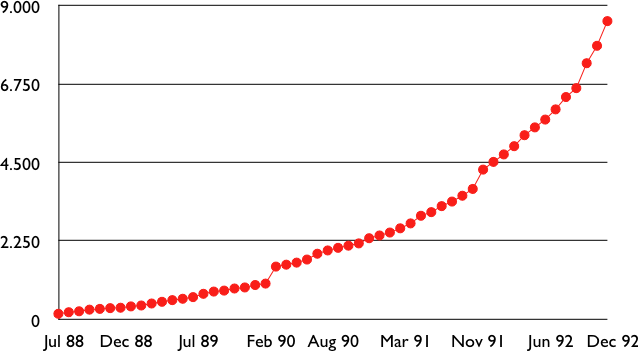
Evolution of the size of the routing tables on the Internet (Jul 1988- Dec 1992 - source : RFC 1518)
Faced with these two problems, the Internet Engineering Task Force decided to develop the Classless Interdomain Routing (CIDR) architecture RFC 1518. This architecture aims at allowing IP routing to scale better than the class-based architecture. CIDR contains three important modifications compared to RFC 791.
- IP address classes are deprecated. All IP equipment must use and support variable-length subnets.
- IP address blocks are no longer allocated on a first-come-first-served basis. Instead, CIDR introduces a hierarchical address allocation scheme.
- IP routers must use longest-prefix match when they lookup a destination address in their forwarding table
The last two modifications were introduced to improve the scalability of the IP routing system. The main drawback of the first-come-first-served address block allocation scheme was that neighbouring address blocks were allocated to very different organisations and conversely, very different address blocks were allocated to similar organisations. With CIDR, address blocks are allocated by Regional IP Registries (RIR) in an aggregatable manner. A RIR is responsible for a large block of addresses and a region. For example, RIPE is the RIR that is responsible for Europe. A RIR allocates smaller address blocks from its large block to Internet Service Providers RFC 2050. Internet Service Providers then allocate smaller address blocks to their customers. When an organisation requests an address block, it must prove that it already has or expects to have in the near future, a number of hosts or customers that is equivalent to the size of the requested address block.
The main advantage of this hierarchical address block allocation scheme is that it allows the routers to maintain fewer routes. For example, consider the address blocks that were allocated to some of the Belgian universities as shown in the table below.
| Address block | Organisation |
|---|---|
| 130.104.0.0/16 | Universite catholique de Louvain |
| 134.58.0.0/16 | Katholiek Universiteit Leuven |
| 138.48.0.0/16 | Facultes universitaires Notre-Dame de la Paix |
| 139.165.0.0/16 | Universite de Liege |
| 164.15.0.0/16 | Universite Libre de Bruxelles |
These universities are all connected to the Internet exclusively via Belnet. As each university has been allocated a different address block, the routers of Belnet must announce one route for each university and all routers on the Internet must maintain a route towards each university. In contrast, consider all the high schools and the government institutions that are connected to the Internet via Belnet. An address block was assigned to these institutions after the introduction of CIDR in the 193.190.0.0/15 address block owned by Belnet. With CIDR, Belnet can announce a single route towards 193.190.0.0/15 that covers all of these high schools.
However, there is one difficulty with the aggregatable variable length subnets used by CIDR. Consider for example FEDICT, a government institution that uses the 193.191.244.0/23 address block. Assume that in addition to being connected to the Internet via Belnet , FEDICT also wants to be connected to another Internet Service Provider. The FEDICT network is then said to be multihomed. This is shown in the figure below.
With such a multihomed network, routers R1 and R2 would have two routes towards IPv4 address 193.191.245.88 : one route via Belnet (193.190.0.0/15) and one direct route (193.191.244.0/23). Both routes match IPv4 address 193.191.145.88. Since RFC 1519 when a router knows several routes towards the same destination address, it must forward packets along the route having the longest prefix length. In the case of 193.191.245.88, this is the route 193.191.244.0/23 that is used to forward the packet. This forwarding rule is called the longest prefix match or the more specific match. All IPv4 routers implement this forwarding rule.
To understand the longest prefix match forwarding, consider the figure below. With this rule, the route 0.0.0.0/0 plays a particular role. As this route has a prefix length of 0 bits, it matches all destination addresses. This route is often called the default route.
- a packet with destination 192.168.1.1 received by router R is destined to the router itself. It is delivered to the appropriate transport protocol.
- a packet with destination 11.2.3.4 matches two routes : 11.0.0.0/8 and 0.0.0.0/0. The packet is forwarded on the West interface.
- a packet with destination 130.4.3.4 matches one route : 0.0.0.0/0. The packet is forwarded on the North interface.
- a packet with destination 4.4.5.6 matches two routes : 4.0.0.0/8 and 0.0.0.0/0. The packet is forwarded on the West interface.
- a packet with destination 4.10.11.254 matches three routes : 4.0.0.0/8, 4.10.11.0/24 and `0.0.0.0/0. The packet is forwarded on the South interface.
The longest prefix match can be implemented by using different data structures. One possibility is to use a trie. The figure below shows a trie that encodes six routes having different outgoing interfaces.
Note
Special IPv4 addresses
Most unicast IPv4 addresses can appear as source and destination addresses in packets on the global Internet. However, it is worth noting that some blocks of IPv4 addresses have a special usage, as described in RFC 5735. These include :
- 0.0.0.0/8, which is reserved for self-identification. A common address in this block is 0.0.0.0, which is sometimes used when a host boots and does not yet know its IPv4 address.
- 127.0.0.0/8, which is reserved for loopback addresses. Each host implementing IPv4 must have a loopback interface (that is not attached to a datalink layer). By convention, IPv4 address 127.0.0.1 is assigned to this interface. This allows processes running on a host to use TCP/IP to contact other processes running on the same host. This can be very useful for testing purposes.
- 10.0.0.0/8, 172.16.0.0/12 and 192.168.0.0/16 are reserved for private networks that are not directly attached to the Internet. These addresses are often called private addresses or RFC 1918 addresses.
- 169.254.0.0/16 is used for link-local addresses RFC 3927. Some hosts use an address in this block when they are connected to a network that does not allocate addresses as expected.
IPv4 packets¶
Now that we have clarified the allocation of IPv4 addresses and the utilisation of the longest prefix match to forward IPv4 packets, we can have a more detailed look at IPv4 by starting with the format of the IPv4 packets. The IPv4 packet format was defined in RFC 791. Apart from a few clarifications and some backward compatible changes, the IPv4 packet format did not change significantly since the publication of RFC 791. All IPv4 packets use the 20 bytes header shown below. Some IPv4 packets contain an optional header extension that is described later.
The main fields of the IPv4 header are :
- a 4 bits version that indicates the version of IP used to build the header. Using a version field in the header allows the network layer protocol to evolve.
- a 4 bits IP Header Length (IHL) that indicates the length of the IP header in 32 bits words. This field allows IPv4 to use options if required, but as it is encoded as a 4 bits field, the IPv4 header cannot be longer than 64 bytes.
- an 8 bits DS field that is used for Quality of Service and whose usage is described later.
- an 8 bits Protocol field that indicates the transport layer protocol that must process the packet’s payload at the destination. Common values for this field [5] are 6 for TCP and 17 for UDP
- a 16 bits length field that indicates the total length of the entire IPv4 packet (header and payload) in bytes. This implies that an IPv4 packet cannot be longer than 65535 bytes.
- a 32 bits source address field that contains the IPv4 address of the source host
- a 32 bits destination address field that contains the IPv4 address of the destination host
- a 16 bits checksum that protects only the IPv4 header against transmission errors
The other fields of the IPv4 header are used for specific purposes. The first is the 8 bits Time To Live (TTL) field. This field is used by IPv4 to avoid the risk of having an IPv4 packet caught in an infinite loop due to a transient or permanent error in routing tables [6]. Consider for example the situation depicted in the figure below where destination D uses address 11.0.0.56. If S sends a packet towards this destination, the packet is forwarded to router B which forwards it to router C that forwards it back to router A, etc.
Unfortunately, such loops can occur for two reasons in IP networks. First, if the network uses static routing, the loop can be caused by a simple configuration error. Second, if the network uses dynamic routing, such a loop can occur transiently, for example during the convergence of the routing protocol after a link or router failure. The TTL field of the IPv4 header ensures that even if there are forwarding loops in the network, packets will not loop forever. Hosts send their IPv4 packets with a positive TTL (usually 64 or more [7]). When a router receives an IPv4 packet, it first decrements the TTL by one. If the TTL becomes 0, the packet is discarded and a message is sent back to the packet’s source (see section ICMP). Otherwise, the router performs a lookup in its forwarding table to forward the packet.
A second problem for IPv4 is the heterogeneity of the datalink layer. IPv4 is used above many very different datalink layers. Each datalink layer has its own characteristics and as indicated earlier, each datalink layer is characterised by a maximum frame size. From IP’s point of view, a datalink layer interface is characterised by its Maximum Transmission Unit (MTU). The MTU of an interface is the largest IPv4 packet (including header) that it can send. The table below provides some common MTU sizes [8].
| Datalink layer | MTU |
| Ethernet | 1500 bytes |
| WiFi | 2272 bytes |
| ATM (AAL5) | 9180 bytes |
| 802.15.4 | 102 or 81 bytes |
| Token Ring | 4464 bytes |
| FDDI | 4352 bytes |
Although IPv4 can send 64 KBytes long packets, few datalink layer technologies that are used today are able to send a 64 KBytes IPv4 packet inside a frame. Furthermore, as illustrated in the figure below, another problem is that a host may send a packet that would be too large for one of the datalink layers used by the intermediate routers.
To solve these problems, IPv4 includes a packet fragmentation and reassembly mechanism. Both hosts and intermediate routers may fragment an IPv4 packet if the packet is too long to be sent via the datalink layer. In IPv4, fragmentation is completely performed in the IP layer and a large IPv4 is fragmented into two or more IPv4 packets (called fragments). The IPv4 fragments of a large packet are normal IPv4 packets that are forwarded towards the destination of the large packet by intermediate routers.
The IPv4 fragmentation mechanism relies on four fields of the IPv4 header : Length, Identification, the flags and the Fragment Offset. The IPv4 header contains two flags : More fragments and Don’t Fragment (DF). When the DF flag is set, this indicates that the packet cannot be fragmented.
The basic operation of the IPv4 fragmentation is as follows. A large packet is fragmented into two or more fragments. The size of all fragments, except the last one, is equal to the Maximum Transmission Unit of the link used to forward the packet. Each IPv4 packet contains a 16 bits Identification field. When a packet is fragmented, the Identification of the large packet is copied in all fragments to allow the destination to reassemble the received fragments together. In each fragment, the Fragment Offset indicates, in units of 8 bytes, the position of the payload of the fragment in the payload of the original packet. The Length field in each fragment indicates the length of the payload of the fragment as in a normal IPv4 packet. Finally, the More fragments flag is set only in the last fragment of a large packet.
The following pseudo-code details the IPv4 fragmentation, assuming that the packet does not contain options.
#mtu : maximum size of the packet (including header) of outgoing link
if p.len < mtu :
send(p)
# packet is too large
maxpayload=8*int((mtu-20)/8) # must be n times 8 bytes
if p.flags=='DF' :
discard(p)
# packet must be fragmented
payload=p[IP].payload
pos=0
while len(payload) > 0 :
if len(payload) > maxpayload :
toSend=IP(dest=p.dest,src=p.src,
ttl=p.ttl, id=p.id,
frag=p.frag+(pos/8),
len=mtu, proto=p.proto)/payload[0:maxpayload]
pos=pos+maxpayload
payload=payload[maxpayload+1:]
else
toSend=IP(dest=p.dest,src=p.src,
ttl=p.ttl, id=p.id,
frag=p.frag+(pos/8),
flags=p.flags,
len=len(payload), proto=p.proto)/payload
forward(toSend)
The fragments of an IPv4 packet may arrive at the destination in any order, as each fragment is forwarded independently in the network and may follow different paths. Furthermore, some fragments may be lost and never reach the destination.
The reassembly algorithm used by the destination host is roughly as follows. First, the destination can verify whether a received IPv4 packet is a fragment or not by checking the value of the More fragments flag and the Fragment Offset. If the Fragment Offset is set to 0 and the More fragments flag is reset, the received packet has not been fragmented. Otherwise, the packet has been fragmented and must be reassembled. The reassembly algorithm relies on the Identification field of the received fragments to associate a fragment with the corresponding packet being reassembled. Furthermore, the Fragment Offset field indicates the position of the fragment payload in the original unfragmented packet. Finally, the packet with the More fragments flag reset allows the destination to determine the total length of the original unfragmented packet.
Note that the reassembly algorithm must deal with the unreliability of the IP network. This implies that a fragment may be duplicated or a fragment may never reach the destination. The destination can easily detect fragment duplication thanks to the Fragment Offset. To deal with fragment losses, the reassembly algorithm must bound the time during which the fragments of a packet are stored in its buffer while the packet is being reassembled. This can be implemented by starting a timer when the first fragment of a packet is received. If the packet has not been reassembled upon expiration of the timer, all fragments are discarded and the packet is considered to be lost.
The original IP specification, in RFC 791, defined several types of options that can be added to the IP header. Each option is encoded using a type length value format. They are not widely used today and are thus only briefly described. Additional details may be found in RFC 791.
The most interesting options in IPv4 are the three options that are related to routing. The Record route option was defined to allow network managers to determine the path followed by a packet. When the Record route option was present, routers on the packet’s path had to insert their IP address in the option. This option was implemented, but as the optional part of the IPv4 header can only contain 44 bytes, it is impossible to discover an entire path on the global Internet. traceroute(8), despite its limitations, is a better solution to record the path towards a destination.
The other routing options are the Strict source route and the Loose source route option. The main idea behind these options is that a host may want, for any reason, to specify the path to be followed by the packets that it sends. The Strict source route option allows a host to indicate inside each packet the exact path to be followed. The Strict source route option contains a list of IPv4 address and a pointer to indicate the next address in the list. When a router receives a packet containing this option, it does not lookup the destination address in its routing table but forwards the packet directly to the next router in the list and advances the pointer. This is illustrated in the figure below where S forces its packets to follow the RA-RB-RD path.
The maximum length of the optional part of the IPv4 header is a severe limitation for the Strict source route option as for the Record Route option. The Loose source route option does not suffer from this limitation. This option allows the sending host to indicate inside its packet some of the routers that must be traversed to reach the destination. This is shown in the figure below. S sends a packet containing a list of addresses and a pointer to the next router in the list. Initially, this pointer points to RB. When RA receives the packet sent by S, it looks up in its forwarding table the address pointed in the Loose source route option and not the destination address. The packet is then forwarded to router RB that recognises its address in the option and advances the pointer. As there is no address listed in the Loose source route option anymore, RB and other downstream routers forward the packet by performing a lookup for the destination address.
These two options are usually ignored by routers because they cause security problems RFC 6274.
ICMP version 4¶
It is sometimes necessary for intermediate routers or the destination host to inform the sender of the packet of a problem that occurred while processing a packet. In the TCP/IP protocol suite, this reporting is done by the Internet Control Message Protocol (ICMP). ICMP is defined in RFC 792. ICMP messages are carried as the payload of IP packets (the protocol value reserved for ICMP is 1). An ICMP message is composed of an 8 byte header and a variable length payload that usually contains the first bytes of the packet that triggered the transmission of the ICMP message.
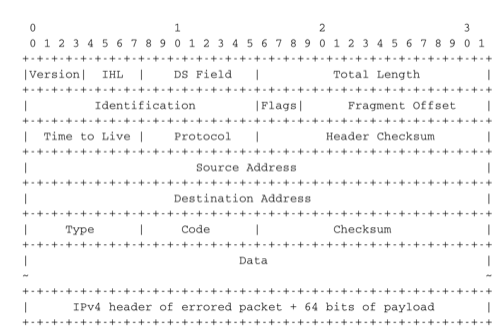
ICMP version 4 (RFC 792)
In the ICMP header, the Type and Code fields indicate the type of problem that was detected by the sender of the ICMP message. The Checksum protects the entire ICMP message against transmission errors and the Data field contains additional information for some ICMP messages.
The main types of ICMP messages are :
- Destination unreachable : a Destination unreachable ICMP message is sent when a packet cannot be delivered to its destination due to routing problems. Different types of unreachability are distinguished :
- Network unreachable : this ICMP message is sent by a router that does not have a route for the subnet containing the destination address of the packet
- Host unreachable : this ICMP message is sent by a router that is attached to the subnet that contains the destination address of the packet, but this destination address cannot be reached at this time
- Protocol unreachable : this ICMP message is sent by a destination host that has received a packet, but does not support the transport protocol indicated in the packet’s Protocol field
- Port unreachable : this ICMP message is sent by a destination host that has received a packet destined to a port number, but no server process is bound to this port
- Fragmentation needed : this ICMP message is sent by a router that receives a packet with the Don’t Fragment flag set that is larger than the MTU of the outgoing interface
- Redirect : this ICMP message can be sent when there are two routers on the same LAN. Consider a LAN with one host and two routers : R1 and R2. Assume that R1 is also connected to subnet 130.104.0.0/16 while R2 is connected to subnet 138.48.0.0/16. If a host on the LAN sends a packet towards 130.104.1.1 to R2, R2 needs to forward the packet again on the LAN to reach R1. This is not optimal as the packet is sent twice on the same LAN. In this case, R2 could send an ICMP Redirect message to the host to inform it that it should have sent the packet directly to R1. This allows the host to send the other packets to 130.104.1.1 directly via R1.
- Parameter problem : this ICMP message is sent when a router or a host receives an IP packet containing an error (e.g. an invalid option)
- Source quench : a router was supposed to send this message when it had to discard packets due to congestion. However, sending ICMP messages in case of congestion was not the best way to reduce congestion and since the inclusion of a congestion control scheme in TCP, this ICMP message has been deprecated.
- Time Exceeded : there are two types of Time Exceeded ICMP messages
- TTL exceeded : a TTL exceeded message is sent by a router when it discards an IPv4 packet because its TTL reached 0.
- Reassembly time exceeded : this ICMP message is sent when a destination has been unable to reassemble all the fragments of a packet before the expiration of its reassembly timer.
- Echo request and Echo reply : these ICMP messages are used by the ping(8) network debugging software.
Note
Redirection attacks
ICMP redirect messages are useful when several routers are attached to the same LAN as hosts. However, they should be used with care as they also create an important security risk. One of the most annoying attacks in an IP network is called the man in the middle attack. Such an attack occurs if an attacker is able to receive, process, possibly modify and forward all the packets exchanged between a source and a destination. As the attacker receives all the packets it can easily collect passwords or credit card numbers or even inject fake information in an established TCP connection. ICMP redirects unfortunately enable an attacker to easily perform such an attack. In the figure above, consider host H that is attached to the same LAN as A and R1. If H sends to A an ICMP redirect for prefix 138.48.0.0/16, A forwards to H all the packets that it wants to send to this prefix. H can then forward them to R2. To avoid these attacks, hosts should ignore the ICMP redirect messages that they receive.
ping(8) is often used by network operators to verify that a given IP address is reachable. Each host is supposed [9] to reply with an ICMP Echo reply message when its receives an ICMP Echo request message. A sample usage of ping(8) is shown below.
ping 130.104.1.1
PING 130.104.1.1 (130.104.1.1): 56 data bytes
64 bytes from 130.104.1.1: icmp_seq=0 ttl=243 time=19.961 ms
64 bytes from 130.104.1.1: icmp_seq=1 ttl=243 time=22.072 ms
64 bytes from 130.104.1.1: icmp_seq=2 ttl=243 time=23.064 ms
64 bytes from 130.104.1.1: icmp_seq=3 ttl=243 time=20.026 ms
64 bytes from 130.104.1.1: icmp_seq=4 ttl=243 time=25.099 ms
--- 130.104.1.1 ping statistics ---
5 packets transmitted, 5 packets received, 0% packet loss
round-trip min/avg/max/stddev = 19.961/22.044/25.099/1.938 ms
Another very useful debugging tool is traceroute(8). The traceroute man page describes this tool as “print the route packets take to network host”. traceroute uses the TTL exceeded ICMP messages to discover the intermediate routers on the path towards a destination. The principle behind traceroute is very simple. When a router receives an IP packet whose TTL is set to 1 it decrements the TTL and is forced to return to the sending host a TTL exceeded ICMP message containing the header and the first bytes of the discarded IP packet. To discover all routers on a network path, a simple solution is to first send a packet whose TTL is set to 1, then a packet whose TTL is set to 2, etc. A sample traceroute output is shown below.
traceroute www.ietf.org
traceroute to www.ietf.org (64.170.98.32), 64 hops max, 40 byte packets
1 CsHalles3.sri.ucl.ac.be (192.168.251.230) 5.376 ms 1.217 ms 1.137 ms
2 CtHalles.sri.ucl.ac.be (192.168.251.229) 1.444 ms 1.669 ms 1.301 ms
3 CtPythagore.sri.ucl.ac.be (130.104.254.230) 1.950 ms 4.688 ms 1.319 ms
4 fe.m20.access.lln.belnet.net (193.191.11.9) 1.578 ms 1.272 ms 1.259 ms
5 10ge.cr2.brueve.belnet.net (193.191.16.22) 5.461 ms 4.241 ms 4.162 ms
6 212.3.237.13 (212.3.237.13) 5.347 ms 4.544 ms 4.285 ms
7 ae-11-11.car1.Brussels1.Level3.net (4.69.136.249) 5.195 ms 4.304 ms 4.329 ms
8 ae-6-6.ebr1.London1.Level3.net (4.69.136.246) 8.892 ms 8.980 ms 8.830 ms
9 ae-100-100.ebr2.London1.Level3.net (4.69.141.166) 8.925 ms 8.950 ms 9.006 ms
10 ae-41-41.ebr1.NewYork1.Level3.net (4.69.137.66) 79.590 ms
ae-43-43.ebr1.NewYork1.Level3.net (4.69.137.74) 78.140 ms
ae-42-42.ebr1.NewYork1.Level3.net (4.69.137.70) 77.663 ms
11 ae-2-2.ebr1.Newark1.Level3.net (4.69.132.98) 78.290 ms 83.765 ms 90.006 ms
12 ae-14-51.car4.Newark1.Level3.net (4.68.99.8) 78.309 ms 78.257 ms 79.709 ms
13 ex1-tg2-0.eqnwnj.sbcglobal.net (151.164.89.249) 78.460 ms 78.452 ms 78.292 ms
14 151.164.95.190 (151.164.95.190) 157.198 ms 160.767 ms 159.898 ms
15 ded-p10-0.pltn13.sbcglobal.net (151.164.191.243) 161.872 ms 156.996 ms 159.425 ms
16 AMS-1152322.cust-rtr.swbell.net (75.61.192.10) 158.735 ms 158.485 ms 158.588 ms
17 mail.ietf.org (64.170.98.32) 158.427 ms 158.502 ms 158.567 ms
The above traceroute(8) output shows a 17 hops path between a host at UCLouvain and one of the main IETF servers. For each hop, traceroute provides the IPv4 address of the router that sent the ICMP message and the measured round-trip-time between the source and this router. traceroute sends three probes with each TTL value. In some cases, such as at the 10th hop above, the ICMP messages may be received from different addresses. This is usually because different packets from the same source have followed different paths [10] in the network.
Another important utilisation of ICMP messages is to discover the maximum MTU that can be used to reach a destination without fragmentation. As explained earlier, when an IPv4 router receives a packet that is larger than the MTU of the outgoing link, it must fragment the packet. Unfortunately, fragmentation is a complex operation and routers cannot perform it at line rate [KM1995]. Furthermore, when a TCP segment is transported in an IP packet that is fragmented in the network, the loss of a single fragment forces TCP to retransmit the entire segment (and thus all the fragments). If TCP was able to send only packets that do not require fragmentation in the network, it could retransmit only the information that was lost in the network. In addition, IP reassembly causes several challenges at high speed as discussed in RFC 4963. Using IP fragmentation to allow UDP applications to exchange large messages raises several security issues [KPS2003].
ICMP, combined with the Don’t fragment (DF) IPv4 flag, is used by TCP implementations to discover the largest MTU size that is allowed to reach a destination host without causing network fragmentation. This is the Path MTU discovery mechanism defined in RFC 1191. A TCP implementation that includes Path MTU discovery (most do) requests the IPv4 layer to send all segments inside IPv4 packets having the DF flag set. This prohibits intermediate routers from fragmenting these packets. If a router needs to forward an unfragmentable packet over a link with a smaller MTU, it returns a Fragmentation needed ICMP message to the source, indicating the MTU of its outgoing link. This ICMP message contains in the MTU of the router’s outgoing link in its Data field. Upon reception of this ICMP message, the source TCP implementation adjusts its Maximum Segment Size (MSS) so that the packets containing the segments that it sends can be forwarded by this router without requiring fragmentation.
Interactions between IPv4 and the datalink layer¶
As mentioned in the first section of this chapter, there are three main types of datalink layers : point-to-point links, LANs supporting broadcast and multicast and NBMA networks. There are two important issues to be addressed when using IPv4 in these types of networks. The first issue is how an IPv4 device obtains its IPv4 address. The second issue is how IPv4 packets are exchanged over the datalink layer service.
On a point-to-point link, the IPv4 addresses of the communicating devices can be configured manually or by using a simple protocol. IPv4 addresses are often configured manually on point-to-point links between routers. When point-to-point links are used to attach hosts to the network, automatic configuration is often preferred in order to avoid problems with incorrect IPv4 addresses. For example, the PPP, specified in RFC 1661, includes an IP network control protocol that can be used by the router in the figure below to send the IPv4 address that the attached host must configure for its interface. The transmission of IPv4 packets on a point-to-point link will be discussed in chapter chap:lan.
Using IPv4 in a LAN introduces an additional problem. On a LAN, each device is identified by its unique datalink layer address. The datalink layer service can be used by any host attached to the LAN to send a frame to any other host attached to the same LAN. For this, the sending host must know the datalink layer address of the destination host. For example, the figure below shows four hosts attached to the same LAN configured with IPv4 addresses in the 10.0.1.0/24 subnet and datalink layer addresses represented as a single character [12]. In this network, if host 10.0.1.22/24 wants to send an IPv4 packet to the host having address 10.0.1.8, it must know that the datalink layer address of this host is C.
In a simple network such as the one shown above, it could be possible to manually configure the mapping between the IPv4 addresses of the hosts and the corresponding datalink layer addresses. However, in a larger LAN this is impossible. To ease the utilisation of LANs, IPv4 hosts must be able to automatically obtain the datalink layer address corresponding to any IPv4 address on the same LAN. This is the objective of the Address Resolution Protocol (ARP) defined in RFC 826. ARP is a datalink layer protocol that is used by IPv4. It relies on the ability of the datalink layer service to easily deliver a broadcast frame to all devices attached to the same LAN.
The easiest way to understand the operation of ARP is to consider the simple network shown above and assume that host 10.0.1.22/24 needs to send an IPv4 packet to host 10.0.1.8. As this IP address belongs to the same subnet, the packet must be sent directly to its destination via the datalink layer service. To use this service, the sending host must find the datalink layer address that is attached to host 10.0.1.8. Each IPv4 host maintains an ARP cache containing the list of all mappings between IPv4 addresses and datalink layer addresses that it knows. When an IPv4 hosts boots, its ARP cache is empty. 10.0.1.22 thus first consults its ARP cache. As the cache does not contain the requested mapping, host 10.0.1.22 sends a broadcast ARP query frame on the LAN. The frame contains the datalink layer address of the sending host (A) and the requested IPv4 address (10.0.1.8). This broadcast frame is received by all devices on the LAN and only the host that owns the requested IPv4 address replies by returning a unicast ARP reply frame with the requested mapping. Upon reception of this reply, the sending host updates its ARP cache and sends the IPv4 packet by using the datalink layer service. To deal with devices that move or whose addresses are reconfigured, most ARP implementations remove the cache entries that have not been used for a few minutes. Some implementations re-validate ARP cache entries from time to time by sending ARP queries [13].
Note
Security issues with the Address Resolution Protocol
ARP is an old and widely used protocol that was unfortunately designed when security issues were not a concern. ARP is almost insecure by design. Hosts using ARP can be subject to several types of attack. First, a malicious host could create a denial of service attack on a LAN by sending random replies to the received ARP queries. This would pollute the ARP cache of the other hosts on the same LAN. On a fixed network, such attacks can be detected by the system administrator who can physically remove the malicious hosts from the LAN. On a wireless network, removing a malicious host is much more difficult.
A second type of attack are the man-in-the-middle attacks. This name is used for network attacks where the attacker is able to read and possibly modify all the messages sent by the attacked devices. Such an attack is possible in a LAN. Assume, in the figure above, that host 10.0.1.9 is malicious and would like to receive and modify all the packets sent by host 10.0.1.22 to host 10.0.1.8. This can be achieved easily if host 10.0.1.9 manages, by sending fake ARP replies, to convince host 10.0.1.22 (resp. 10.0.1.8) that its own datalink layer address must be used to reach 10.0.1.8 (resp. 10.0.1.22).
ARP is used by all devices that are connected to a LAN and implement IPv4. Both routers and endhosts implement ARP. When a host needs to send an IPv4 packet to a destination outside of its local subnet, it must first send the packet to one of the routers that reside on this subnet. Consider for example the network shown in the figure below. Each host is configured with an IPv4 address in the 10.0.1.0/24 subnet and uses 10.0.1.1 as its default router. To send a packet to address 1.2.3.4, host 10.0.1.8 will first need to know the datalink layer of the default router. It will thus send an ARP request for 10.0.1.1. Upon reception of the ARP reply, host 10.0.1.8 updates its ARP table and sends its packet in a frame to its default router. The router will then forward the packet towards its final destination.
In the early days of the Internet, IP addresses were manually configured on both hosts and routers and almost never changed. However, this manual configuration can be complex [14] and often causes errors that are sometimes difficult to debug. Recent TCP/IP implementations are able to detect some of these misconfigurations. For example, if two hosts are attached to the same subnet with the same IPv4 address they will be unable to communicate. To detect this problem hosts send an ARP request for their configured address each time their addressed is changed RFC 5227. If they receive an answer to this ARP request, they trigger an alarm or inform the system administrator.
To ease the attachment of hosts to subnets, most networks now support the Dynamic Host Configuration Protocol (DHCP) RFC 2131. DHCP allows a host to automatically retrieve its assigned IPv4 address. A DHCP server is associated to each subnet [15]. Each DHCP server manages a pool of IPv4 addresses assigned to the subnet. When a host is first attached to the subnet, it sends a DHCP request message in a UDP segment (the DHCP server listens on port 67). As the host knows neither its IPv4 address nor the IPv4 address of the DHCP server, this UDP segment is sent inside an IPv4 packet whose source and destination addresses are respectively 0.0.0.0 and 255.255.255.255. The DHCP request may contain various options such as the name of the host, its datalink layer address, etc. The server captures the DHCP request and selects an unassigned address in its address pool. It then sends the assigned IPv4 address in a DHCP reply message which contains the datalink layer address of the host and additional information such as the subnet mask of the IPv4 address, the address of the default router or the address of the DNS resolver. This DHCP reply message is sent in an IPv4 packet whose source and destination addresses are respectively the IPv4 address of the DHCP server and the 255.255.255.255 broadcast address. The DHCP reply also specifies the lifetime of the address allocation. This forces the host to renew its address allocation once it expires. Thanks to the limited lease time, IP addresses are automatically returned to the pool of addresses hosts are powered off. This reduces the waste of IPv4 addresses.
In an NBMA network, the interactions between IPv4 and the datalink layer are more complex as the ARP protocol cannot be used as in a LAN. Such NBMA networks use special servers that store the mappings between IP addresses and the corresponding datalink layer address. Asynchronous Transfer Mode (ATM) networks for example can use either the ATMARP protocol defined in RFC 2225 or the NextHop Resolution Protocol (NHRP) defined in RFC 2332. ATM networks are less frequently used today and we will not describe the detailed operation of these servers.
Operation of IPv4 devices¶
At this point of the description of IPv4, it is useful to have a detailed look at how an IPv4 implementation sends, receives and forwards IPv4 packets. The simplest case is when a host needs to send a segment in an IPv4 packet. The host performs two operations. First, it must decide on which interface the packet will be sent. Second it must create the corresponding IP packet(s).
To simplify the discussion in this section, we ignore the utilisation of IPv4 options. This is not a severe limitation as today IPv4 packets rarely contain options. Details about the processing of the IPv4 options may be found in the relevant RFCs, such as RFC 791. Furthermore, we also assume that only point-to-point links are used. We defer the explanation of the operation of IPv4 over Local Area Networks until the next chapter.
An IPv4 host having  datalink layer interfaces manages
datalink layer interfaces manages  IPv4 addresses :
IPv4 addresses :
- the 127.0.0.1/32 IPv4 address assigned by convention to its loopback address
- one A.B.C.D/p IPv4 address assigned to each of its
datalink layer interfaces
Such a host maintains a routing table containing one entry for its loopback address and one entry for each subnet identifier assigned to its interfaces. Furthermore, the host usually uses one of its interfaces as the default interface when sending packets that are not addressed to a directly connected destination. This is represented by the default route : 0.0.0.0/0 that is associated to one interface.
When a transport protocol running on the host requests the transmission of a segment, it usually provides the IPv4 destination address to the IPv4 layer in addition to the segment [16]. The IPv4 implementation first performs a longest prefix match with the destination address in its routing table. The lookup returns the identification of the interface that must be used to send the packet. The host can then create the IPv4 packet containing the segment. The source IPv4 address of the packet is the IPv4 address of the host on the interface returned by the longest prefix match. The Protocol field of the packet is set to the identification of the local transport protocol which created the segment. The TTL field of the packet is set to the default TTL used by the host. The host must now choose the packet’s Identification. This Identification is important if the packet becomes fragmented in the network, as it ensures that the destination is able to reassemble the received fragments. Ideally, a sending host should never send a packet twice with the same Identification to the same destination host, in order to ensure that all fragments are correctly reassembled by the destination. Unfortunately, with a 16 bits Identification field and an expected MSL of 2 minutes, this implies that the maximum bandwidth to a given destination is limited to roughly 286 Mbps. With a more realistic 1500 bytes MTU, that bandwidth drops to 6.4 Mbps RFC 4963 if fragmentation must be possible [17]. This is very low and is another reason why hosts are highly encouraged to avoid fragmentation. If; despite all of this, the MTU of the outgoing interface is smaller than the packet’s length, the packet is fragmented. Finally, the packet’s checksum is computed before transmission.
When a host receives an IPv4 packet destined to itself, there are several operations that it must perform. First, it must check the packet’s checksum. If the checksum is incorrect, the packet is discarded. Then, it must check whether the packet has been fragmented. If yes, the packet is passed to the reassembly algorithm described earlier. Otherwise, the packet must be passed to the upper layer. This is done by looking at the Protocol field (6 for TCP, 17 for UDP). If the host does not implement the transport layer protocol corresponding to the received Protocol field, it sends a Protocol unreachable ICMP message to the sending host. If the received packet contains an ICMP message (Protocol field set to 1), the processing is more complex. An Echo-request ICMP message triggers the transmission of an ICMP Echo-reply message. The other types of ICMP messages indicate an error that was caused by a previously transmitted packet. These ICMP messages are usually forwarded to the transport protocol that sent the erroneous packet. This can be done by inspecting the contents of the ICMP message that includes the header and the first 64 bits of the erroneous packet. If the IP packet did not contain options, which is the case for most IPv4 packets, the transport protocol can find in the first 32 bits of the transport header the source and destination ports to determine the affected transport flow. This is important for Path MTU discovery for example.
When a router receives an IPv4 packet, it must first check the packet’s checksum. If the checksum is invalid, it is discarded. Otherwise, the router must check whether the destination address is one of the IPv4 addresses assigned to the router. If so, the router must behave as a host and process the packet as described above. Although routers mainly forward IPv4 packets, they sometimes need to be accessed as hosts by network operators or network management software.
If the packet is not addressed to the router, it must be forwarded on an outgoing interface according to the router’s routing table. The router first decrements the packet’s TTL. If the TTL reaches 0, a TTL Exceeded ICMP message is sent back to the source. As the packet header has been modified, the checksum must be recomputed. Fortunately, as IPv4 uses an arithmetic checksum, a router can incrementally update the packet’s checksum as described in RFC 1624. Then, the router performs a longest prefix match for the packet’s destination address in its forwarding table. If no match is found, the router must return a Destination unreachable ICMP message to the source. Otherwise, the lookup returns the interface over which the packet must be forwarded. Before forwarding the packet over this interface, the router must first compare the length of the packet with the MTU of the outgoing interface. If the packet is smaller than the MTU, it is forwarded. Otherwise, a Fragmentation needed ICMP message is sent if the DF flag was sent or the packet is fragmented if the DF was not set.
Note
Longest prefix match in IP routers
Performing the longest prefix match at line rate on routers requires highly tuned data structures and algorithms. Consider for example an implementation of the longest match based on a Radix tree on a router with a 10 Gbps link. On such a link, a router can receive 31,250,000 40 bytes IPv4 packets every second. To forward the packets at line rate, the router must process one IPv4 packet every 32 nanoseconds. This cannot be achieved by a software implementation. For a hardware implementation, the main difficulty lies in the number of memory accesses that are necessary to perform the longest prefix match. 32 nanoseconds is very small compared to the memory accesses that are required by a naive longest prefix match implement. Additional information about faster longest prefix match algorithms may be found in [Varghese2005].
Footnotes
| [2] | In addition to the A, B and C classes, RFC 791 also defined the D and E classes of IPv4 addresses. Class D (resp. E) addresses are those whose high order bits are set to 1110 (resp. 1111). Class D addresses are used by IP multicast and will be explained later. Class E addresses are currently unused, but there are some discussions on possible future usages [WMH2008] [FLM2008] |
| [3] | Another way of representing IP subnets is to use netmasks. A netmask is a 32 bits field whose p high order bits are set to 1 and the low order bits are set to 0. The number of high order bits set 1 indicates the length of the subnet identifier. Netmasks are usually represented in the same dotted decimal format as IPv4 addresses. For example 10.0.0.0/8 would be represented as 10.0.0.0 255.0.0.0 while 192.168.1.0/24 would be represented as 192.168.1.0 255.255.255.0. In some cases, the netmask can be represented in hexadecimal. |
| [4] | A point-to-point link to which no IPv4 address has been allocated is called an unnumbered link. See RFC 1812 section 2.2.7 for a discussion of such unnumbered links. |
| [5] | See http://www.iana.org/assignments/protocol-numbers/ for the list of all assigned Protocol numbers |
| [6] | The initial IP specification in RFC 791 suggested that routers would decrement the TTL at least once every second. This would ensure that a packet would never remain for more than TTL seconds in the network. However, in practice most router implementations simply chose to decrement the TTL by one. |
| [7] | The initial TTL value used to send IP packets vary from one implementation to another. Most current IP implementations use an initial TTL of 64 or more. See http://members.cox.net/~ndav1/self_published/TTL_values.html for additional information. |
| [8] | Supporting IP over the 802.15.4 datalink layer technology requires special mechanisms. See RFC 4944 for a discussion of the special problems posed by 802.15.4 |
| [9] | Until a few years ago, all hosts replied to Echo request ICMP messages. However, due to the security problems that have affected TCP/IP implementations, many of these implementations can now be configured to disable answering Echo request ICMP messages. |
| [10] | A detailed analysis of traceroute output is outside the scope of this document. Additional information may be found in [ACO+2006] and [DT2007] |
| [11] | Example routers from this period include the Cisco AGS http://www.knossos.net.nz/don/wn1.html and AGS+ http://www.ciscopress.com/articles/article.asp?p=25296 |
| [12] | In practice, most local area networks use addresses encoded as a 48 bits field [802]_ . Some recent local area network technologies use 64 bits addresses. |
| [13] | See chapter 28 of [Benvenuti2005] for a description of the implementation of ARP in the Linux kernel. |
| [14] | For example, consider all the options that can be specified for the ifconfig utility<http://en.wikipedia.org/wiki/Ifconfig> on Unix hosts. |
| [15] | In practice, there is usually one DHCP server per group of subnets and the routers capture on each subnet the DHCP messages and forward them to the DHCP server. |
| [16] | A transport protocol implementation can also specify whether the packet must be sent with the DF set or set. A TCP implementation using Path MTU Discovery would always request the transmission of IPv4 packets with the DF flag set. |
| [17] | It should be noted that only the packets that can be fragmented (i.e. whose DF flag is reset) must have different Identification fields. The Identification field is not used in the packets having the DF flag set. |
IP version 6¶
In the late 1980s and early 1990s the growth of the Internet was causing several operational problems on routers. Many of these routers had a single CPU and up to 1 MByte of RAM to store their operating system, packet buffers and routing tables. Given the rate of allocation of IPv4 prefixes to companies and universities willing to join the Internet, the routing tables where growing very quickly and some feared that all IPv4 prefixes would quickly be allocated. In 1987, a study cited in RFC 1752, estimated that there would be 100,000 networks in the near future. In August 1990, estimates indicated that the class B space would be exhausted by March 1994. Two types of solution were developed to solve this problem. The first short term solution was the introduction of Classless Inter Domain Routing (CIDR). A second short term solution was the Network Address Translation (NAT) mechanism, defined in RFC 1631. NAT allowed multiple hosts to share a single public IP address, it is explained in section Middleboxes.
However, in parallel with these short-term solutions, which have allowed the IPv4 Internet to continue to be usable until now, the Internet Engineering Task Force started to work on developing a replacement for IPv4. This work started with an open call for proposals, outlined in RFC 1550. Several groups responded to this call with proposals for a next generation Internet Protocol (IPng) :
The IETF decided to pursue the development of IPng based on the SIPP proposal. As IP version 5 was already used by the experimental ST-2 protocol defined in RFC 1819, the successor of IP version 4 is IP version 6. The initial IP version 6 defined in RFC 1752 was designed based on the following assumptions :
- IPv6 addresses are encoded as a 128 bits field
- The IPv6 header has a simple format that can easily be parsed by hardware devices
- A host should be able to configure its IPv6 address automatically
- Security must be part of IPv6
Note
The IPng address size
When the work on IPng started, it was clear that 32 bits was too small to encode an IPng address and all proposals used longer addresses. However, there were many discussions about the most suitable address length. A first approach, proposed by SIP in RFC 1710, was to use 64 bit addresses. A 64 bits address space was 4 billion times larger than the IPv4 address space and, furthermore, from an implementation perspective, 64 bit CPUs were being considered and 64 bit addresses would naturally fit inside their registers. Another approach was to use an existing address format. This was the TUBA proposal (RFC 1347) that reuses the ISO CLNP 20 bytes addresses. The 20 bytes addresses provided room for growth, but using ISO CLNP was not favored by the IETF partially due to political reasons, despite the fact that mature CLNP implementations were already available. 128 bits appeared to be a reasonable compromise at that time.
IPv6 addressing architecture¶
The experience of IPv4 revealed that the scalability of a network layer protocol heavily depends on its addressing architecture. The designers of IPv6 spent a lot of effort defining its addressing architecture RFC 3513. All IPv6 addresses are 128 bits wide. This implies that there are  different IPv6 addresses. As the surface of the Earth is about 510,072,000
different IPv6 addresses. As the surface of the Earth is about 510,072,000  , this implies that there are about
, this implies that there are about  IPv6 addresses per square meter on Earth. Compared to IPv4, which offers only 8 addresses per square kilometer, this is a significant improvement on paper.
IPv6 addresses per square meter on Earth. Compared to IPv4, which offers only 8 addresses per square kilometer, this is a significant improvement on paper.
IPv6 supports unicast, multicast and anycast addresses. As with IPv4, an IPv6 unicast address is used to identify one datalink-layer interface on a host. If a host has several datalink layer interfaces (e.g. an Ethernet interface and a WiFi interface), then it needs several IPv6 addresses. In general, an IPv6 unicast address is structured as shown in the figure below.
An IPv6 unicast address is composed of three parts :
- A global routing prefix that is assigned to the Internet Service Provider that owns this block of addresses
- A subnet identifier that identifies a customer of the ISP
- An interface identifier that identifies a particular interface on an endsystem
In today’s deployments, interface identifiers are always 64 bits wide. This implies that while there are  different IPv6 addresses, they must be grouped in
different IPv6 addresses, they must be grouped in  subnets. This could appear as a waste of resources, however using 64 bits for the host identifier allows IPv6 addresses to be auto-configured and also provides some benefits from a security point of view, as explained in section ICMPv6
subnets. This could appear as a waste of resources, however using 64 bits for the host identifier allows IPv6 addresses to be auto-configured and also provides some benefits from a security point of view, as explained in section ICMPv6
Note
Textual representation of IPv6 addresses
It is sometimes necessary to write IPv6 addresses in text format, e.g. when manually configuring addresses or for documentation purposes. The preferred format for writing IPv6 addresses is x:x:x:x:x:x:x:x, where the x ‘s are hexadecimal digits representing the eight 16-bit parts of the address. Here are a few examples of IPv6 addresses :
- abcd:Eef01:2345:6789:abcd:ef01:2345:6789
- 2001:db8:0:0:8:800:200c:417a
- fe80:0:0:0:219:e3ff:fed7:1204
IPv6 addresses often contain a long sequence of bits set to 0. In this case, a compact notation has been defined. With this notation, :: is used to indicate one or more groups of 16 bits blocks containing only bits set to 0. For example,
- 2001:db8:0:0:8:800:200c:417a is represented as 2001:db8::8:800:200c:417a
- ff01:0:0:0:0:0:0:101 is represented as ff01::101
- 0:0:0:0:0:0:0:1 is represented as ::1
- 0:0:0:0:0:0:0:0 is represented as ::
An IPv6 prefix can be represented as address/length, where length is the length of the prefix in bits. For example, the three notations below correspond to the same IPv6 prefix :
- 2001:0db8:0000:cd30:0000:0000:0000:0000/60
- 2001:0db8::cd30:0:0:0:0/60
- 2001:0db8:0:cd30::/60
In practice, there are several types of IPv6 unicast address. Most of the IPv6 unicast addresses are allocated in blocks under the responsibility of IANA. The current IPv6 allocations are part of the 2000::/3 address block. Regional Internet Registries (RIR) such as RIPE in Europe, ARIN in North-America or AfriNIC in Africa have each received a block of IPv6 addresses that they sub-allocate to Internet Service Providers in their region. The ISPs then sub-allocate addresses to their customers.
When considering the allocation of IPv6 addresses, two types of address allocations are often distinguished. The RIRs allocate provider-independent (PI) addresses. PI addresses are usually allocated to Internet Service Providers and large companies that are connected to at least two different ISPs [CSP2009]. Once a PI address block has been allocated to a company, this company can use its address block with the provider of its choice and change its provider at will. Internet Service Providers allocate provider-aggregatable (PA) address blocks from their own PI address block to their customers. A company that is connected to only one ISP should only use PA addresses. The drawback of PA addresses is that when a company using a PA address block changes its provider, it needs to change all the addresses that it uses. This can be a nightmare from an operational perspective and many companies are lobbying to obtain PI address blocks even if they are small and connected to a single provider. The typical size of the IPv6 address blocks are :
- /32 for an Internet Service Provider
- /48 for a single company
- /64 for a single user (e.g. a home user connected via ADSL)
- /128 in the rare case when it is known that no more than one endhost will be attached
For the companies that want to use IPv6 without being connected to the IPv6 Internet, RFC 4193 defines the Unique Local Unicast (ULA) addresses (fc00::/7). These ULA addresses play a similar role as the private IPv4 addresses defined in RFC 1918. However, the size of the fc00::/7 address block allows ULA to be much more flexible than private IPv4 addresses.
Furthermore, the IETF has reserved some IPv6 addresses for a special usage. The two most important ones are :
- 0:0:0:0:0:0:0:1 (::1 in compact form) is the IPv6 loopback address. This is the address of a logical interface that is always up and running on IPv6 enabled hosts. This is the equivalent of 127.0.0.1 in IPv4.
- 0:0:0:0:0:0:0:0 (:: in compact form) is the unspecified IPv6 address. This is the IPv6 address that a host can use as source address when trying to acquire an official address.
The last type of unicast IPv6 addresses are the Link Local Unicast addresses. These addresses are part of the fe80::/10 address block and are defined in RFC 4291. Each host can compute its own link local address by concatenating the fe80::/64 prefix with the 64 bits identifier of its interface. Link local addresses can be used when hosts that are attached to the same link (or local area network) need to exchange packets. They are used notably for address discovery and auto-configuration purposes. Their usage is restricted to each link and a router cannot forward a packet whose source or destination address is a link local address. Link local addresses have also been defined for IPv4 RFC 3927. However, the IPv4 link local addresses are only used when a host cannot obtain a regular IPv4 address, e.g. on an isolated LAN.
An important consequence of the IPv6 unicast addressing architecture and the utilisation of link-local addresses is that an IPv6 host has several IPv6 addresses. This implies that an IPv6 stack must be able to handle multiple IPv6 addresses. This was not always the case with IPv4.
RFC 4291 defines a special type of IPv6 anycast address. On a subnetwork having prefix p/n, the IPv6 address whose 128-n low-order bits are set to 0 is the anycast address that corresponds to all routers inside this subnetwork. This anycast address can be used by hosts to quickly send a packet to any of the routers inside their own subnetwork.
Finally, RFC 4291 defines the structure of the IPv6 multicast addresses [18]. This structure is depicted in the figure below
The low order 112 bits of an IPv6 multicast address are the group’s identifier. The high order bits are used as a marker to distinguish multicast addresses from unicast addresses. Notably, the 4 bits flag field indicates whether the address is temporary or permanent. Finally, the scope field indicates the boundaries of the forwarding of packets destined to a particular address. A link-local scope indicates that a router should not forward a packet destined to such a multicast address. An organisation local-scope indicates that a packet sent to such a multicast destination address should not leave the organisation. Finally the global scope is intended for multicast groups spanning the global Internet.
Among these addresses, some are well known. For example, all endsystem automatically belong to the ff02::1 multicast group while all routers automatically belong to the ff02::2 multicast group. We discuss IPv6 multicast later.
IPv6 packet format¶
The IPv6 packet format was heavily inspired by the packet format proposed for the SIPP protocol in RFC 1710. The standard IPv6 header defined in RFC 2460 occupies 40 bytes and contains 8 different fields, as shown in the figure below.
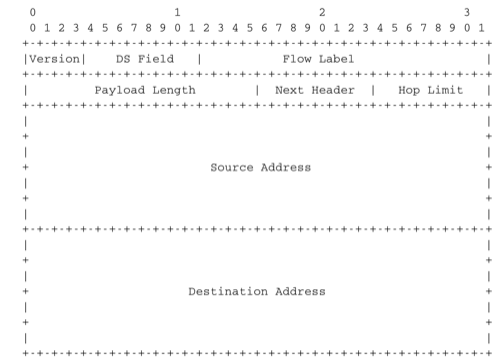
The IP version 6 header (RFC 2460)
Apart from the source and destination addresses, the IPv6 header contains the following fields :
- version : a 4 bits field set to 6 and intended to allow IP to evolve in the future if needed
- Traffic class : this 8 bits field plays a similar role as the DS byte in the IPv4 header
- Flow label : this field was initially intended to be used to tag packets belonging to the same flow. However, as of this writing, there is no clear guideline on how this field should be used by hosts and routers
- Payload length : this is the size of the packet payload in bytes. As the length is encoded as a 16 bits field, an IPv6 packet can contain up to 65535 bytes of payload.
- Next Header : this 8 bits field indicates the type [19] of header that follows the IPv6 header. It can be a transport layer header (e.g. 6 for TCP or 17 for UDP) or an IPv6 option. Handling options as a next header allows simplifying the processing of IPv6 packets compared to IPv4.
- Hop Limit : this 8 bits field indicates the number of routers that can forward the packet. It is decremented by one by each router and has the same purpose as the TTL field of the IPv4 header.
In comparison with IPv4, the IPv6 packets are much simpler and easier to process by routers. A first important difference is that there is no checksum inside the IPv6 header. This is mainly because all datalink layers and transport protocols include a checksum or a CRC to protect their frames/segments against transmission errors. Adding a checksum in the IPv6 header would have forced each router to recompute the checksum of all packets, with limited benefit in detecting errors. In practice, an IP checksum allows for catching errors that occur inside routers (e.g. due to memory corruption) before the packet reaches its destination. However, this benefit was found to be too small given the reliability of current memories and the cost of computing the checksum on each router.
A second difference with IPv4 is that the IPv6 header does not support fragmentation and reassembly. Experience with IPv4 has shown that fragmenting packets in routers was costly [KM1995] and the developers of IPv6 have decided that routers would not fragment packets anymore. If a router receives a packet that is too long to be forwarded, the packet is dropped and the router returns an ICMPv6 messages to inform the sender of the problem. The sender can then either fragment the packet or perform Path MTU discovery. In IPv6, packet fragmentation is performed only by the source by using IPv6 options.
The third difference are the IPv6 options, which are simpler and easier to process than the IPv4 options.
Note
Header compression on low bandwidth links
Given the size of the IPv6 header, it can cause huge overhead on low bandwidth links, especially when small packets are exchanged such as for Voice over IP applications. In such environments, several techniques can be used to reduce the overhead. A first solution is to use data compression in the datalink layer to compress all the information exchanged [Thomborson1992]. These techniques are similar to the data compression algorithms used in tools such as compress(1) or gzip(1) RFC 1951. They compress streams of bits without taking advantage of the fact that these streams contain IP packets with a known structure. A second solution is to compress the IP and TCP header. These header compression techniques, such as the one defined in RFC 5795 take advantage of the redundancy found in successive packets from the same flow to significantly reduce the size of the protocol headers. Another solution is to define a compressed encoding of the IPv6 header that matches the capabilities of the underlying datalink layer RFC 4944.
IPv6 options¶
In IPv6, each option is considered as one header containing a multiple of 8 bytes to ensure that IPv6 options in a packet are aligned on 64 bit boundaries. IPv6 defines several type of options :
- the hop-by-hop options are options that must be processed by the routers on the packet’s path
- the type 0 routing header, which is similar to the IPv4 loose source routing option
- the fragmentation option, which is used when fragmenting an IPv6 packet
- the destination options
- the security options that allow IPv6 hosts to exchange packets with cryptographic authentication (AH header) or encryption and authentication (ESP header)
RFC 2460 provides lots of detail on the encodings of the different types of options. In this section, we only discus some of them. The reader may consult RFC 2460 for more information about the other options. The first point to note is that each option contains a Next Header field, which indicates the type of header that follows the option. A second point to note is that in order to allow routers to efficiently parse IPv6 packets, the options that must be processed by routers (hop-by-hop options and type 0 routing header) must appear first in the packet. This allows the router to process a packet without being forced to analyse all the packet’s options. A third point to note is that hop-by-hop and destination options are encoded using a type length value format. Furthermore, the type field contains bits that indicate whether a router that does not understand this option should ignore the option or discard the packet. This allows the introduction of new options into the network without forcing all devices to be upgraded to support them at the same time.
Two hop-by-hop options have been defined. RFC 2675 specifies the jumbogram that enables IPv6 to support packets containing a payload larger than 65535 bytes. These jumbo packets have their payload length set to 0 and the jumbogram option contains the packet length as a 32 bits field. Such packets can only be sent from a source to a destination if all the routers on the path support this option. However, as of this writing it does not seem that the jumbogram option has been implemented. The router alert option defined in RFC 2711 is the second example of a hop-by-hop option. The packets that contain this option should be processed in a special way by intermediate routers. This option is used for IP packets that carry Resource Reservation Protocol (RSVP) messages. Its usage is explained later.
The type 0 routing header defined in RFC 2460 is an example of an IPv6 option that must be processed by some routers. This option is encoded as shown below.
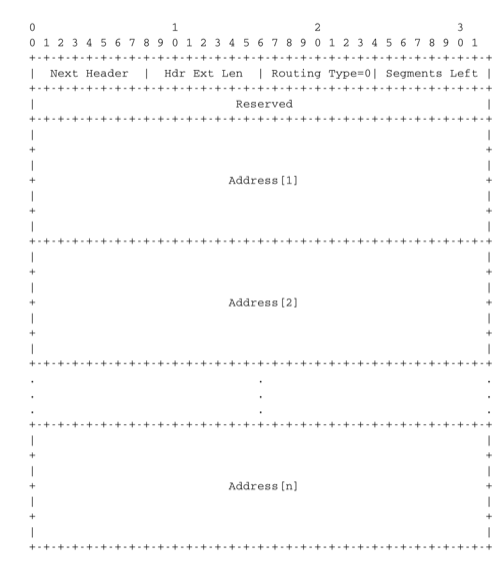
The Type 0 routing header (RFC 2460)
The type 0 routing option was intended to allow a host to indicate a loose source route that should be followed by a packet by specifying the addresses of some of the routers that must forward this packet. Unfortunately, further work with this routing header, including an entertaining demonstration with scapy [BE2007] , revealed some severe security problems with this routing header. For this reason, loose source routing with the type 0 routing header has been removed from the IPv6 specification RFC 5095.
In IPv6, fragmentation is performed exclusively by the source host and relies on the fragmentation header. This 64 bits header is composed of six fields :
- a Next Header field that indicates the type of the header that follows the fragmentation header
- a reserved field set to 0.
- the Fragment Offset is a 13-bit unsigned integer that contains the offset, in 8 bytes units, of the data following this header, relative to the start of the original packet.
- the More flag, which is set to 0 in the last fragment of a packet and to 1 in all other fragments.
- the 32 bits Identification field indicates to which original packet a fragment belongs. When a host sends fragmented packets, it should ensure that it does not reuse the same identification field for packets sent to the same destination during a period of MSL seconds. This is easier with the 32 bits identification used in the IPv6 fragmentation header, than with the 16 bits identification field of the IPv4 header.
Some IPv6 implementations send the fragments of a packet in increasing fragment offset order, starting from the first fragment. Others send the fragments in reverse order, starting from the last fragment. The latter solution can be advantageous for the host that needs to reassemble the fragments, as it can easily allocate the buffer required to reassemble all fragments of the packet upon reception of the last fragment. When a host receives the first fragment of an IPv6 packet, it cannot know a priori the length of the entire IPv6 packet.
The figure below provides an example of a fragmented IPv6 packet containing a UDP segment. The Next Header type reserved for the IPv6 fragmentation option is 44.
Finally, the last type of IPv6 options is the Encaspulating Security Payload (ESP) defined in RFC 4303 and the Authentication Header (AH) defined in RFC 4302. These two headers are used by IPSec RFC 4301. They are discussed in another chapter.
ICMP version 6¶
ICMPv6 defined in RFC 4443 is the companion protocol for IPv6 as ICMPv4 is the companion protocol for IPv4. ICMPv6 is used by routers and hosts to report problems when processing IPv6 packets. However, as we will see in chapter The datalink layer and the Local Area Networks, ICMPv6 is also used when auto-configuring addresses.
The traditional utilisation of ICMPv6 is similar to ICMPv4. ICMPv6 messages are carried inside IPv6 packets (the Next Header field for ICMPv6 is 58). Each ICMP message contains an 8 bits header with a type field, a code field and a 16 bits checksum computed over the entire ICMPv6 message. The message body contains a copy of the IPv6 packet in error.
ICMPv6 specifies two classes of messages : error messages that indicate a problem in handling a packet and informational messages. Four types of error messages are defined in RFC 4443 :
- 1 : Destination Unreachable. Such an ICMPv6 message is sent when the destination address of a packet is unreachable. The code field of the ICMP header contains additional information about the type of unreachability. The following codes are specified in RFC 4443
- 0 : No route to destination. This indicates that the router that sent the ICMPv6 message did not have a route towards the packet’s destination
- 1 : Communication with destination administratively prohibited. This indicates that a firewall has refused to forward the packet towards its destination.
- 2 : Beyond scope of source address. This message can be sent if the source is using link-local addresses to reach a global unicast address outside its subnet.
- 3 : Address unreachable. This message indicates that the packet reached the subnet of the destination, but the host that owns this destination address cannot be reached.
- 4 : Port unreachable. This message indicates that the IPv6 packet was received by the destination, but there was no application listening to the specified port.
2 : Packet Too Big. The router that was to send the ICMPv6 message received an IPv6 packet that is larger than the MTU of the outgoing link. The ICMPv6 message contains the MTU of this link in bytes. This allows the sending host to implement Path MTU discovery RFC 1981
3 : Time Exceeded. This error message can be sent either by a router or by a host. A router would set code to 0 to report the reception of a packet whose Hop Limit reached 0. A host would set code to 1 to report that it was unable to reassemble received IPv6 fragments.
4 : Parameter Problem. This ICMPv6 message is used to report either the reception of an IPv6 packet with an erroneous header field (type 0) or an unknown Next Header or IP option (types 1 and 2). In this case, the message body contains the erroneous IPv6 packet and the first 32 bits of the message body contain a pointer to the error.
Two types of informational ICMPv6 messages are defined in RFC 4443 : echo request and echo reply, which are used to test the reachability of a destination by using ping6(8).
ICMPv6 also allows the discovery of the path between a source and a destination by using traceroute6(8). The output below shows a traceroute between a host at UCLouvain and one of the main IETF servers. Note that this IPv6 path is different than the IPv4 path that was described earlier although the two traceroutes were performed at the same time.
traceroute6 www.ietf.org
traceroute6 to www.ietf.org (2001:1890:1112:1::20) from 2001:6a8:3080:2:217:f2ff:fed6:65c0, 30 hops max, 12 byte packets
1 2001:6a8:3080:2::1 13.821 ms 0.301 ms 0.324 ms
2 2001:6a8:3000:8000::1 0.651 ms 0.51 ms 0.495 ms
3 10ge.cr2.bruvil.belnet.net 3.402 ms 3.34 ms 3.33 ms
4 10ge.cr2.brueve.belnet.net 3.668 ms 10ge.cr2.brueve.belnet.net 3.988 ms 10ge.cr2.brueve.belnet.net 3.699 ms
5 belnet.rt1.ams.nl.geant2.net 10.598 ms 7.214 ms 10.082 ms
6 so-7-0-0.rt2.cop.dk.geant2.net 20.19 ms 20.002 ms 20.064 ms
7 kbn-ipv6-b1.ipv6.telia.net 21.078 ms 20.868 ms 20.864 ms
8 s-ipv6-b1-link.ipv6.telia.net 31.312 ms 31.113 ms 31.411 ms
9 s-ipv6-b1-link.ipv6.telia.net 61.986 ms 61.988 ms 61.994 ms
10 2001:1890:61:8909::1 121.716 ms 121.779 ms 121.177 ms
11 2001:1890:61:9117::2 203.709 ms 203.305 ms 203.07 ms
12 mail.ietf.org 204.172 ms 203.755 ms 203.748 ms
Note
Rate limitation of ICMP messages
High-end hardware based routers use special purpose chips on their interfaces to forward IPv6 packets at line rate. These chips are optimised to process correct IP packets. They are not able to create ICMP messages at line rate. When such a chip receives an IP packet that triggers an ICMP message, it interrupts the main CPU of the router and the software running on this CPU processes the packet. This CPU is much slower than the hardware acceleration found on the interfaces [Gill2004]. It would be overloaded if it had to process IP packets at line rate and generate one ICMP message for each received packet. To protect this CPU, high-end routers limit the rate at which the hardware can interrupt the main CPU and thus the rate at which ICMP messages can be generated. This implies that not all erroneous IP packets cause the transmission of an ICMP message. The risk of overloading the main CPU of the router is also the reason why using hop-by-hop IPv6 options, including the router alter option is discouraged [20].
Interactions between IPv6 and the datalink layer¶
There are several differences between IPv6 and IPv4 when considering their interactions with the datalink layer. In IPv6, the interactions between the network and the datalink layer is performed using ICMPv6.
First ICMPv6 is used to resolve the datalink layer address that corresponds to a given IPv6 address. This part of ICMPv6 is the Neighbour Discovery Protocol (NDP) defined in RFC 4861. NDP is similar to ARP, but there are two important differences. First, NDP messages are exchanged in ICMPv6 messages while ARP messages are sent as datalink layer frames. Second, an ARP request is sent as a broadcast frame while an NDP solicitation message is sent as a multicast ICMPv6 packet that is transported inside a multicast frame. The operation of the NDP protocol is similar to ARP. To obtain an address mapping, a host sends a Neighbour Solicitation message. This message is sent inside an ICMPv6 message that is placed in an IPv6 packet whose source address is the IPv6 address of the requesting host and the destination address is the all-hosts IPv6 multicast address (FF02::1) to which all IPv6 hosts listen. The Neighbour Solicitation contains the requested IPv6 address. The owner of the requested address replies by sending a unicast Neighbour Advertisement message to the requesting host. NDP suffers from similar security issues as the ARP protocol. However, it is possible to secure NDP by using the Cryptographically Generated IPv6 Addresses (CGA) defined in RFC 3972. The Secure Neighbour Discovery Protocol is defined in RFC 3971, but a detailed description of this protocol is outside the scope of this chapter.
IPv6 networks also support the Dynamic Host Configuration Protocol. The IPv6 extensions to DHCP are defined in RFC 3315. The operation of DHCPv6 is similar to DHCP that was described earlier. In addition to DHCPv6, IPv6 networks support another mechanism to assign IPv6 addresses to hosts. This is the Stateless Address Configuration (SLAC) defined in RFC 4862. When a host boots, it derives its identifier from its datalink layer address [21] and concatenates this 64 bits identifier to the FE80::/64 prefix to obtain its link-local IPv6 address. It then sends a Neighbour Solicitation with its link-local address as a target to verify whether another host is using the same link-local address on this subnet. If it receives a Neighbour Advertisement indicating that the link-local address is used by another host, it generates another 64 bits identifier and sends again a Neighbour Solicitation. If there is no answer, the host considers its link-local address to be valid. This address will be used as the source address for all NDP messages sent on the subnet. To automatically configure its global IPv6 address, the host must know the globally routable IPv6 prefix that is used on the local subnet. IPv6 routers regularly send ICMPv6 Router Advertisement messages that indicate the IPv6 prefix assigned to each subnet. Upon reception of this message, the host can derive its global IPv6 address by concatenating its 64 bits identifier with the received prefix. It concludes the SLAC by sending a Neighbour Solicitation message targeted at its global IPv6 address to ensure that another host is not using the same IPv6 address.
Footnotes
| [18] | The full list of allocated IPv6 multicast addresses is available at http://www.iana.org/assignments/ipv6-multicast-addresses |
| [19] | The IANA maintains the list of all allocated Next Header types at http://www.iana.org/assignments/protocol-numbers/ The same registry is used for the IPv4 protocol field and for the IPv6 Next Header. |
| [20] | For a discussion of the issues with the router alert IP option, see http://tools.ietf.org/html/draft-rahman-rtg-router-alert-dangerous-00 or http://tools.ietf.org/html/draft-rahman-rtg-router-alert-considerations-03 |
| [21] | Using a datalink layer address to derive a 64 bits identifier for each host raises privacy concerns as the host will always use the same identifier. Attackers could use this to track hosts on the Internet. An extension to the Stateless Address Configuration mechanism that does not raise privacy concerns is defined in RFC 4941. These privacy extensions allow a host to generate its 64 bits identifier randomly every time it attaches to a subnet. It then becomes impossible for an attacker to use the 64-bits identifier to track a host. |
Middleboxes¶
When the TCP/IP architecture and the IP protocol were defined, two type of devices were considered in the network layer : endhosts and routers. Endhosts are the sources and destinations of IP packets while routers forward packets. When a router forwards an IP packet, it consults its forwarding table, updates the packet’s TTL, recomputes its checksum and forwards it to the next hop. A router does not need to read or change the contents of the packet’s payload.
However, in today’s Internet, there exist devices that are not strictly routers but which process, sometimes modify, and forward IP packets. These devices are often called middleboxes RFC 3234. Some middleboxes only operate in the network layer, but most middleboxes are able to analyse the payload of the received packets and extract the transport header, and in some cases the application layer protocols.
In this section, we briefly describe two type of middleboxes : firewalls and network address translation (NAT) devices. A discussion of the different types of middleboxes with references may be found in RFC 3234.
Firewalls¶
When the Internet was only a research network interconnecting research labs, security was not a concern, and most hosts agreed to exchange packets over TCP connections with most other hosts. However, as more and more users and companies became connected to the Internet, allowing unlimited access to hosts that they managed started to concern companies. Furthermore, at the end of the 1980s, several security issues affected the Internet, such as the first Internet worm [RE1989] and some widely publicised security breaches [Stoll1988] [CB2003] [Cheswick1990] .
These security problems convinced the industry that IP networks are a key part of a company’s infrastructure, that should be protected by special devices like security guards and fences are used to protect buildings. These special devices were quickly called firewalls. A typical firewall has two interfaces :
- an external interface connected to the global Internet
- an internal interface connected to a trusted network
The first firewalls included configurable packet filters. A packet filter is a set of rules defining the security policy of a network. In practice, these rules are based on the values of fields in the IP or transport layer headers. Any field of the IP or transport header can be used in a firewall rule, but the most common ones are:
- filter on the source address. For example, a company may decide to discard all packets received from one of its competitors. In this case, all packets whose source address belong to the competitor’s address block would be rejected
- filter on destination address. For example, the hosts of the research lab of a company may receive packets from the global Internet, but not the hosts of the financial department
- filter on the Protocol number found in the IP header. For example, a company may only allow its hosts to use TCP or UDP, but not other, more experimental, transport protocols
- filter on the TCP or UDP port numbers. For example, only the DNS server of a company should received UDP segments whose destination port is set to 53 or only the official SMTP servers of the company can send TCP segments whose source ports are set to 25
- filter on the TCP flags. For example, a simple solution to prohibit external hosts from opening TCP connections with hosts inside the company is to discard all TCP segments received from the external interface with only the SYN flag set.
Such firewalls are often called stateless firewalls because they do not maintain any state about the TCP connections that pass through them.
Another type of firewalls are stateful firewalls. A stateful firewall tracks the state of each TCP connection passing through it and maintains a TCB for each of these TCP connection. This TCB allows it to reassemble the received segments in order to extract their payload and perform verifications in the application layer. Some firewalls are able to inspect the URLs accessed using HTTP and log all URLs visited or block TCP connections where a dangerous URL is exchanged. Some firewalls can verify that SMTP commands are used when a TCP connection is established on port 25 or that a TCP connection on port 80 carries HTTP commands and responses.
Note
Beyond firewalls
Apart from firewalls, different types of “security” devices have been installed at the periphery of corporate networks. Intrusion Detection Systems (IDS), such as the popular snort , are stateful devices that are capable of matching reassembled segments against regular expressions corresponding to signatures of viruses, worms or other types of attacks. Deep Packet Inspection (DPI) is another type of middlebox that analyses the packet’s payload and is able to reassemble TCP segments in order to detect inappropriate usages. While IDS are mainly used in corporate networks, DPI is mainly used in Internet Service Providers. Some ISPs use DPI to detect and limit the bandwidth consumed by peer-to-peer applications. Some countries such as China or Iran use DPI to detect inappropriate Internet usage.
NAT¶
Network Address Translation (NAT) was proposed in [TE1993] and RFC 3022 as a short term solution to deal with the expected shortage of IPv4 addresses in the late 1980s - early 1990s. Combined with CIDR, NAT helped to significantly slow down the consumption of IPv4 addresses. A NAT is a middlebox that interconnects two networks that are using IPv4 addresses from different addressing spaces. Usually, one of these addressing spaces is the public Internet while the other is using the private IPv4 addresses defined in RFC 1918.
A very common deployment of NAT is in broadband access routers as shown in the figure below. The broadband access router interconnects a home network, either WiFi or Ethernet based, and the global Internet via one ISP over ADSL or CATV. A single IPv4 address is allocated to the broadband access router and network address translation allows all of the hosts attached to the home network to share a single public IPv4 address.
A second type of deployment is in enterprise networks as shown in the figure below. In this case, the NAT functionality is installed on a border router of the enterprise. A private IPv4 address is assigned to each enterprise host while the border router manages a pool containing several public IPv4 addresses.
As the name implies, a NAT is a device that “translates” IP addresses. A NAT maintains a mapping table between the private IP addresses used in the internal network and the public IPv4 addresses. NAT allows a large number of hosts to share a pool of IP addresses, as these hosts do not all access the global Internet at the same time.
The simplest NAT is a middlebox that uses a one-to-one mapping between a private IP address and a public IP address. To understand its operation, let us assume that a NAT, such as the one shown above, has just booted. When the NAT receives the first packet from source S in the internal network which is destined to the public Internet, it creates a mapping between internal address S and the first address of its pool of public addresses (P1). Then, it translates the received packet so that it can be sent to the public Internet. This translation is performed as followed :
- the source address of the packet (S) is replaced by the mapped public address (P1)
- the checksum of the IP header is incrementally updated as its content has changed
- if the packet carried a TCP or UDP segment, the transport layer checksum found in the included segment must also be updated as it is computed over the segment and a pseudo-header that includes the source and destination addresses
When a packet destined to P1 is received from the public Internet, the NAT consults its mapping table to find S. The received packet is translated and forwarded in the internal network.
This works as long as the pool of public IP addresses of the NAT does not become empty. In this case, a mapping must be removed from the mapping table to allow a packet from a new host to be translated. This garbage collection can be implemented by adding to each entry in the mapping table a timestamp that contains the last utilisation time of a mapping entry. This timestamp is updated each time the corresponding entry is used. Then, the garbage collection algorithm can remove the oldest mapping entry in the table.
A drawback of such a simple enterprise NAT is the size of the pool of public IPv4 addresses which is often too small to allow a large number of hosts share such a NAT. In this case, a better solution is to allow the NAT to translate both IP addresses and port numbers.
Such a NAT maintains a mapping table that maps an internal IP address and TCP port number with an external IP address and TCP port number. When such a NAT receives a packet from the internal network, it performs a lookup in the mapping table with the packet’s source IP address and source TCP port number. If a mapping is found, the source IP address and the source TCP port number of the packet are translated with the values found in the mapping table, the checksums are updated and the packet is sent to the global Internet. If no mapping is found, a new mapping is created with the first available couple (IP address, TCP port number) and the packet is translated. The entries of the mapping table are either removed at the end of the corresponding TCP connection as the NAT tracks TCP connection state like a stateful firewall or after some idle time.
When such a NAT receives a packet from the global Internet, it looks up its mapping table for the packet’s destination IP address and destination TCP port number. If a mapping is found, the packet is translated and forwarded into the internal network. Otherwise, the packet is discarded as the NAT cannot determine to which particular internal host the packet should be forwarded. For this reason,
With  different port numbers, a NAT may support a large number of hosts with a single public IPv4 address. However, it should be noted that some applications open a large number of TCP connections [Miyakawa2008]. Each of these TCP connections consumes one mapping entry in the NAT’s mapping table.
different port numbers, a NAT may support a large number of hosts with a single public IPv4 address. However, it should be noted that some applications open a large number of TCP connections [Miyakawa2008]. Each of these TCP connections consumes one mapping entry in the NAT’s mapping table.
NAT allows many hosts to share one or a few public IPv4 addresses. However, using NAT has two important drawbacks. First, it is difficult for external hosts to open TCP connections with hosts that are behind a NAT. Some consider this to be a benefit from a security perspective. However, a NAT should not be confused with a firewall as there are some techniques to traverse NATs. Second, NAT breaks the end-to-end transparency of the network and transport layers. The main problem is when an application layer protocol uses IP addresses in some of the ADUs that it sends. A popular example is ftp defined in RFC 959. In this case, there is a mismatch between the packet header translated by the NAT and the packet payload. The only solution to solve this problem is to place an Application Level Gateway (ALG) on the NAT that understands the application layer protocol and can thus translate the IP addresses and port numbers found in the ADUs. However, defining an ALG for each application is costly and application developers should avoid using IP addresses in the messages exchanged in the application layer RFC 3235.
Note
IPv6 and NAT
NAT has been very successful with IPv4. Given the size of the IPv6 addressing space, the IPv6 designers expected that NAT would never be useful with IPv6. The end-to-end transparency of IPv6 has been one of its key selling points compared to IPv4. However, the expected shortage of IPv4 addresses lead enterprise network administrators to consider IPv6 more seriously. One of the results of this analysis is that the IETF defined NAT devices RFC 6296 that are IPv6 specific. Another usage of NAT with IPv6 is to allow IPv6 hosts to access IPv4 destinations and conversely. The early IPv6 specifications included the Network Address Translation - Protocol Translation (NAT-PT) mechanism defined in RFC 2766. This mechanism was later deprecated in RFC 4966 but has been recently restarted under the name NAT64 RFC 6144. A NAT64 is a middlebox that performs the IPv6<->IPv4 packet translation to allow IPv6 hosts to contact IPv4 servers RFC 6144.
Routing in IP networks¶
In a large IP network such as the global Internet, routers need to exchange routing information. The Internet is an interconnection of networks, often called domains, that are under different responsibilities. As of this writing, the Internet is composed on more than 30,000 different domains and this number is still growing. A domain can be a small enterprise that manages a few routers in a single building, a larger enterprise with a hundred routers at multiple locations, or a large Internet Service Provider managing thousands of routers. Two classes of routing protocols are used to allow these domains to efficiently exchange routing information.
The first class of routing protocols are the intradomain routing protocols (sometimes also called the interior gateway protocols or IGP). An intradomain routing protocol is used by all routers inside a domain to exchange routing information about the destinations that are reachable inside the domain. There are several intradomain routing protocols. Some domains use RIP, which is a distance vector protocol. Other domains use link-state routing protocols such as OSPF or IS-IS. Finally, some domains use static routing or proprietary protocols such as IGRP or EIGRP.
These intradomain routing protocols usually have two objectives. First, they distribute routing information that corresponds to the shortest path between two routers in the domain. Second, they should allow the routers to quickly recover from link and router failures.
The second class of routing protocols are the interdomain routing protocols (sometimes also called the exterior gateway protocols or EGP). The objective of an interdomain routing protocol is to distribute routing information between domains. For scalability reasons, an interdomain routing protocol must distribute aggregated routing information and considers each domain as a black box.
A very important difference between intradomain and interdomain routing are the routing policies that are used by each domain. Inside a single domain, all routers are considered equal, and when several routes are available to reach a given destination prefix, the best route is selected based on technical criteria such as the route with the shortest delay, the route with the minimum number of hops or the route with the highest bandwidth.
When we consider the interconnection of domains that are managed by different organisations, this is no longer true. Each domain implements its own routing policy. A routing policy is composed of three elements : an import filter that specifies which routes can be accepted by a domain, an export filter that specifies which routes can be advertised by a domain and a ranking algorithm that selects the best route when a domain knows several routes towards the same destination prefix. As we will see later, another important difference is that the objective of the interdomain routing protocol is to find the cheapest route towards each destination. There is only one interdomain routing protocol : BGP.
Intradomain routing¶
In this section, we briefly describe the key features of the two main intradomain unicast routing protocols : RIP and OSPF.
RIP¶
The Routing Information Protocol (RIP) is the simplest routing protocol that was standardised for the TCP/IP protocol suite. RIP is defined in RFC 2453. Additional information about RIP may be found in [Malkin1999]
RIP routers periodically exchange RIP messages. The format of these messages is shown below. A RIP message is sent inside a UDP segment whose destination port is set to 521. A RIP message contains several fields. The Cmd field indicates whether the RIP message is a request or a response. Routers send one of more RIP response messages every 30 seconds. These messages contain the distance vectors that summarize the router’s routing table. The RIP request messages can be used by routers or hosts to query other routers about the content of their routing table. A typical usage is when a router boots and quickly wants to receive the RIP responses from its neighbours to compute its own routing table. The current version of RIP is version 2 defined in RFC 2453 for IPv4 and RFC 2080 for IPv6.
The RIP header contains an authentication field. This authentication can be used by network administrators to ensure that only the RIP messages sent by the routers that they manage are used to build the routing tables. RFC 2453 only supports a basic authentication scheme where all routers are configured with the same password and include this password in all RIP messages. This is not very secure since an attacker can know the password by capturing a single RIP message. However, this password can protect against configuration errors. Stronger authentication schemes are described in RFC 2082 and RFC 4822, but the details of these mechanisms are outside the scope of this section.
Each RIP message contains a set of route entries. Each route entry is encoded as a 20 bytes field whose format is shown below. RIP was initially designed to be suitable for different network layer protocols. Some implementations of RIP were used in XNS or IPX networks. The first field of the RIP route entry is the Address Family Identifier (AFI). This identifier indicates the type of address found in the route entry [22]. IPv4 uses AFI=1. The other important fields of the route entry are the IPv4 prefix, the netmask that indicates the length of the subnet identifier and is encoded as a 32 bits netmask and the metric. Although the metric is encoded as a 32 bits field, the maximum RIP metric is 15 (for RIP,  )
)
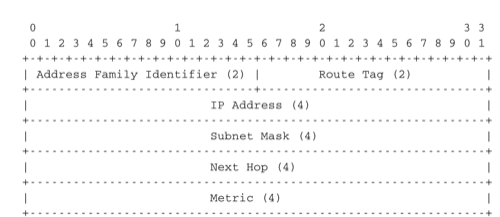
Format of the RIP IPv4 route entries (RFC 2453)
With a 20 bytes route entry, it was difficult to use the same format as above to support IPv6. Instead of defining a variable length route entry format, the designers of RFC 2080 defined a new format that does not include an AFI field. The format of the route entries used by RFC 2080 is shown below. Plen is the length of the subnet identifier in bits and the metric is encoded as one byte. The maximum metric is still 15.
Note
A note on timers
The first RIP implementations sent their distance vector exactly every 30 seconds. This worked well in most networks, but some researchers noticed that routers were sometimes overloaded because they were processing too many distance vectors at the same time [FJ1994]. They collected packet traces in these networks and found that after some time the routers’ timers became synchronised, i.e. almost all routers were sending their distance vectors at almost the same time. This synchronisation of the transmission times of the distance vectors caused an overload on the routers’ CPU but also increased the convergence time of the protocol in some cases. This was mainly due to the fact that all routers set their timers to the same expiration time after having processed the received distance vectors. Sally Floyd and Van Jacobson proposed in [FJ1994] a simple solution to solve this synchronisation problem. Instead of advertising their distance vector exactly after 30 seconds, a router should send its next distance vector after a delay chosen randomly in the [15,45] interval RFC 2080. This randomisation of the delays prevents the synchronisation that occurs with a fixed delay and is now a recommended practice for protocol designers.
Footnotes
| [22] | The Address Family Identifiers are maintained by IANA at http://www.iana.org/assignments/address-family-numbers/ |
OSPF¶
Link-state routing protocols are used in IP networks. Open Shortest Path First (OSPF), defined in RFC 2328, is the link state routing protocol that has been standardised by the IETF. The last version of OSPF, which supports IPv6, is defined in RFC 5340. OSPF is frequently used in enterprise networks and in some ISP networks. However, ISP networks often use the IS-IS link-state routing protocol [ISO10589] , which was developed for the ISO CLNP protocol but was adapted to be used in IP RFC 1195 networks before the finalisation of the standardisation of OSPF. A detailed analysis of ISIS and OSPF may be found in [BMO2006] and [Perlman2000]. Additional information about OSPF may be found in [Moy1998].
Compared to the basics of link-state routing protocols that we discussed in section Link state routing, there are some particularities of OSPF that are worth discussing. First, in a large network, flooding the information about all routers and links to thousands of routers or more may be costly as each router needs to store all the information about the entire network. A better approach would be to introduce hierarchical routing. Hierarchical routing divides the network into regions. All the routers inside a region have detailed information about the topology of the region but only learn aggregated information about the topology of the other regions and their interconnections. OSPF supports a restricted variant of hierarchical routing. In OSPF’s terminology, a region is called an area.
OSPF imposes restrictions on how a network can be divided into areas. An area is a set of routers and links that are grouped together. Usually, the topology of an area is chosen so that a packet sent by one router inside the area can reach any other router in the area without leaving the area [23] . An OSPF area contains two types of routers RFC 2328:
- Internal router : A router whose directly connected networks belong to the area
- Area border routers : A router that is attached to several areas.
For example, the network shown in the figure below has been divided into three areas : area 1, containing routers R1, R3, R4, R5 and RA, area 2 containing R7, R8, R9, R10, RB and RC. OSPF areas are identified by a 32 bit integer, which is sometimes represented as an IP address. Among the OSPF areas, area 0, also called the backbone area has a special role. The backbone area groups all the area border routers (routers RA, RB and RC in the figure below) and the routers that are directly connected to the backbone routers but do not belong to another area (router RD in the figure below). An important restriction imposed by OSPF is that the path between two routers that belong to two different areas (e.g. R1 and R8 in the figure below) must pass through the backbone area.
Inside each non-backbone area, routers distribute the topology of the area by exchanging link state packets with the other routers in the area. The internal routers do not know the topology of other areas, but each router knows how to reach the backbone area. Inside an area, the routers only exchange link-state packets for all destinations that are reachable inside the area. In OSPF, the inter-area routing is done by exchanging distance vectors. This is illustrated by the network topology shown below.
Let us first consider OSPF routing inside area 2. All routers in the area learn a route towards 192.168.1.0/24 and 192.168.10.0/24. The two area border routers, RB and RC, create network summary advertisements. Assuming that all links have a unit link metric, these would be:
- RB advertises 192.168.1.0/24 at a distance of 2 and 192.168.10.0/24 at a distance of 3
- RC advertises 192.168.1.0/24 at a distance of 3 and 192.168.10.0/24 at a distance of 2
These summary advertisements are flooded through the backbone area attached to routers RB and RC. In its routing table, router RA selects the summary advertised by RB to reach 192.168.1.0/24 and the summary advertised by RC to reach 192.168.10.0/24. Inside area 1, router RA advertises a summary indicating that 192.168.1.0/24 and 192.168.10.0/24 are both at a distance of 3 from itself.
On the other hand, consider the prefixes 10.0.0.0/24 and 10.0.1.0/24 that are inside area 1. Router RA is the only area border router that is attached to this area. This router can create two different network summary advertisements :
- 10.0.0.0/24 at a distance of 1 and 10.0.1.0/24 at a distance of 2 from RA
- 10.0.0.0/23 at a distance of 2 from RA
The first summary advertisement provides precise information about the distance used to reach each prefix. However, all routers in the network have to maintain a route towards 10.0.0.0/24 and a route towards 10.0.1.0/24 that are both via router RA. The second advertisement would improve the scalability of OSPF by reducing the number of routes that are advertised across area boundaries. However, in practice this requires manual configuration on the border routers.
The second OSPF particularity that is worth discussing is the support of Local Area Networks (LAN). As shown in the example below, several routers may be attached to the same LAN.
A first solution to support such a LAN with a link-state routing protocol would be to consider that a LAN is equivalent to a full-mesh of point-to-point links as if each router can directly reach any other router on the LAN. However, this approach has two important drawbacks :
- Each router must exchange HELLOs and link state packets with all the other routers on the LAN. This increases the number of OSPF packets that are sent and processed by each router.
- Remote routers, when looking at the topology distributed by OSPF, consider that there is a full-mesh of links between all the LAN routers. Such a full-mesh implies a lot of redundancy in case of failure, while in practice the entire LAN may completely fail. In case of a failure of the entire LAN, all routers need to detect the failures and flood link state packets before the LAN is completely removed from the OSPF topology by remote routers.
To better represent LANs and reduce the number of OSPF packets that are exchanged, OSPF handles LAN differently. When OSPF routers boot on a LAN, they elect [24] one of them as the Designated Router (DR) RFC 2328. The DR router represents the local area network, and advertises the LAN’s subnet (138.48.4.0/24 in the example above). Furthermore, LAN routers only exchange HELLO packets with the DR. Thanks to the utilisation of a DR, the topology of the LAN appears as a set of point-to-point links connected to the DR as shown in the figure below.
Note
How to quickly detect a link failure ?
Network operators expect an OSPF network to be able to quickly recover from link or router failures [VPD2004]. In an OSPF network, the recovery after a failure is performed in three steps [FFEB2005] :
- the routers that are adjacent to the failure detect it quickly. The default solution is to rely on the regular exchange of HELLO packets. However, the interval between successive HELLOs is often set to 10 seconds... Setting the HELLO timer down to a few milliseconds is difficult as HELLO packets are created and processed by the main CPU of the routers and these routers cannot easily generate and process a HELLO packet every millisecond on each of their interfaces. A better solution is to use a dedicated failure detection protocol such as the Bidirectional Forwarding Detection (BFD) protocol defined in [KW2009] that can be implemented directly on the router interfaces. Another solution to be able to detect the failure is to instrument the physical and the datalink layer so that they can interrupt the router when a link fails. Unfortunately, such a solution cannot be used on all types of physical and datalink layers.
- the routers that have detected the failure flood their updated link state packets in the network
- all routers update their routing table
Footnotes
| [23] | OSPF can support virtual links to connect routers together that belong to the same area but are not directly connected. However, this goes beyond this introduction to OSPF. |
| [24] | The OSPF Designated Router election procedure is defined in RFC 2328. Each router can be configured with a router priority that influences the election process since the router with the highest priority is preferred when an election is run. |
Interdomain routing¶
As explained earlier, the Internet is composed of more than 30,000 different networks [25] called domains. Each domain is composed of a group of routers and hosts that are managed by the same organisation. Example domains include belnet, sprint, level3, geant, abilene, cisco or google ...
Each domain contains a set of routers. From a routing point of view, these domains can be divided into two classes : the transit and the stub domains. A stub domain sends and receives packets whose source or destination are one of its own hosts. A transit domain is a domain that provides a transit service for other domains, i.e. the routers in this domain forward packets whose source and destination do not belong to the transit domain. As of this writing, about 85% of the domains in the Internet are stub domains [40]. A stub domain that is connected to a single transit domain is called a single-homed stub. A multihomed stub is a stub domain connected to two or more transit providers.
The stub domains can be further classified by considering whether they mainly send or receive packets. An access-rich stub domain is a domain that contains hosts that mainly receive packets. Typical examples include small ADSL- or cable modem-based Internet Service Providers or enterprise networks. On the other hand, a content-rich stub domain is a domain that mainly produces packets. Examples of content-rich stub domains include google, yahoo, microsoft, facebook or content distribution networks such as akamai or limelight For the last few years, we have seen a rapid growth of these content-rich stub domains. Recent measurements [ATLAS2009] indicate that a growing fraction of all the packets exchanged on the Internet are produced in the data centers managed by these content providers.
Domains need to be interconnected to allow a host inside a domain to exchange IP packets with hosts located in other domains. From a physical perspective, domains can be interconnected in two different ways. The first solution is to directly connect a router belonging to the first domain with a router inside the second domain. Such links between domains are called private interdomain links or private peering links. In practice, for redundancy or performance reasons, distinct physical links are usually established between different routers in the two domains that are interconnected.
Such private peering links are useful when, for example, an enterprise or university network needs to be connected to its Internet Service Provider. However, some domains are connected to hundreds of other domains [26] . For some of these domains, using only private peering links would be too costly. A better solution to allow many domains to interconnect cheaply are the Internet eXchange Points (IXP). An IXP is usually some space in a data center that hosts routers belonging to different domains. A domain willing to exchange packets with other domains present at the IXP installs one of its routers on the IXP and connects it to other routers inside its own network. The IXP contains a Local Area Network to which all the participating routers are connected. When two domains that are present at the IXP wish [28] to exchange packets, they simply use the Local Area Network. IXPs are very popular in Europe and many Internet Service Providers and Content providers are present in these IXPs.
In the early days of the Internet, domains would simply exchange all the routes they know to allow a host inside one domain to reach any host in the global Internet. However, in today’s highly commercial Internet, this is no longer true as interdomain routing mainly needs to take into account the economical relationships between the domains. Furthermore, while intradomain routing usually prefers some routes over others based on their technical merits (e.g. prefer route with the minimum number of hops, prefer route with the minimum delay, prefer high bandwidth routes over low bandwidth ones, etc) interdomain routing mainly deals with economical issues. For interdomain routing, the cost of using a route is often more important than the quality of the route measured by its delay or bandwidth.
There are different types of economical relationships that can exist between domains. Interdomain routing converts these relationships into peering relationships between domains that are connected via peering links.
The first category of peering relationship is the customer->provider relationship. Such a relationship is used when a customer domain pays an Internet Service Provider to be able to exchange packets with the global Internet over an interdomain link. A similar relationship is used when a small Internet Service Provider pays a larger Internet Service Provider to exchange packets with the global Internet.
To understand the customer->provider relationship, let us consider the simple internetwork shown in the figure above. In this internetwork, AS7 is a stub domain that is connected to one provider : AS4. The contract between AS4 and AS7 allows a host inside AS7 to exchange packets with any host in the internetwork. To enable this exchange of packets, AS7 must know a route towards any domain and all the domains of the internetwork must know a route via AS4 that allows them to reach hosts inside AS7. From a routing perspective, the commercial contract between AS7 and AS4 leads to the following routes being exchanged :
- over a customer->provider relationship, the customer domain advertises to its provider all its routes and all the routes that it has learned from its own customers.
- over a provider->customer relationship, the provider advertises all the routes that it knows to its customer.
The second rule ensures that the customer domain receives a route towards all destinations that are reachable via its provider. The first rule allows the routes of the customer domain to be distributed throughout the Internet.
Coming back to the figure above, AS4 advertises to its two providers AS1 and AS2 its own routes and the routes learned from its customer, AS7. On the other hand, AS4 advertises to AS7 all the routes that it knows.
The second type of peering relationship is the shared-cost peering relationship. Such a relationship usually does not involve a payment from one domain to the other in contrast with the customer->provider relationship. A shared-cost peering relationship is usually established between domains having a similar size and geographic coverage. For example, consider the figure above. If AS3 and AS4 exchange many packets via AS1, they both need to pay AS1. A cheaper alternative for AS3 and AS4 would be to establish a shared-cost peering. Such a peering can be established at IXPs where both AS3 and AS4 are present or by using private peering links. This shared-cost peering should be used to exchange packets between hosts inside AS3 and hosts inside AS4. However, AS3 does not want to receive on the AS3-AS4 shared-cost peering links packets whose destination belongs to AS1 as AS3 would have to pay to send these packets to AS1.
From a routing perspective, over a shared-cost peering relationship a domain only advertises its internal routes and the routes that it has learned from its customers. This restriction ensures that only packets destined to the local domain or one of its customers is received over the shared-cost peering relationship. This implies that the routes that have been learned from a provider or from another shared-cost peer is not advertised over a shared-cost peering relationship. This is motivated by economical reasons. If a domain were to advertise the routes that it learned from a provider over a shared-cost peering relationship that does not bring revenue, it would have allowed its shared-cost peer to use the link with its provider without any payment. If a domain were to advertise the routes it learned over a shared cost peering over another shared-cost peering relationship, it would have allowed these shared-cost peers to use its own network (which may span one or more continents) freely to exchange packets.
Finally, the last type of peering relationship is the sibling. Such a relationship is used when two domains exchange all their routes in both directions. In practice, such a relationship is only used between domains that belong to the same company.
These different types of relationships are implemented in the interdomain routing policies defined by each domain. The interdomain routing policy of a domain is composed of three main parts :
- the import filter that specifies, for each peering relationship, the routes that can be accepted from the neighbouring domain (the non-acceptable routes are ignored and the domain never uses them to forward packets)
- the export filter that specifies, for each peering relationship, the routes that can be advertised to the neighbouring domain
- the ranking algorithm that is used to select the best route among all the routes that the domain has received towards the same destination prefix
A domain’s import and export filters can be defined by using the Route Policy Specification Language (RPSL) specified in RFC 2622 [GAVE1999] . Some Internet Service Providers, notably in Europe, use RPSL to document [29] their import and export policies. Several tools help to easily convert a RPSL policy into router commands.
The figure below provides a simple example of import and export filters for two domains in a simple internetwork. In RPSL, the keyword ANY is used to replace any route from any domain. It is typically used by a provider to indicate that it announces all its routes to a customer over a provider->customer relationship. This is the case for AS4‘s export policy. The example below clearly shows the difference between a provider->customer and a shared-cost peering relationship. AS4‘s export filter indicates that it announces only its internal routes (AS4) and the routes learned from its clients (AS7) over its shared-cost peering with AS3, while it advertises all the routes that it uses (including the routes learned from AS3) to AS7.
The Border Gateway Protocol¶
The Internet uses a single interdomain routing protocol : the Border Gateway Protocol (BGP). The current version of BGP is defined in RFC 4271. BGP differs from the intradomain routing protocols that we have already discussed in several ways. First, BGP is a path-vector protocol. When a BGP router advertises a route towards a prefix, it announces the IP prefix and the interdomain path used to reach this prefix. From BGP’s point of view, each domain is identified by a unique Autonomous System (AS) number [30] and the interdomain path contains the AS numbers of the transit domains that are used to reach the associated prefix. This interdomain path is called the AS Path. Thanks to these AS-Paths, BGP does not suffer from the count-to-infinity problems that affect distance vector routing protocols. Furthermore, the AS-Path can be used to implement some routing policies. Another difference between BGP and the intradomain routing protocols is that a BGP router does not send the entire contents of its routing table to its neighbours regularly. Given the size of the global Internet, routers would be overloaded by the number of BGP messages that they would need to process. BGP uses incremental updates, i.e. it only announces the routes that have changed to its neighbours.
The figure below shows a simple example of the BGP routes that are exchanged between domains. In this example, prefix 1.0.0.0/8 is announced by AS1. AS1 advertises a BGP route towards this prefix to AS2. The AS-Path of this route indicates that AS1 is the originator of the prefix. When AS4 receives the BGP route from AS1, it re-announces it to AS2 and adds its AS number to the AS-Path. AS2 has learned two routes towards prefix 1.0.0.0/8. It compares the two routes and prefers the route learned from AS4 based on its own ranking algorithm. AS2 advertises to AS5 a route towards 1.0.0.0/8 with its AS-Path set to AS2:AS4:AS1. Thanks to the AS-Path, AS5 knows that if it sends a packet towards 1.0.0.0/8 the packet first passes through AS2, then through AS4 before reaching its destination inside AS1.
BGP routers exchange routes over BGP sessions. A BGP session is established between two routers belonging to two different domains that are directly connected. As explained earlier, the physical connection between the two routers can be implemented as a private peering link or over an Internet eXchange Point. A BGP session between two adjacent routers runs above a TCP connection (the default BGP port is 179). In contrast with intradomain routing protocols that exchange IP packets or UDP segments, BGP runs above TCP because TCP ensures a reliable delivery of the BGP messages sent by each router without forcing the routers to implement acknowledgements, checksums, etc. Furthermore, the two routers consider the peering link to be up as long as the BGP session and the underlying TCP connection remain up [31]. The two endpoints of a BGP session are called BGP peers.
In practice, to establish a BGP session between routers R1 and R2 in the figure above, the network administrator of AS3 must first configure on R1 the IP address of R2 on the R1-R2 link and the AS number of R2. Router R1 then regularly tries to establish the BGP session with R2. R2 only agrees to establish the BGP session with R1 once it has been configured with the IP address of R1 and its AS number. For security reasons, a router never establishes a BGP session that has not been manually configured on the router.
The BGP protocol RFC 4271 defines several types of messages that can be exchanged over a BGP session :
- OPEN : this message is sent as soon as the TCP connection between the two routers has been established. It initialises the BGP session and allows the negotiation of some options. Details about this message may be found in RFC 4271
- NOTIFICATION : this message is used to terminate a BGP session, usually because an error has been detected by the BGP peer. A router that sends or receives a NOTIFICATION message immediately shutdowns the corresponding BGP session.
- UPDATE: this message is used to advertise new or modified routes or to withdraw previously advertised routes.
- KEEPALIVE : this message is used to ensure a regular exchange of messages on the BGP session, even when no route changes. When a BGP router has not sent an UPDATE message during the last 30 seconds, it shall send a KEEPALIVE message to confirm to the other peer that it is still up. If a peer does not receive any BGP message during a period of 90 seconds [32], the BGP session is considered to be down and all the routes learned over this session are withdrawn.
As explained earlier, BGP relies on incremental updates. This implies that when a BGP session starts, each router first sends BGP UPDATE messages to advertise to the other peer all the exportable routes that it knows. Once all these routes have been advertised, the BGP router only sends BGP UPDATE messages about a prefix if the route is new, one of its attributes has changed or the route became unreachable and must be withdrawn. The BGP UPDATE message allows BGP routers to efficiently exchange such information while minimising the number of bytes exchanged. Each UPDATE message contains :
- a list of IP prefixes that are withdrawn
- a list of IP prefixes that are (re-)advertised
- the set of attributes (e.g. AS-Path) associated to the advertised prefixes
In the remainder of this chapter, and although all routing information is exchanged using BGP UPDATE messages, we assume for simplicity that a BGP message contains only information about one prefix and we use the words :
- Withdraw message to indicate a BGP UPDATE message containing one route that is withdrawn
- Update message to indicate a BGP UPDATE containing a new or updated route towards one destination prefix with its attributes
From a conceptual point of view, a BGP router connected to N BGP peers, can be described as being composed of four parts as shown in the figure below.
In this figure, the router receives BGP messages on the left part of the figure, processes these messages and possibly sends BGP messages on the right part of the figure. A BGP router contains three important data structures :
- the Adj-RIB-In contains the BGP routes that have been received from each BGP peer. The routes in the Adj-RIB-In are filtered by the import filter before being placed in the BGP-Loc-RIB. There is one import filter per BGP peer.
- the Local Routing Information Base (Loc-RIB) contains all the routes that are considered as acceptable by the router. The Loc-RIB may contain several routes, learned from different BGP peers, towards the same destination prefix.
- the Forwarding Information Base (FIB) is used by the dataplane to forward packets towards their destination. The FIB contains, for each destination, the best route that has been selected by the BGP decision process. This decision process is an algorithm that selects, for each destination prefix, the best route according to the router’s ranking algorithm that is part of its policy.
- the Adj-RIB-Out contains the BGP routes that have been advertised to each BGP peer. The Adj-RIB-Out for a given peer is built by applying the peer`s export filter on the routes that have been installed in the FIB. There is one export filter per BGP peer. For this reason, the Adj-RIB-Out of a peer may contain different routes than the Adj-RIB-Out of another peer.
When a BGP session starts, the routers first exchange OPEN messages to negotiate the options that apply throughout the entire session. Then, each router extracts from its FIB the routes to be advertised to the peer. It is important to note that, for each known destination prefix, a BGP router can only advertise to a peer the route that it has itself installed inside its FIB. The routes that are advertised to a peer must pass the peer’s export filter. The export filter is a set of rules that define which routes can be advertised over the corresponding session, possibly after having modified some of its attributes. One export filter is associated to each BGP session. For example, on a shared-cost peering, the export filter only selects the internal routes and the routes that have been learned from a customer. The pseudo-code below shows the initialisation of a BGP session.
def initiliaze_BGP_session( RemoteAS, RemoteIP):
# Initialize and start BGP session
# Send BGP OPEN Message to RemoteIP on port 179
# Follow BGP state machine
# advertise local routes and routes learned from peers*/
for d in BGPLocRIB :
B=build_BGP_Update(d)
S=Apply_Export_Filter(RemoteAS,B)
if (S != None) :
send_Update(S,RemoteAS,RemoteIP)
# entire RIB has been sent
# new Updates will be sent to reflect local or distant
# changes in routers
In the above pseudo-code, the build_BGP_UPDATE(d) procedure extracts from the BGP Loc-RIB the best path towards destination d (i.e. the route installed in the FIB) and prepares the corresponding BGP UPDATE message. This message is then passed to the export filter that returns NULL if the route cannot be advertised to the peer or the (possibly modified) BGP UPDATE message to be advertised. BGP routers allow network administrators to specify very complex export filters, see e.g. [WMS2004]. A simple export filter that implements the equivalent of split horizon is shown below.
def apply_export_filter(RemoteAS, BGPMsg) :
# check if RemoteAS already received route
if RemoteAS is BGPMsg.ASPath :
BGPMsg=None
# Many additional export policies can be configured :
# Accept or refuse the BGPMsg
# Modify selected attributes inside BGPMsg
return BGPMsg
At this point, the remote router has received all the exportable BGP routes. After this initial exchange, the router only sends BGP UPDATE messages when there is a change (addition of a route, removal of a route or change in the attributes of a route) in one of these exportable routes. Such a change can happen when the router receives a BGP message. The pseudo-code below summarizes the processing of these BGP messages.
def Recvd_BGPMsg(Msg, RemoteAS) :
B=apply_import_filer(Msg,RemoteAS)
if (B== None): # Msg not acceptable
return
if IsUPDATE(Msg):
Old_Route=BestRoute(Msg.prefix)
Insert_in_RIB(Msg)
Run_Decision_Process(RIB)
if (BestRoute(Msg.prefix) != Old_Route) :
# best route changed
B=build_BGP_Message(Msg.prefix);
S=apply_export_filter(RemoteAS,B);
if (S!=None) : # announce best route
send_UPDATE(S,RemoteAS,RemoteIP);
else if (Old_Route != None) :
send_WITHDRAW(Msg.prefix,RemoteAS, RemoteIP)
else : # Msg is WITHDRAW
Old_Route=BestRoute(Msg.prefix)
Remove_from_RIB(Msg)
Run_Decision_Process(RIB)
if (Best_Route(Msg.prefix) !=Old_Route):
# best route changed
B=build_BGP_Message(Msg.prefix)
S=apply_export_filter(RemoteAS,B)
if (S != None) : # still one best route towards Msg.prefix
send_UPDATE(S,RemoteAS, RemoteIP);
else if(Old_Route != None) : # No best route anymore
send_WITHDRAW(Msg.prefix,RemoteAS,RemoteIP);
When a BGP message is received, the router first applies the peer’s import filter to verify whether the message is acceptable or not. If the message is not acceptable, the processing stops. The pseudo-code below shows a simple import filter. This import filter accepts all routes, except those that already contain the local AS in their AS-Path. If such a route was used, it would cause a routing loop. Another example of an import filter would be a filter used by an Internet Service Provider on a session with a customer to only accept routes towards the IP prefixes assigned to the customer by the provider. On real routers, import filters can be much more complex and some import filters modify the attributes of the received BGP UPDATE [WMS2004] .
def apply_import_filter(RemoteAS, BGPMsg):
if MysAS in BGPMsg.ASPath :
BGPMsg=None
# Many additional import policies can be configured :
# Accept or refuse the BGPMsg
# Modify selected attributes inside BGPMsg
return BGPMsg
Note
The bogon filters
Another example of frequently used import filters are the filters that Internet Service Providers use to ignore bogon routes. In the ISP community, a bogon route is a route that should not be advertised on the global Internet. Typical examples include the private IPv4 prefixes defined in RFC 1918, the loopback prefixes (127.0.0.1/8 and ::1/128) or the IP prefixes that have not yet been allocated by IANA. A well managed BGP router should ensure that it never advertises bogons on the global Internet. Detailed information about these bogons may be found at http://www.team-cymru.org/Services/Bogons/
If the import filter accepts the BGP message, the pseudo-code distinguishes two cases. If this is an Update message for prefix p, this can be a new route for this prefix or a modification of the route’s attributes. The router first retrieves from its RIB the best route towards prefix p. Then, the new route is inserted in the RIB and the BGP decision process is run to find whether the best route towards destination p changes. A BGP message only needs to be sent to the router’s peers if the best route has changed. For each peer, the router applies the export filter to verify whether the route can be advertised. If yes, the filtered BGP message is sent. Otherwise, a Withdraw message is sent. When the router receives a Withdraw message, it also verifies whether the removal of the route from its RIB caused its best route towards this prefix to change. It should be noted that, depending on the content of the RIB and the export filters, a BGP router may need to send a Withdraw message to a peer after having received an Update message from another peer and conversely.
Let us now discuss in more detail the operation of BGP in an IPv4 network. For this, let us consider the simple network composed of three routers located in three different ASes and shown in the figure below.
This network contains three routers : R1, R2 and R3. Each router is attached to a local IPv4 subnet that it advertises using BGP. There are two BGP sessions, one between R1 and R2 and the second between R2 and R3. A /30 subnet is used on each interdomain link (195.100.0.0/30 on R1-R2 and 195.100.0.4/30 on R2-R3). The BGP sessions run above TCP connections established between the neighbouring routers (e.g. 195.100.0.1 - 195.100.0.2 for the R1-R2 session).
Let us assume that the R1-R2 BGP session is the first to be established. A BGP Update message sent on such a session contains three fields :
- the advertised prefix
- the BGP nexthop
- the attributes including the AS-Path
We use the notation U(prefix, nexthop, attributes) to represent such a BGP Update message in this section. Similarly, W(prefix) represents a BGP withdraw for the specified prefix. Once the R1-R2 session has been established, R1 sends U(194.100.0.0/24,195.100.0.1,AS10) to R2 and R2 sends U(194.100.2.0/23,195.100.0.2,AS20). At this point, R1 can reach 194.100.2.0/23 via 195.100.0.2 and R2 can reach 194.100.0.0/24 via 195.100.0.1.
Once the R2-R3 has been established, R3 sends U(194.100.1.0/24,195.100.0.6,AS30). R2 announces on the R2-R3 session all the routes inside its RIB. It thus sends to R3 : U(194.100.0.0/24,195.100.0.5,AS20:AS10) and U(194.100.2.0/23,195.100.0.5,AS20). Note that when R2 advertises the route that it learned from R1, it updates the BGP nexthop and adds its AS number to the AS-Path. R2 also sends U(194.100.1.0/24,195.100.0.2,AS20:AS30) to R1 on the R1-R3 session. At this point, all BGP routes have been exchanged and all routers can reach 194.100.0.0/24, 194.100.2.0/23 and 194.100.1.0/24.
If the link between R2 and R3 fails, R3 detects the failure as it did not receive KEEPALIVE messages recently from R2. At this time, R3 removes from its RIB all the routes learned over the R2-R3 BGP session. R2 also removes from its RIB the routes learned from R3. R2 also sends W(194.100.1.0/24) to R1 over the R1-R3 BGP session since it does not have a route anymore towards this prefix.
Note
Origin of the routes advertised by a BGP router
A frequent practical question about the operation of BGP is how a BGP router decides to originate or advertise a route for the first time. In practice, this occurs in two situations :
- the router has been manually configured by the network operator to always advertise one or several routes on a BGP session. For example, on the BGP session between UCLouvain and its provider, belnet , UCLouvain’s router always advertises the 130.104.0.0/16 IPv4 prefix assigned to the campus network
- the router has been configured by the network operator to advertise over its BGP session some of the routes that it learns with its intradomain routing protocol. For example, an enterprise router may advertise over a BGP session with its provider the routes to remote sites when these routes are reachable and advertised by the intradomain routing protocol
The first solution is the most frequent. Advertising routes learned from an intradomain routing protocol is not recommended, this is because if the route flaps [33], this would cause a large number of BGP messages being exchanged in the global Internet.
Most networks that use BGP contain more than one router. For example, consider the network shown in the figure below where AS20 contains two routers attached to interdomain links : R2 and R4. In this network, two routing protocols are used by R2 and R4. They use an intradomain routing protocol such as OSPF to distribute the routes towards the internal prefixes : 195.100.0.8/30, 195.100.0.0/30, ... R2 and R4 also use BGP. R2 receives the routes advertised by AS10 while R4 receives the routes advertised by AS30. These two routers need to exchange the routes that they have respectively received over their BGP sessions.
A first solution to allow R2 and R3 to exchange the interdomain routes that they have learned over their respective BGP sessions would be to configure the intradomain routing protocol to distribute inside AS20 the routes learned over the BGP sessions. Although current routers support this feature, this is a bad solution for two reasons :
- Intradomain routing protocols cannot distribute the attributes that are attached to a BGP route. If R4 received via the intradomain routing protocol a route towards 194.100.0.0/23 that R2 learned via BGP, it would not know that the route was originated by AS10 and the only advertisement that it could send to R3 would contain an incorrect AS-Path
- Intradomain routing protocols have not been designed to support the hundreds of thousands of routes that a BGP router can receive on today’s global Internet.
The best solution to allow BGP routers to distribute, inside an AS, all the routes learned over BGP sessions is to establish BGP sessions among all the BGP routers inside the AS. In practice, there are two types of BGP sessions :
- eBGP session or external BGP session. Such a BGP session is established between two routers that are directly connected and belong to two different domains.
- iBGP session or internal BGP session. Such a BGP session is established between two routers belonging to the same domain. These two routers do not need to be directly connected.
In practice, each BGP router inside a domain maintains an iBGP session with every other BGP router in the domain [35]. This creates a full-mesh of iBGP sessions among all BGP routers of the domain. iBGP sessions, like eBGP sessions run over TCP connections. Note that in contrast with eBGP sessions that are established between directly connected routers, iBGP sessions are often established between routers that are not directly connected.
An important point to note about iBGP sessions is that a BGP router only advertises a route over an iBGP session provided that :
- the router uses this route to forward packets, and
- the route was learned over one of the router’s eBGP sessions
A BGP router does not advertise a route that it has learned over an iBGP session over another iBGP session. Note that a router can, of course, advertise over an eBGP session a route that it has learned over an iBGP session. This difference between the behaviour of a BGP router over iBGP and eBGP session is due to the utilisation of a full-mesh of iBGP sessions. Consider a network containing three BGP routers : A, B and C interconnected via a full-mesh of iBGP sessions. If router A learns a route towards prefix p from router B, router A does not need to advertise the received route to router C since router C also learns the same route over the C-B iBGP session.
To understand the utilisation of an iBGP session, let us consider what happens when router R1 sends U(194.100.0.0/23,195.100.0.1,AS10) in the network shown below. This BGP message is processed by R2 which advertises it over its iBGP session with R4. The BGP Update sent by R2 contains the same nexthop and the same AS-Path as in the BGP Update received by R2. R4 then sends U(194.100.0.0/23,195.100.0.5,AS20:AS10) to R3. Note that the BGP nexthop and the AS-Path are only updated [34] when a BGP route is advertised over an eBGP session.
Note
Loopback interfaces and iBGP sessions
In addition to their physical interfaces, routers can also be configured with a special loopback interface[#fbgploop]_. A loopback interface is a software interface that is always up. When a loopback interface is configured on a router, the address associated to this interface is advertised by the intradomain routing protocol. Consider for example a router with two point-to-point interfaces and one loopback interface. When a point-to-point interface fails, it becomes unreachable and the router cannot receive anymore packets via this IP address. This is not the case for the loopback interface. It remains reachable as long as at least one of the router’s interfaces remains up. iBGP sessions are usually established using the router’s loopback addresses as endpoints. This allows the iBGP session and its underlying TCP connection to remain up even if physical interfaces fail on the routers.
Now that routers can learn interdomain routes over iBGP and eBGP sessions, let us examine what happens when router R3 sends a packet destined to 194.100.1.234. R3 forwards this packet to R4. R4 uses an intradomain routing protocol and BGP. Its BGP routing table contains the following longest prefix match :
- 194.100.0.0/23 via 195.100.0.1
This routes indicates that to forward a packet towards 194.100.0.0/23, R4 needs to forward the packet along the route towards 195.100.0.1. However, R4 is not directly connected to 195.100.0.1. R4 learned a route that matches this address thanks to its intradomain routing protocol that distributed the following routes :
- 195.100.0.0/30 via 195.100.0.10
- 195.100.0.4/30 East
- 195.100.0.8/30 North
- 194.100.2.0/23 via 195.100.0.10
- 194.100.0.4/23 West
To build its forwarding table, R4 must combine the routes learned from the intradomain routing protocol with the routes learned from BGP. Thanks to its intradomain routing table, for each interdomain route R4 replaces the BGP nexthop with its shortest path computed by the intradomain routing protocol. In the figure above, R4 forwards packets to 194.100.0.0/23 via 195.100.0.10 to which it is directly connected via its North interface. R4 ‘s resulting forwarding table, which associates an outgoing interface for a directly connected prefix or a directly connected nexthop and an outgoing interface for prefixes learned via BGP, is shown below :
- 194.100.0.0/23 via 195.100.0.10 (North)
- 195.100.0.0/30 via 195.100.0.10 (North)
- 195.100.0.4/30 East
- 195.100.0.8/30 North
- 194.100.2.0/23 via 195.100.0.10 (North)
- 194.100.4.0/23 West
There is thus a coupling between the interdomain and the intradomain routing tables. If the intradomain routes change, e.g. due to link failures or changes in link metrics, then the forwarding table must be updated on each router as the shortest path towards a BGP nexthop may have changed.
The last point to be discussed before looking at the BGP decision process is that a network may contain routers that do not maintain any eBGP session. These routers can be stub routers attached to a single router in the network or core routers that reside on the path between two border routers that are using BGP as illustrated in the figure below.
In the scenario above, router R2 needs to be able to forward a packet towards any destination in the 12.0.0.0/8 prefix inside AS30. Such a packet would need to be forwarded by router R5 since this router resides on the path between R2 and its BGP nexthop attached to R4. Two solutions can be used to ensure that R2 is able to forward such interdomain packets :
- enable BGP on router R5 and include this router in the iBGP full-mesh. Two iBGP sessions would be added in the figure above : R2-R5 and R4-R5. This solution works and is used by many ASes. However, it forces all routers to have enough resources (CPU and memory) to run BGP and maintain a large forwarding table
- encapsulate the interdomain packets sent through the AS so that router R5 never needs to forward a packet whose destination is outside the local AS. Different encapsulation mechanisms exist. MultiProtocol Label Switching (MPLS) RFC 3031 and the Layer 2 Tunneling Protocol (L2TP) RFC 3931 are frequently used in large domains, but a detailed explanation of these techniques is outside the scope of this section. The simplest encapsulation scheme to understand is in IP in IP defined in RFC 2003. This encapsulation scheme places an IP packet (called the inner packet), including its payload, as the payload of a larger IP packet (called the outer packet). It can be used by border routers to forward packets via routers that do not maintain a BGP routing table. For example, in the figure above, if router R2 needs to forward a packet towards destination 12.0.0.1, it can add at the front of this packet an IPv4 header whose source address is set to one of its IPv4 addresses and whose destination address is one of the IPv4 addresses of R4. The Protocol field of the IP header is set to 4 to indicate that it contains an IPv4 packet. The packet is forwarded by R5 to R4 based on the forwarding table that it built thanks to its intradomain routing table. Upon reception of the packet, R4 removes the outer header and consults its (BGP) forwarding table to forward the packet towards R3.
The BGP decision process¶
Besides the import and export filters, a key difference between BGP and the intradomain routing protocols is that each domain can define is own ranking algorithm to determine which route is chosen to forward packets when several routes have been learned towards the same prefix. This ranking depends on several BGP attributes that can be attached to a BGP route.
The first BGP attribute that is used to rank BGP routes is the local-preference (local-pref) attribute. This attribute is an unsigned integer that is attached to each BGP route received over an eBGP session by the associated import filter.
When comparing routes towards the same destination prefix, a BGP router always prefers the routes with the highest local-pref. If the BGP router knows several routes with the same local-pref, it prefers among the routes having this local-pref the ones with the shortest AS-Path.
The local-pref attribute is often used to prefer some routes over others. This attribute is always present inside BGP Updates exchanged over iBGP sessions, but never present in the messages exchanged over eBGP sessions.
A common utilisation of local-pref is to support backup links. Consider the situation depicted in the figure below. AS1 would always like to use the high bandwidth link to send and receive packets via AS2 and only use the backup link upon failure of the primary one.
As BGP routers always prefer the routes with the highest local-pref attribute, this policy can be implemented using the following import filter on R1
import: from AS2 RA at R1 set localpref=100;
from AS2 RB at R1 set localpref=200;
accept ANY
With this import filter, all the BGP routes learned from RB over the high bandwidth links are preferred over the routes learned over the backup link. If the primary link fails, the corresponding routes are removed from R1‘s RIB and R1 uses the route learned from RA. R1 reuses the routes via RB as soon as they are advertised by RB once the R1-RB link comes back.
The import filter above modifies the selection of the BGP routes inside AS1. Thus, it influences the route followed by the packets forwarded by AS1. In addition to using the primary link to send packets, AS1 would like to receive its packets via the high bandwidth link. For this, AS2 also needs to set the local-pref attribute in its import filter.
import: from AS1 R1 at RA set localpref=100;
from AS1 R1 at RB set localpref=200;
accept AS1
Sometimes, the local-pref attribute is used to prefer a cheap link compared to a more expensive one. For example, in the network below, AS1 could wish to send and receive packets mainly via its interdomain link with AS4.
AS1 can install the following import filter on R1 to ensure that it always sends packets via R2 when it has learned a route via AS2 and another via AS4.
import: from AS2 RA at R1 set localpref=100;
from AS4 R2 at R1 set localpref=200;
accept ANY
However, this import filter does not influence how AS3 , for example, prefers some routes over others. If the link between AS3 and AS2 is less expensive than the link between AS3 and AS4, AS3 could send all its packets via AS2 and AS1 would receive packets over its expensive link. An important point to remember about local-pref is that it can be used to prefer some routes over others to send packets, but it has no influence on the routes followed by received packets.
Another important utilisation of the local-pref attribute is to support the customer->provider and shared-cost peering relationships. From an economic point of view, there is an important difference between these three types of peering relationships. A domain usually earns money when it sends packets over a provider->customer relationship. On the other hand, it must pay its provider when it sends packets over a customer->provider relationship. Using a shared-cost peering to send packets is usually neutral from an economic perspective. To take into account these economic issues, domains usually configure the import filters on their routers as follows :
- insert a high local-pref attribute in the routes learned from a customer
- insert a medium local-pref attribute in the routes learned over a shared-cost peering
- insert a low local-pref attribute in the routes learned from a provider
With such an import filter, the routers of a domain always prefer to reach destinations via their customers whenever such a route exists. Otherwise, they prefer to use shared-cost peering relationships and they only send packets via their providers when they do not know any alternate route. A consequence of setting the local-pref attribute like this is that Internet paths are often asymmetrical. Consider for example the internetwork shown in the figure below.
Consider in this internetwork the routes available inside AS1 to reach AS5. AS1 learns the AS4:AS6:AS7:AS5 path from AS4, the AS3:AS8:AS5 path from AS3 and the AS2:AS5 path from AS2. The first path is chosen since it was from learned from a customer. AS5 on the other hand receives three paths towards AS1 via its providers. It may select any of these paths to reach AS1 , depending on how it prefers one provider over the others.
Coming back to the organisation of a BGP router shown in figure Organisation of a BGP router, the last part to be discussed is the BGP decision process. The BGP Decision Process is the algorithm used by routers to select the route to be installed in the FIB when there are multiple routes towards the same prefix. The BGP decision process receives a set of candidate routes towards the same prefix and uses seven steps. At each step, some routes are removed from the candidate set and the process stops when the set only contains one route [36] :
- Ignore routes having an unreachable BGP nexthop
- Prefer routes having the highest local-pref
- Prefer routes having the shortest AS-Path
- Prefer routes having the smallest MED
- Prefer routes learned via eBGP sessions over routes learned via iBGP sessions
- Prefer routes having the closest next-hop
- Tie breaking rules : prefer routes learned from the router with lowest router id
The first step of the BGP decision process ensures that a BGP router does not install in its FIB a route whose nexthop is considered to be unreachable by the intradomain routing protocol. This could happen, for example, when a router has crashed. The intradomain routing protocol usually advertises the failure of this router before the failure of the BGP sessions that it terminates. This rule implies that the BGP decision process must be re-run each time the intradomain routing protocol reports a change in the reachability of a prefix containing one of more BGP nexthops.
The second rule allows each domain to define its routing preferences. The local-pref attribute is set by the import filter of the router that learned a route over an eBGP session.
In contrast with intradomain routing protocols, BGP does not contain an explicit metric. This is because in the global Internet it is impossible for all domains to agree on a common metric that meets the requirements of all domains. Despite this, BGP routers prefer routes having a short AS-Path attribute over routes with a long AS-Path. This step of the BGP decision process is motivated by the fact that operators expect that a route with a long AS-Path is lower quality than a route with a shorter AS-Path. However, studies have shown that there was not always a strong correlation between the quality of a route and the length of its AS-Path [HFPMC2002].
Before explaining the fourth step of the BGP decision process, let us first describe the fifth and the sixth steps of the BGP decision process. These two steps are used to implement hot potato routing. Intuitively, when a domain implements hot potato routing, it tries to forward packets that are destined to addresses outside of its domain, to other domains as quickly as possible.
To understand hot potato routing, let us consider the two domains shown in the figure below. AS2 advertises prefix 1.0.0.0/8 over the R2-R6 and R3-R7 peering links. The routers inside AS1 learn two routes towards 1.0.0.0/8: one via R6-R2 and the second via R7-R3.
With the fifth step of the BGP decision process, a router always prefers to use a route learned over an eBGP session compared to a route learned over an iBGP session. Thus, router R6 (resp. R7) prefers to use the route via router R2 (resp. R3) to reach prefix 1.0.0.0/8.
The sixth step of the BGP decision process takes into account the distance, measured as the length of the shortest intradomain path, between a BGP router and the BGP nexthop for routes learned over iBGP sessions. This rule is used on router R8 in the example above. This router has received two routes towards 1.0.0.0/8:
- 1.0.0.0/8 via R7 that is at a distance of 1 from R8
- 1.0.0.0/8 via R6 that is at a distance of 50 from R8
The first route, via R7 is the one that router R8 prefers, as this is the route that minimises the cost of forwarding packets inside AS1 before sending them to AS2.
Hot potato routing allows AS1 to minimise the cost of forwarding packets towards AS2. However, there are situations where this is not desirable. For example, assume that AS1 and AS2 are domains with routers on both the East and the West coast of the US. In these two domains, the high metric associated to links R6-R8 and R0-R2 correspond to the cost of forwarding a packet across the USA. If AS2 is a customer that pays AS1, it would prefer to receive the packets destined to 1.0.0.0/8 via the R2-R6 link instead of the R7-R3 link. This is the objective of cold potato routing.
Cold potato routing is implemented using the Multi-Exit Discriminator (MED) attribute. This attribute is an optional BGP attribute that may be set [37] by border routers when advertising a BGP route over an eBGP session. The MED attribute is usually used to indicate over an eBGP session the cost to reach the BGP nexthop for the advertised route. The MED attribute is set by the router that advertises a route over an eBGP session. In the example above, router R2 sends U(1.0.0.0/8,R2,AS2,MED=1) while R3 sends U(1.0.0.0/8,R3,AS2,MED=98).
Assume that the BGP session R7-3 is the first to be established. R7 sends U(1.0.0.0/8,R3,AS2,MED=98) to both R8 and R6. At this point, all routers inside AS1 send the packets towards 1.0.0.0/8 via R7-R3. Then, the R6-R2 BGP session is established and router R6 receives U(1.0.0.0/8,R2,AS2,MED=1). Router R6 runs its decision process for destination 1.0.0.0/8 and selects the route via R2 as its chosen route to reach this prefix since this is the only route that it knows. R6 sends U(1.0.0.0/8,R2,AS2,MED=1) to routers R8 and R7. They both run their decision process and prefer the route advertised by R6, as it contains the smallest MED. Now, all routers inside AS1 forward the packets to 1.0.0.0/8 via link R6-R2 as expected by AS2. As router R7 no longer uses the BGP route learned via R3, it must stop advertising it over iBGP sessions and sends W(1.0.0.0/8) over its iBGP sessions with R6 and R8. However, router R7 still keeps the route learned from R3 inside its Adj-RIB-In. If the R6-R2 link fails, R6 sends W(1.0.0.0/8) over its iBGP sessions and router R7 responds by sending U(1.0.0.0/8,R3,AS2,MED=98) over its iBGP sessions.
In practice, the fifth step of the BGP decision process is slightly more complex, as the routes towards a given prefix can be learned from different ASes. For example, assume that in figure Hot and cold potato routing, 1.0.0.0/8 is also advertised by AS3 (not shown in the figure) that has peering links with routers R6 and R8. If AS3 advertises a route whose MED attribute is set to 2 and another with a MED set to 3, how should AS1‘s router compare the four BGP routes towards 1.0.0.0/8 ? Is a MED value of 1 from AS2 better than a MED value of 2 from AS3 ? The fifth step of the BGP decision process solves this problem by only comparing the MED attribute of the routes learned from the same neighbour AS. Additional details about the MED attribute may be found in RFC 4451. It should be noted that using the MED attribute may cause some problems in BGP networks as explained in [GW2002]. In practice, the MED attribute is not used on eBGP sessions unless the two domains agree to enable it.
The last step of the BGP decision allows the selection of a single route when a BGP router has received several routes that are considered as equal by the first six steps of the decision process. This can happen for example in a dual-homed stub attached to two different providers. As shown in the figure below, router R1 receives two equally good BGP routes towards 1.0.0.0/8. To break the ties, each router is identified by a unique router-id which in practice is one of the IP addresses assigned to the router. On some routers, the lowest router id step in the BGP decision process is replaced by the selection of the oldest route RFC 5004. Preferring the oldest route when breaking ties is used to prefer stable paths over unstable paths. However, a drawback of this approach is that the selection of the BGP routes depends on the arrival times of the corresponding messages. This makes the BGP selection process non-deterministic and can lead to problems that are difficult to debug.
BGP convergence¶
In the previous sections, we have explained the operation of BGP routers. Compared to intradomain routing protocols, a key feature of BGP is its ability to support interdomain routing policies that are defined by each domain as its import and export filters and ranking process. A domain can define its own routing policies and router vendors have implemented many configuration tweaks to support complex routing policies. However, the routing policy chosen by a domain may interfere with the routing policy chosen by another domain. To understand this issue, let us first consider the simple internetwork shown below.
In this internetwork, we focus on the route towards 1.0.0.0/8 which is advertised by AS1. Let us also assume that AS3 (resp. AS4) prefers, e.g. for economic reasons, a route learned from AS4 (AS3) over a route learned from AS1. When AS1 sends U(1.0.0.0/8,AS1) to AS3 and AS4, three sequences of exchanges of BGP messages are possible :
- AS3 sends first U(1.0.0.0/8,AS3:AS1) to AS4. AS4 has learned two routes towards 1.0.0.0/8. It runs its BGP decision process and selects the route via AS3 and does not advertise a route to AS3
- AS4 first sends U(1.0.0.0/8,AS3:AS1) to AS3. AS3 has learned two routes towards 1.0.0.0/8. It runs its BGP decision process and selects the route via AS4 and does not advertise a route to AS4
- AS3 sends U(1.0.0.0/8,AS3:AS1) to AS4 and, at the same time, AS4 sends U(1.0.0.0/8,AS4:AS1). AS3 prefers the route via AS4 and thus sends W(1.0.0.0/8) to AS4. In the mean time, AS4 prefers the route via AS3 and thus sends W(1.0.0.0/8) to AS3. Upon reception of the BGP Withdraws, AS3 and AS4 only know the direct route towards 1.0.0.0/8. AS3 (resp. AS4) sends U(1.0.0.0/8,AS3:AS1) (resp. U(1.0.0.0/8,AS4:AS1)) to AS4 (resp. AS3). AS3 and AS4 could in theory continue to exchange BGP messages for ever. In practice, one of them sends one message faster than the other and BGP converges.
The example above has shown that the routes selected by BGP routers may sometimes depend on the ordering of the BGP messages that are exchanged. Other similar scenarios may be found in RFC 4264.
From an operational perspective, the above configuration is annoying since the network operators cannot easily predict which paths are chosen. Unfortunately, there are even more annoying BGP configurations. For example, let us consider the configuration below which is often named Bad Gadget [GW1999]
In this internetwork, there are four ASes. AS0 advertises one route towards one prefix and we only analyse the routes towards this prefix. The routing preferences of AS1, AS3 and AS4 are the following :
- AS1 prefers the path AS3:AS0 over all other paths
- AS3 prefers the path AS4:AS0 over all other paths
- AS4 prefers the path AS1:AS0 over all other paths
AS0 sends U(p,AS0) to AS1, AS3 and AS4. As this is the only route known by AS1, AS3 and AS4 towards p, they all select the direct path. Let us now consider one possible exchange of BGP messages :
- AS1 sends U(p, AS1:AS0) to AS3 and AS4. AS4 selects the path via AS1 since this is its preferred path. AS3 still uses the direct path.
- AS4 advertises U(p,AS4:AS1:AS0) to AS3.
- AS3 sends U(p, AS3:AS0) to AS1 and AS4. AS1 selects the path via AS3 since this is its preferred path. AS4 still uses the path via AS1.
- As AS1 has changed its path, it sends U(p,AS1:AS3:AS0) to AS4 and W(p) to AS3 since its new path is via AS3. AS4 switches back to the direct path.
- AS4 sends U(p,AS4:AS0) to AS1 and AS3. AS3 prefers the path via AS4.
- AS3 sends U(p,AS3:AS4:AS0) to AS1 and W(p) to AS4. AS1 switches back to the direct path and we are back at the first step.
This example shows that the convergence of BGP is unfortunately not always guaranteed as some interdomain routing policies may interfere with each other in complex ways. [GW1999] have shown that checking for global convergence is either NP-complete or NP-hard. See [GSW2002] for a more detailed discussion.
Fortunately, there are some operational guidelines [GR2001] [GGR2001] that can guarantee BGP convergence in the global Internet. To ensure that BGP will converge, these guidelines consider that there are two types of peering relationships : customer->provider and shared-cost. In this case, BGP convergence is guaranteed provided that the following conditions are fulfilled :
- The topology composed of all the directed customer->provider peering links is an acyclic graph
- An AS always prefers a route received from a customer over a route received from a shared-cost peer or a provider.
The first guideline implies that the provider of the provider of ASx cannot be a customer of ASx. Such a relationship would not make sense from an economic perspective as it would imply circular payments. Furthermore, providers are usually larger than customers.
The second guideline also corresponds to economic preferences. Since a provider earns money when sending packets to one of its customers, it makes sense to prefer such customer learned routes over routes learned from providers. [GR2001] also shows that BGP convergence is guaranteed even if an AS associates the same preference to routes learned from a shared-cost peer and routes learned from a customer.
From a theoretical perspective, these guidelines should be verified automatically to ensure that BGP will always converge in the global Internet. However, such a verification cannot be performed in practice because this would force all domains to disclose their routing policies (and few are willing to do so) and furthermore the problem is known to be NP-hard [GW1999].
In practice, researchers and operators expect that these guidelines are verified [38] in most domains. Thanks to the large amount of BGP data that has been collected by operators and researchers [39], several studies have analysed the AS-level topology of the Internet. [SARK2002] is one of the first analysis. More recent studies include [COZ2008] and [DKF+2007]
Based on these studies and [ATLAS2009], the AS-level Internet topology can be summarised as shown in the figure below.
The domains on the Internet can be divided in about four categories according to their role and their position in the AS-level topology.
- the core of the Internet is composed of a dozen-twenty Tier-1 ISPs. A Tier-1 is a domain that has no provider. Such an ISP has shared-cost peering relationships with all other Tier-1 ISPs and provider->customer relationships with smaller ISPs. Examples of Tier-1 ISPs include sprint, level3 or opentransit
- the Tier-2 ISPs are national or continental ISPs that are customers of Tier-1 ISPs. These Tier-2 ISPs have smaller customers and shared-cost peering relationships with other Tier-2 ISPs. Example of Tier-2 ISPs include France Telecom, Belgacom, British Telecom, ...
- the Tier-3 networks are either stub domains such as enterprise or campus networks networks and smaller ISPs. They are customers of Tier-1 and Tier-2 ISPs and have sometimes shared-cost peering relationships
- the large content providers that are managing large datacenters. These content providers are producing a growing fraction of the packets exchanged on the global Internet [ATLAS2009]. Some of these content providers are customers of Tier-1 or Tier-2 ISPs, but they often try to establish shared-cost peering relationships, e.g. at IXPs, with many Tier-1 and Tier-2 ISPs.
Due to this organisation of the Internet and due to the BGP decision process, most AS-level paths on the Internet have a length of 3-5 AS hops.
Footnotes
| [25] | An analysis of the evolution of the number of domains on the global Internet during the last ten years may be found in http://www.potaroo.net/tools/asn32/ |
| [26] | See http://as-rank.caida.org/ for an analysis of the interconnections between domains based on measurements collected in the global Internet |
| [27] | It is important to know that this concept has nothing to do with the loopback interfaces 127.0.0.1 and ::1 of an host. It is unfortunate that one router manufacturer decided to reuse the word loopback with this new meaning. |
| [28] | Two routers that are attached to the same IXP only exchange packets when the owners of their domains have an economical incentive to exchange packets on this IXP. Usually, a router on an IXP is only able to exchange packets with a small fraction of the routers that are present on the same IXP. |
| [29] | See ftp://ftp.ripe.net/ripe/dbase for the RIPE database that contains the import and export policies of many European ISPs |
| [30] | In this text, we consider Autonomous System and domain as synonyms. In practice, a domain may be divided into several Autonomous Systems, but we ignore this detail. |
| [31] | The BGP sessions and the underlying TCP connection are typically established by the routers when they boot based on information found in their configuration. The BGP sessions are rarely released, except if the corresponding peering link fails or one of the endpoints crashes or needs to be rebooted. |
| [32] | 90 seconds is the default delay recommended by RFC 4271. However, two BGP peers can negotiate a different timer during the establishment of their BGP session. Using a too small interval to detect BGP session failures is not recommended. BFD [KW2009] can be used to replace BGP’s KEEPALIVE mechanism if fast detection of interdomain link failures is required. |
| [33] | A link is said to be flapping if it switches several between an operational state and a disabled state within a short period of time. A router attached to such a link would need to frequently send routing messages. |
| [34] | Some routers, when they receive a BGP Update over an eBGP session, set the nexthop of the received route to one of their own addresses. This is called nexthop-self. See e.g. [WMS2004] for additional details. |
| [35] | Using a full-mesh of iBGP sessions is suitable in small networks. However, this solution does not scale in large networks containing hundreds or more routers since  iBGP sessions must be established in a domain containing iBGP sessions must be established in a domain containing  BGP routers. Large domains use either Route Reflection RFC 4456 or confederations RFC 5065 to scale their iBGP, but this goes beyond this introduction. BGP routers. Large domains use either Route Reflection RFC 4456 or confederations RFC 5065 to scale their iBGP, but this goes beyond this introduction. |
| [36] | Some BGP implementations can be configured to install several routes towards a single prefix in their FIB for load-balancing purposes. However, this goes beyond this introduction to BGP. |
| [37] | The MED attribute can be used on customer->provider peering relationships upon request of the customer. On shared-cost peering relationship, the MED attribute is only enabled when there is a explicit agreement between the two peers. |
| [38] | Some researchers such as [MUF+2007] have shown that modelling the Internet topology at the AS-level requires more than the shared-cost and customer->provider peering relationships. However, there is no publicly available model that goes beyond these classical peering relationships. |
| [39] | BGP data is often collected by establishing BGP sessions between Unix hosts running a BGP daemon and BGP routers in different ASes. The Unix hosts stores all BGP messages received and regular dumps of its BGP routing table. See http://www.routeviews.org, http://www.ripe.net/ris, http://bgp.potaroo.net or http://irl.cs.ucla.edu/topology/ |
| [40] | Several web sites collect and analyse data about the evolution of BGP in the global Internet. http://bgp.potaroo.net provides lots of statistics and analyses that are updated daily. |
Summary¶
Exercises¶
Principles¶
- Routing protocols used in data networks only use positive link weights. What would happen with a distance vector routing protocol in the network below that contains a negative link weight ?
- When a network specialist designs a network, one of the problems that he needs to solve is to set the metrics the links in his network. In the USA, the Abilene network interconnects most of the research labs and universities. The figure below shows the topology [41] of this network in 2009.
In this network, assume that all the link weights are set to 1. What is the paths followed by a packet sent by the router located in Los Angeles to reach :
- the router located in New York
- the router located in Washington ?
Is it possible to configure the link metrics so that the packets sent by the router located in Los Angeles to the routers located in respectively New York and Washington do not follow the same path ?
Is it possible to configure the link weights so that the packets sent by the router located in Los Angeles to router located in New York follow one path while the packets sent by the router located in New York to the router located in Los Angeles follow a completely different path ?
Assume that the routers located in Denver and Kansas City need to exchange lots of packets. Can you configure the link metrics such that the link between these two routers does not carry any packet sent by another router in the network ?
- In the five nodes network shown below, can you configure the link metrics so that the packets sent by router E to router A use link B->A while the packets sent by router B use links B->D and D->A?
- In the five nodes network shown above, can you configure the link weights so that the packets sent by router E (resp. F) follow the E->B->A path (resp. F->D->B->A) ?
- In the above questions, you have worked on the stable state of the routing tables computed by routing protocols. Let us now consider the transient problems that main happen when the network topology changes [42]. For this, consider the network topology shown in the figure below and assume that all routers use a distance vector protocol that uses split horizon.
If you compute the routing tables of all routers in this network, you would obtain a table such as the table below :
Destination Routes on A Routes on B Routes on C Routes on D Routes on E A 0 1 via A 2 via B 3 via C 4 via D B 1 via B 0 1 via B 2 via C 3 via D C 2 via B 1 via C 0 1 via C 2 via D D 3 via B 2 via C 1 via D 0 1 via D E 4 via B 3 via C 2 via D 1 via E 0 Distance vector protocols can operate in two different modes : periodic updates and triggered updates. Periodic updates is the default mode for a distance vector protocol. For example, each router could advertise its distance vector every thirty seconds. With the triggered updates a router sends its distance vector when its routing table changes (and periodically when there are no changes).
- Consider a distance vector protocol using split horizon and periodic updates. Assume that the link B-C fails. B and C update their local routing table but they will only advertise it at the end of their period. Select one ordering for the periodic updates and every time a router sends its distance vector, indicate the vector sent to each neighbor and update the table above. How many periods are required to allow the network to converge to a stable state ?
- Consider the same distance vector protocol, but now with triggered updates. When link B-C fails, assume that B updates its routing table immediately and sends its distance vector to A and D. Assume that both A and D process the received distance vector and that A sends its own distance vector, ... Indicate all the distance vectors that are exchanged and update the table above each time a distance vector is sent by a router (and received by other routers) until all routers have learned a new route to each destination. How many distance vector messages must be exchanged until the network converges to a stable state ?
- Consider the network shown below. In this network, the metric of each link is set to 1 except link A-B whose metric is set to 4 in both directions. In this network, there are two paths with the same cost between D and C. Old routers would randomly select one of these equal cost paths and install it in their forwarding table. Recent routers are able to use up to N equal cost paths towards the same destination.
On recent routers, a lookup in the forwarding table for a destination address returns a set of outgoing interfaces. How would you design an algorithm that selects the outgoing interface used for each packet, knowing that to avoid reordering, all segments of a given TCP connection should follow the same path ?
- Consider again the network shown above. After some time, OSPF converges and all routers compute the following routing tables :
Destination Routes on A Routes on B Routes on C Routes on D Routes on E A 0 2 via C 1 via A 3 via B,E 2 via C B 2 via C 0 1 via B 1 via B 2 via D,C C 1 via C 1 via C 0 2 via B,E 1 via C D 3 via C 1 via D 2 via B,E 0 1 via D E 2 via C 2 via C,D 1 via E 1 via E 0 An important difference between OSPF and RIP is that OSPF routers flood link state packets that allow the other routers to recompute their own routing tables while RIP routers exchange distance vectors. Consider that link B-C fails and that router B is the first to detect the failure. At this point, B cannot reach anymore A, C and 50% of its paths towards E have failed. C cannot reach B anymore and half of its paths towards D have failed.
Router B will flood its updated link state packet through the entire network and all routers will recompute their forwarding table. Upon reception of a link state packet, routers usually first flood the received link-state packet and then recompute their forwarding table. Assume that B is the first to recompute its forwarding table, followed by D, A, C and finally E
- After each update of a forwarding table, verify which pairs of routers are able to exchange packets. Provide your answer using a table similar to the one shown above.
- Can you find an ordering of the updates of the forwarding tables that avoids all transient problems ?
- Consider the simple network depicted in the figure below. On each subnet, each router has one IP address whose host identifier is the numerical id of the router (.e.g router R1 uses addresses 10.1.0.1 and 10.2.0.1). Assume that all the hosts and routers have been booted and no packet has been sent. Explain in details all the packets and frames that are exchanged when :
- 10.1.0.10 performs a ping(8) towards 10.3.0.3
- 10.1.0.10 performs a traceroute(8) Towards 10.3.0.3. Assume that traceroute(8) is used with the -n option so that no reverse DNS lookup is performed for each IP address and that all devices have been rebooted after the first question.
- Consider the simple network depicted in the figure below. On each subnet, each router has one IPv6 address whose host identifier is the numerical id of the router. Assume that all the hosts and routers have been booted and no packet has been sent. Explain in details all the packets and frames that are exchanged when :
- 2001:db8:cafe::abcd performs a ping6(8) towards 2001:db8:dead::3
- 2001:db8:cafe::abcd performs a traceroute6(8) towards 2001:db8:dead::3. Assume that traceroute(8) is used with the -n option so that no reverse DNS lookup is performed for each IPv6 address and that all devices have been rebooted after the first question.
- Many TCP/IP implementations today send an ARP request for their own IP address before sending their first IP packet using this address. Can you explain why this is useful in practice ?
- Consider now the transmission of IPv4 packets. One security issue with IPv4 is the Address Resolution Protocol (ARP). Can you explain what ARP spoofing or ARP poisoning is and show how host A in the network below could intercept all the IP packets sent by host B via the default router ? Can router R do something to improve the security of ARP ?
- Consider the network shown in the figure below that is using only static routes as shown in the figure. Assuming that there are only point-to-point links, show all the packets that are exchanged in the network when S (1.0.0.1/8) performs a traceroute(8) towards 2.0.0.2. S (resp. D) uses A (resp. E) as its default router. Provide your answer in a table such as the one shown below where each line corresponds to one IP packet.
- IPv4 addresses are scarce and network operators often need to minimise the number of IPv4 addresses that they use when deploying a network. You are responsible for the entreprise network shown below and must use IP prefix 172.16.12.128/25 for all IP addresses (hosts and routers) in this network. How to you assign IP prefixes to the various subnets to maximise the number of addresses that are available for hosts on the left and right networks. As a practical constraint, note that inside each subnet, the IPv4 addresses whose host identifier bits are all set to 0 or all set to 1 cannot be used. In practice, the address where all host identifiers bits are set to 0 is used to represent the subnetwork itself while the address where all host identifiers bits are set to 1 is reserved for backward compatibility reason for the subnet broadcast address. This implies that on a point-to-point link you can only assign a /30 prefix and not a /31 prefix although there are usually only two IPv4 addresses in use on such a link [43].
- Hosts are sometimes misconfigured on a subnetwork. Consider the network shown below where all hosts have been manually configured. Discuss which host is able to send a packet to which host ?
- In the entreprise network shown below, there are many servers on the subnetwork at the top and many servers on the subnetwork shown at the bottom. The links R0-R2 and R1-R3 must be used together to sustain the load generated by these servers. How can you configure the static routing tables on the routers and the servers so that 50% of the traffic is sent via each point-to-point link ?
- Salesman often explain that a Network Address Translator is equivalent to a firewall because it protects the hosts that reside behind the NAT. What is your technical opinion about this ?
- There are two main types of Network Address Translators (NAT). The simplest NATs use a single public IP address and can serve many hosts using private addresses. Entreprise-grade and carrier-grade NATs often use an IPv4 prefix and can serve an entire enterprise using private addresses. Compare these two types of NATs.
- A student has installed a NAT router at home and would like to setup a web server on his laptop. What does he need to do to ensure that his web server is reachable from the Internet ?
- NATs translate port numbers and IP addresses. Sometimes, IPv4 packets are fragmented. Discuss how should a NAT process fragments of IPv4 packets ? Assume that only TCP is used through the NAT.
- Same question as above for a firewall.
- Assume that you use a laptop with a private IPv4 address behind a NAT to surf the web. To reduce cost, the implementor of your NAT chose to discard all ICMP messages that your laptop sends and all ICMP that are received from the Internet. What could be the consequences of this reduced NAT ?
- Consider the network shown in the figure below and explain the path that will be followed by the packets to reach 194.100.10.0/23
- Consider, now, as shown in the figure below that the stub AS is now also connected to provider AS789. Via which provider will the packets destined to 194.100.10.0/23 will be received by AS4567 ? Should AS123 change its configuration ?
- Consider that stub shown in the figure below decides to advertise two /24 prefixes instead of its allocated /23 prefix.
- Via which provider does AS4567 receive the packets destined to 194.100.11.99 and 194.100.10.1 ?
- How is the reachability of these addresses affected when link R1-R3 fails ?
- Propose a configuration on R1 that achieves the same objective as the one shown in the figure but also preserves the reachability of all IP addresses inside AS4567 if one of AS4567‘s interdomain links fails ?
- Consider the network shown in the figure below. In this network, each AS contains a single BGP router. Assume that R1 advertises a single prefix. R1 receives a lot of packets from R9. Without any help from R2, R9 or R4, how could R1 configure its BGP advertisement such that it receives the packets from R9 via R3 ? What happens when a link fails ?
- Consider the network show in the figure below.
- Show which BGP messages are exchanged when router R1 advertises prefix 10.0.0.0/8.
- How many and which routes are known by router R5 ? Which route does it advertise to R6?
- Assume now that the link between R1 and R2 fails. Show the messages exchanged due to this event. Which BGP messages are sent to R6 ?
- Consider the network shown in the figure below where R1 advertises a single prefix. In this network, the link between R1 and R2 is considered as a backup link. It should only be used only when the primary link (R1-R4) fails. This can be implemented on R2 by setting a low local-pref to the routes received on link R2-R1
- In this network, what are the paths used by all routers to reach R1 ?
- Assume now that the link R1-R4 fails. Which BGP messages are exchanged and what are now the paths used to reach R1 ?
- Link R1-R4 comes back. Which BGP messages are exchanged and what do the paths used to reach R1 become ?
- On February 22, 2008, the Pakistan Telecom Authority issued an order to Pakistan ISPs to block access to three IP addresses belonging to youtube: 208.65.153.238, 208.65.153.253, 208.65.153.251. One operator noted that these addresses were belonging to the same /24 prefix. Read http://www.ripe.net/news/study-youtube-hijacking.html to understand what happened really.
- What should have done youtube to avoid this problem ?
- What kind of solutions would you propose to improve the security of interdomain routing ?
- There are currently 13 IPv4 addresses that are associated to the root servers of the Domain Name System. However, http://www.root-servers.org/ indicates that there are more than 100 different physical servers that support. This is a large anycast service. How would you configure BGP routers to provide such anycast service ?
- Consider the network shown in the figure below. In this network, R0 advertises prefix p and all link metrics are set to 1
- Draw the iBGP and eBGP sessions
- Assume that session R0-R8 is down when R0 advertises p over R0-R7. What are the BGP messages exchanged and the routes chosen by each router in the network ?
- Session R0-R8 is established and R0 advertises prefix p over this session as well
- Do the routes selected by each router change if the MED attribute is used on the R7-R6 and R3-R10 sessions, but not on the R4-R9 and R6-R8 sessions ?
- Is it possible to configure the routers in the R1 - R6 network such that R4 reaches prefix p via R6-R8 while R2`uses the `R3-R10 link ?
- The BGP MED attribute is often set at the IGP cost to reach the BGP nexthop of the advertised prefix. However, routers can also be configured to always use the same MED values for all routes advertised over a given session. How would you use it in the figure above so that link R10-R3 is the primary link while R7-R6 is a backup link ? Is there an advantage or drawback of using the MED attribute for this application compared to local-pref ?
- In the figure above, assume that the managers of R8 and R9 would like to use the R8-R6 link as a backup link, but the managers of R4 and R6 do not agree to use the BGP MED attribute nor to use a different local-pref for the routes learned from R8 and R9. Is there an alternative to MED ?
Footnotes
| [41] | This figure was downloaded from the Abilene observatory http://www.internet2.edu/observatory/archive/data-views.html. This observatory contains a detailed description of the Abilene network including detailed network statistics and all the configuration of the equipment used in the network. |
| [42] | The main events that can affect the topology of a network are : - the failure of a link. Measurements performed in IP networks have shown that such failures happen frequently and usually for relatively short periods of time - the addition of one link in the network. This may be because a new link has been provisioned or more frequently because the link failed some time ago and is now back - the failure/crash of a router followed by its reboot. - a change in the metric of a link by reconfiguring the routers attached to the link See http://totem.info.ucl.ac.be/lisis_tool/lisis-example/ for an analysis of the failures inside the Abilene network in June 2005 or http://citeseer.ist.psu.edu/old/markopoulou04characterization.html for an analysis of the failures affecting a larger ISP network |
| [43] | See RFC 3021 for a discussion of the utilisation of /30 IPv4 prefixes on point-to-point links |
Practice¶
- For the following IPv4 subnets, indicate the smallest and the largest IPv4 address inside the subnet :
- 8.0.0.0/8
- 172.12.0.0/16
- 200.123.42.128/25
- 12.1.2.0/13
- For the following IPv6 subnets, indicate the smallest and the largest IPv6 address inside the subnet :
- FE80::/64
- 2001:db8::/48
- 2001:6a8:3080::/48
- Researchers and network operators collect and expose lots of BGP data. For this, they establish eBGP sessions between data collection routers and production routers located in operational networks. Several data collection routers are available, the most popular ones are :
For this exercise, you will use one of the routeviews BGP routers. You can access one of these routers by using telnet. Once logged on the router, you can use the router’s command line interface to analyse its BGP routing table.
telnet route-views.routeviews.org Trying 128.223.51.103... Connected to route-views.routeviews.org. Escape character is '^]'. C ********************************************************************** Oregon Exchange BGP Route Viewer route-views.oregon-ix.net / route-views.routeviews.org route views data is archived on http://archive.routeviews.org This hardware is part of a grant from Cisco Systems. Please contact help@routeviews.org if you have questions or comments about this service, its use, or if you might be able to contribute your view. This router has views of the full routing tables from several ASes. The list of ASes is documented under "Current Participants" on http://www.routeviews.org/. ************** route-views.routeviews.org is now using AAA for logins. Login with username "rviews". See http://routeviews.org/aaa.html ********************************************************************** User Access Verification Username: rviews route-views.oregon-ix.net>This router has eBGP sessions with routers from several ISPs. See http://www.routeviews.org/peers/route-views.oregon-ix.net.txt for an up-to-date list of all eBGP sessions maintained by this router.
Among all the commands supported by this router, the show ip bgp command is very useful. This command takes an IPv4 prefix as parameter and allows you to retrieve all the routes that this routers has received in its Adj-RIB-In for the specified prefix.
- Use show ip bgp 130.104.0.0/16 to find the best path used by this router to reach UCLouvain
- Knowing that 130.104.0.0/16 is announced by belnet (AS2611), what are, according to this BGP routing tables, the ASes that peer with belnet
- Do the same analysis for one of the IPv4 prefixes assigned to Skynet (AS5432) : 62.4.128.0/17. The output of the show ip bgp 62.4.128.0/17 reveals something strange as it seems that one of the paths towards this prefix passes twice via AS5432. Can you explain this ?
2905 702 1239 5432 5432 196.7.106.245 from 196.7.106.245 (196.7.106.245) Origin IGP, metric 0, localpref 100, valid, external
- netkit allows to easily perform experiments by using an emulated environment is is composed of virtual machines running User Model Linux. netkit allows to setup a small network in a lab and configure it as if you had access to several PCs interconnected by using cables and network equipments.
A netkit lab is defined as a few configuration files and scripts :
lab.conf is a textfile that defines the virtual machines and the network topology. A simple lab.conf file is shown below.
LAB_DESCRIPTION="a string describing the lab" LAB_VERSION=1.0 LAB_AUTHOR="the author of the lab" LAB_EMAIL="email address of the author" h1[0]="lan" h2[0]="lan"
- This configuration file requests the creation of two virtual machines, named h1 and h2. Each of these hosts has one network interface (eth0) that is connected to the local area network named “lan”. netkit allows to define several interfaces on a given host and attach them to different local area networks.
- A host.startup file for each host (h1.startup and h2.startup in the example above). This file is a shell script that is executed at the end of the boot of the virtual host. This is typically in this script that the network interfaces are configured and the daemons are launched. A directory for each host (h1 and h2 in the example above). This directory is used to store configuration files that must be copied on the virtual machine’s filesystems when they are first created.
netkit contains several scripts that can be used to run a lab. lstart allows to launch a lab and lhalt allows to halt the machines at the end of a lab. If you need to exchange files between the virtual machines and the Linux host on which netkit runs, note that the virtual hosts mount the directory that contains the running lab in /hostlab and your home directory in /hosthome.
For this exercise, you will use a netkit lab containing 4 hosts and two routers. The configuration files are available exercises/labs/lab-2routers.tar.gz. The network topology of this lab is shown in the figure below.
The lab.conf file for this lab is shown below.
h1[0]="lan1" h2[0]="lan1" h3[0]="lan2" router1[0]="lan1" router1[1]="lan2" router2[0]="lan2" router2[1]="lan3" h4[0]="lan3"In this network, we will use subnet 172.12.1.0/24 for lan1, 172.12.2.0/24 for lan2 and 172.12.3.0/24 for lan3.
On Linux, the IP addresses assigned on an interface can be configured by using ifconfig(8). When ifconfig(8) is used without parameters, it lists all the existing interfaces of the host with their configuration. A sample ifconfig(8) output is shown below.
host:~# ifconfig eth0 Link encap:Ethernet HWaddr FE:3A:59:CD:59:AD Inet addr:192.168.1.1 Bcast:192.168.1.255 Mask:255.255.255.0 inet6 addr: fe80::fc3a:59ff:fecd:59ad/64 Scope:Link UP BROADCAST RUNNING MULTICAST MTU:1500 Metric:1 RX packets:3 errors:0 dropped:0 overruns:0 frame:0 TX packets:3 errors:0 dropped:0 overruns:0 carrier:0 collisions:0 txqueuelen:1000 RX bytes:216 (216.0 b) TX bytes:258 (258.0 b) Interrupt:5 lo Link encap:Local Loopback inet addr:127.0.0.1 Mask:255.0.0.0 inet6 addr: ::1/128 Scope:Host UP LOOPBACK RUNNING MTU:16436 Metric:1 RX packets:0 errors:0 dropped:0 overruns:0 frame:0 TX packets:0 errors:0 dropped:0 overruns:0 carrier:0 collisions:0 txqueuelen:0 RX bytes:0 (0.0 b) TX bytes:0 (0.0 b)This host has two interfaces : the loopback interface (lo with IPv4 address 127.0.0.1 and IPv6 address ::1) and the eth0 interface. The 192.168.1.1/24 address and a link local IPv6 address (fe80::fc3a:59ff:fecd:59ad/64) have been assigned to interface eth0. The broadcast address is used in some particular cases, this is outside the scope of this exercise. ifconfig(8) also provides statistics such as the number of packets sent and received over this interface. Another important information that is provided by ifconfig(8) is the hardware address (HWaddr) used by the datalink layer of the interface. On the example above, the eth0 interface uses the 48 bits FE:3A:59:CD:59:AD hardware address.
You can configure the IPv4 address assigned to an interface by specifying the address and the netmask.
ifconfig eth0 192.168.1.2 netmask 255.255.255.128 upYou can also specify the prefix length
.. code-block:: textifconfig eth0 192.168.1.2/25 upIn both cases, ifconfig eth0 allows you to verify that the interface has been correctly configured.
eth0 Link encap:Ethernet HWaddr FE:3A:59:CD:59:AD inet addr:192.168.1.2 Bcast:192.168.1.127 Mask:255.255.255.128 inet6 addr: fe80::fc3a:59ff:fecd:59ad/64 Scope:Link UP BROADCAST RUNNING MULTICAST MTU:1500 Metric:1 RX packets:3 errors:0 dropped:0 overruns:0 frame:0 TX packets:3 errors:0 dropped:0 overruns:0 carrier:0 collisions:0 txqueuelen:1000 RX bytes:216 (216.0 b) TX bytes:258 (258.0 b) Interrupt:5Another important command on Linux is route(8) that allows to look at the contents of the routing table stored in the Linux kernel and change it. For example, route -n returns the contents of the IPv4 routing table. See route(8) for a detailed description on how you can configure routes by using this tool.
- Use ifconfig(8) to configure the following IPv4 addresses :
- 172.16.1.11/24 on interface eth0 on h1
- 172.16.1.12/24 on interface eth0 on h2
- Use route -n to look at the contents of the routing table on the two hosts.
- Verify by using ping(8) that h1 can reach 172.16.1.12
- Use ifconfig(8) to configure IPv4 address 172.16.1.1/24 on the eth0 interface of router1 and 172.16.2.1/24 on the eth1 interface on this router.
- Since hosts h1 and h2 are attached to a local area network that contains a single router, this router can act as a default router. Add a default route on h1 and h2 so that they can use router1 as their default router to reach any remote IPv4 address. Verify by using ping(8) that h1 can reach address 172.16.2.1.
- What do you need to configure on router2, h3 and h4 so that all hosts and routers can reach all hosts and routers in the emulated network ? Add the ifconfig and route commands in the .startup files of all the hosts so that the network is correctly configured when it is started by using lstart.
- Use the network configured above to test how IP packets are fragmented. The ifconfig command allows you to specify the Maximum Transmission Unit (MTU), i.e. the largest size of the frames that are allowed on a given interface. The default MTU on the eth? interfaces is 1500 bytes.
- Force an MTU of 500 bytes on the three interfaces attached to lan2.
- Use ping -s 1000 to send a 1000 bytes ping packet from h3 to one of the routers attached to lan2 and capture the packets on the other router by using tcpdump(8). In which order does the emulated host sends the IP fragments ?
- Use ping -s 2000 to send a 2000 bytes ping packet from h1 to h4 and capture the packets on lan2 and lan3 by using tcpdump(8). In which order does the emulated host sends the IP fragments ?
- From your measurements, how does an emulated host generate the identifiers of the IP packets that it sends ?
- Reset the MTU on the eth1 interface of router r1 at 1500 bytes, but leave the MTU on the eth0 interface of router r2 at 500 bytes. Check whether host h1 can ping host h4. Use tcpdump(8) to analyse what is happening.
- The Routing Information Protocol (RIP) is a distance vector protocol that is often used in small IP networks. There are various implementations of RIP. For this exercise, you will use quagga, an open-source implementation of several IP routing protocols that runs on Linux and other Unix compatible operating systems. quagga(8) is in fact a set of daemons that interact together and with the Linux kernel. For this exercise, you will use two of these daemons : zebra(8) and ripd(8). zebra(8) is the master daemon that handles the interactions between the Linux kernel routing table and the routing protocols. ripd(8) is the implementation of the RIP protocol. It interacts with the Linux routing tables through the zebra(8) daemon.
To use a Linux real or virtual machine as a router, you need to first configure the IP addresses of the interfaces of the machine. Once this configuration has been verified, you can configure the zebra(8) and ripd(8) daemons. The configuration files for these daemons reside in /etc/zebra. The first configuration file is /etc/zebra/daemons. It lists the daemons that are launched when zebra is started by /etc/init.d/zebra. To enable ripd(8) and zebra(8), this file will be configured as follows.
# This file tells the zebra package # which daemons to start. # Entries are in the format: <daemon>=(yes|no|priority) # where 'yes' is equivalent to infinitely low priority, and # lower numbers mean higher priority. Read # /usr/doc/zebra/README.Debian for details. # Daemons are: bgpd zebra ospfd ospf6d ripd ripngd zebra=yes bgpd=no ospfd=yes ospf6d=no ripd=no ripngd=noThe second configuration file is the /etc/zebra/zebra.conf file. It defines the global configuration rules that apply to zebra(8). For this exercise, we use the default configuration file shown below.
! -*- zebra -*- ! ! zebra configuration file ! hostname zebra password zebra enable password zebra ! ! Static default route sample. ! !ip route 0.0.0.0/0 203.181.89.241 ! log file /var/log/zebra/zebra.logIn the zebra configuration file, lines beginning with ! are comments. This configuration defines the hostname as zebra and two passwords. The default password (password zebra) is the one that must be given when connecting to the zebra(8) management console over a TCP connection. This management console can be use like a shell on a Unix host to specify commands to the zebra(8) daemons. The second one (enable password zebra) specifies the password to be provided before giving commands that change the configuration of the daemon. It is also possible to specify static routes in this configuration file, but we do not use this facility in this exercise. The last parameter that is specified is the log file where zebra(8) writes debugging information. Additional information about quagga are available from http://www.quagga.net/docs/docs-info.php
The most interesting configuration file for this exercise is the /etc/zebra/ripd.conf file. It contains all the parameters that are specific to the operation of the RIP protocol. A sample ripd(8) configuration file is shown below.
! hostname ripd password zebra enable password zebra ! router rip network 100.1.0.0/16 redistribute connected ! log file /var/log/zebra/ripd.logThis configuration files shown the two different ways to configure ripd(8). The statement router rip indicates the beginning of the configuration for the RIP routing protocol. The indented lines that follow are part of the configuration of this protocol. The first line, network 100.1.0.0/16 is used to enable RIP on the interface whose IP subnet matches 100.1.0.0/16. The second line, redistribute connected indicates that all the subnetworks that are directly connected on the router should be advertised. When this configuration line is used, ripd(8) interacts with the Linux kernel routing table and advertises all the subnetworks that are directly connected on the router. If a new interface is enabled and configured on the router, its subnetwork prefix will be automatically advertised. Similarly, the subnetwork prefix will be automatically removed if the subnetwork interface is shutdown.
To experiment with RIP, you will use the emulated routers shown in the figure below. You can download the entire lab from exercises/labs/lab-5routers-rip.tar.gz
The lab.conf describing the topology and the interfaces used on all hosts is shown below/
r1[0]="A" r1[1]="B" r1[2]="F" r1[3]="V" r2[0]="A" r2[1]="C" r2[2]="W" r3[0]="B" r3[1]="C" r3[2]="D" r3[3]="X" r4[0]="D" r4[1]="E" r4[2]="Y" r5[0]="E" r5[1]="F" r5[2]="Z"There are two types of subnetworks in this topology. The subnetworks from the 172.16.0.0/16 prefix are used on the links between routers while the subnetworks from the 192.168.0.0/16 prefix are used on the local area networks that are attached to a single router.
A router can be configured in two different ways : by specifying configuration files and by typing the commands directly on the router by using telnet(1). The first four routers have been configured in the provided configuration files. Look at r1.startup and the configurations files in r1/tmp/zebra in the lab’s directory for router r1. The r?.startup files contain the ifconfig(8) commands that are used to configure the interfaces of each virtual router. The configuration files located in r?/tmp/zebra are also copied automatically on the virtual router when it boots.
- Launch the lab by using lstart and verify that router r1 can reach 192.168.1.1, 192.168.2.2, 192.168.3.3 and 192.168.4.4. You can also traceroute(8) to determine what is the route followed by your packets.
- The ripd(8) daemon can also be configured by typing commands over a TCP connection. ripd(8) listens on port 2602. On router r1, use telnet 127.0.0.1 2602 to connect to the ripd(8) daemon. The default password is zebra. Once logged on the ripd(8) daemon, you reach the > prompt where you can query the status of the router. By typing ? at the prompt, you will find the list of supported commands. The show command is particularly useful, type show ? to obtain the list of its sub options. For example, show ip rip will return the routing table that is maintained by the ripd(8) daemon.
- Disable interface eth3 on router r1 by typing ifconfig eth3 down on this router. Verify the impact of this command on the routing tables of the other routers in the network. Re-enable this interface by typing ifconfig eth3 up.
- Do the same with the eth1 interface on router r3.
- Edit the /etc/zebra/ripd.conf configuration file on router r5 so that this router becomes part of the network. Verify that 192.168.5.5 is reachable by all routers inside the network.
- The Open Shortest Path First (OSPF) protocol is a link-state protocol that is often used in enterprise IP networks. OSPF is implemented in the ospfd(8) daemon that is part of quagga. We use the same topology as in the previous exercise. The netkit lab may be downloaded from exercises/labs/lab-5routers-ospf.tar.gz.
The ospfd(8) daemon supports a more complex configuration that the ripd(8) daemon. A sample configuration is shown below.
! hostname ospfd password zebra enable password zebra ! interface eth0 ip ospf cost 1 interface eth1 ip ospf cost 1 interface eth2 ip ospf cost 1 interface eth3 ip ospf cost 1 ! router ospf router-id 192.168.1.1 network 172.16.1.0/24 area 0.0.0.0 network 172.16.2.0/24 area 0.0.0.0 network 172.16.3.0/24 area 0.0.0.0 network 192.168.1.0/24 area 0.0.0.0 passive-interface eth3 ! log file /var/log/zebra/ospfd.logIn this configuration file, the ip ospf cost 1 specify a metric of 1 for each interface. The ospfd(8) configuration is composed of three parts. First, each router must have one identifier that is unique inside the network. Usually, this identifier is one of the IP addresses assigned to the router. Second, each subnetwork on the router is associated with an area. In this example, we only use the backbone area (i.e. 0.0.0.0). The last command specifies that the OSPF Hello messages should not be sent over interface eth3 although its subnetwork will be advertised by the router. Such a command is often used on interfaces that are attached to endhosts to ensure that no problem will occur if a student configures a software OSPF router on his laptop attached to this interface.
The netkit lab contains already the configuration for routers r1 - r4.
The ospfd(8) daemon listens on TCP port 2604. You can follow the evolution of the OSPF protocol by using the show ip ospf ? commands.
- Launch the lab by using lstart and verify that the 192.168.1.1, 192.168.2.2, 192.168.3.3 and 192.168.4.4 addresses are reachable from any router inside the network.
- Configure router r5 by changing the /etc/zebra/ospfd.conf file and restart the daemon. Verify that the 192.168.5.5 address is reachable from any router inside the network.
- How can you update the network configuration so that the packets sent by router r1 to router r5 use the direct link between the two routers while the packets sent by r5 are forwarded via r4 ?
- Disable interface eth3 on router r1 and see how quickly the network converges ? You can follow the evolution of the routing table on a router by typing netstat -rnc. Re-enable interface eth3 on router r1.
- Change the MTU of eth0 on router r1 but leave it unchanged on interface eth0 of router r2. What is the impact of this change ? Can you explain why ?
- Disable interface eth1 on router r3 and see how quickly the network converges ? Re-enable this interface.
- Halt router r2 by using vcrash r2. How quickly does the network react to this failure ?


